Early Los Angeles City Views (1900 - 1925)
Historical Photos of Early Los Angeles |
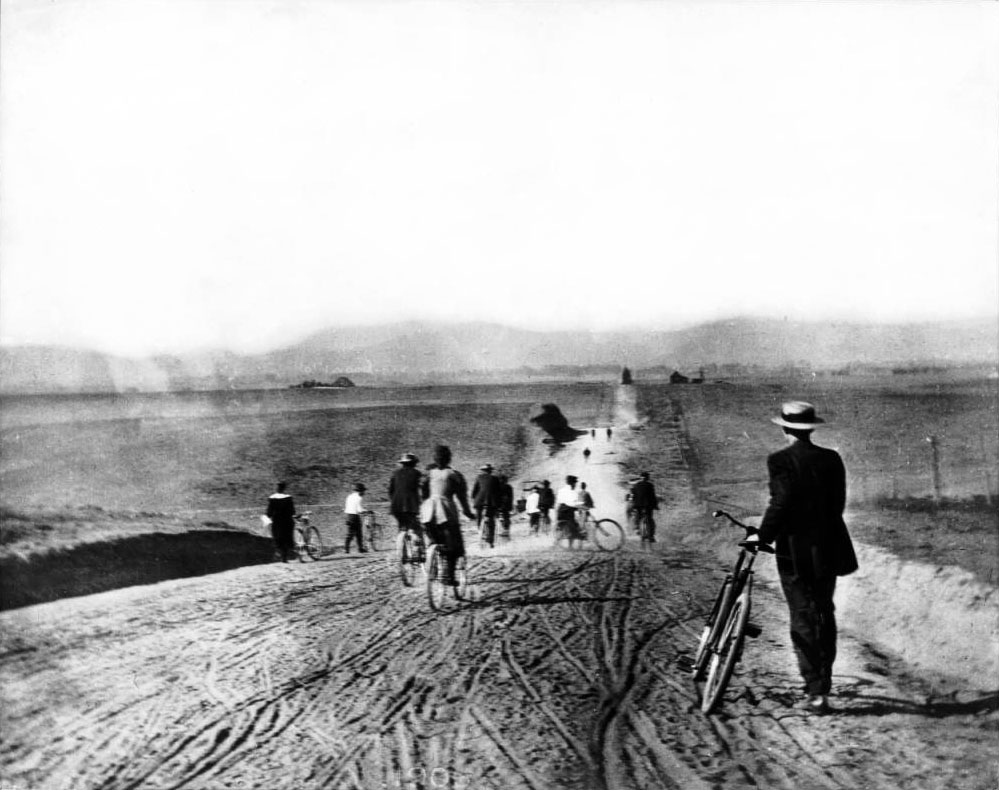 |
|
| (1895)^^ - View showing the Los Angeles Times Bicycle Club on Western Avenue north of Pico. |
Historical Notes Western Avenue, apart from Sepulveda Boulevard, is one of the longest north–south streets in Los Angeles. The name of the street is derived from its history as the westernmost border of Los Angeles before annexations in the early 20th century expanded the city. Western Avenue eventually ends north of Franklin Avenue in the Hollywood Hills. It swerves to become an east/west street, Los Feliz Boulevard.*^ |
Then and Now
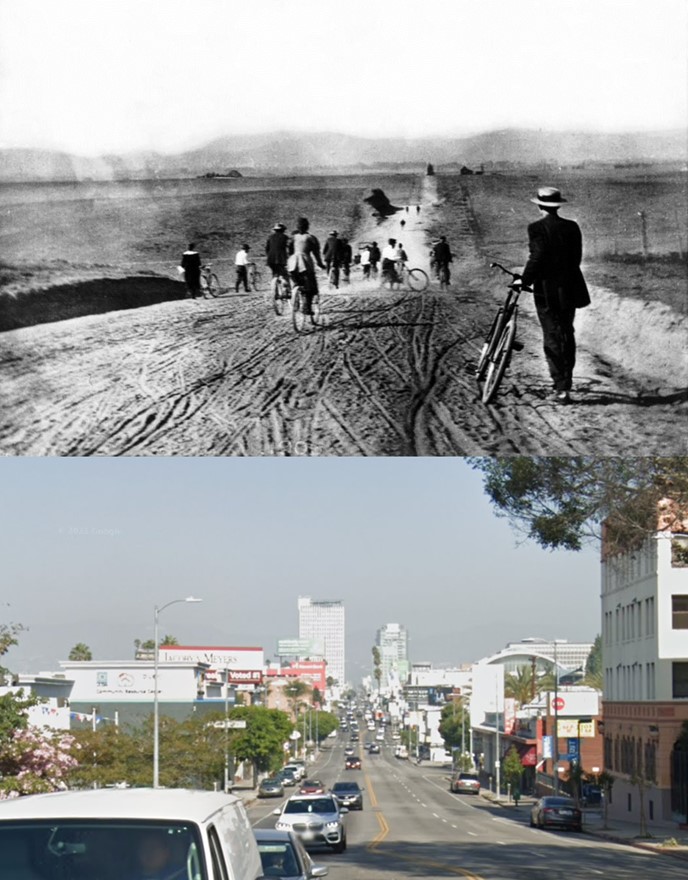 |
|
| (1895 vs. 2021)* - Western Avenue looking North from Pico Boulevard. Photo comparison by Jack Feldman. |
Western and Beverly
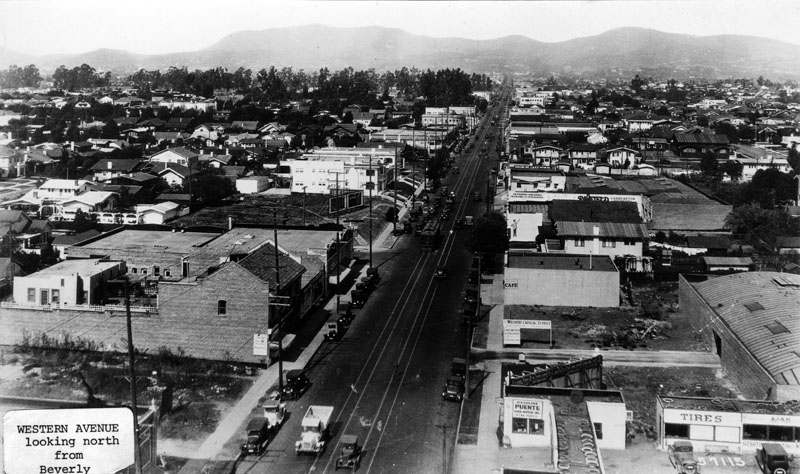 |
|
| (1920s)^ - View of Western Avenue, looking north from Beverly Blvd. toward the Hollywood Hills. Several businesses and automobiles can be seen along Western with residential homes riddling the rest of the view. |
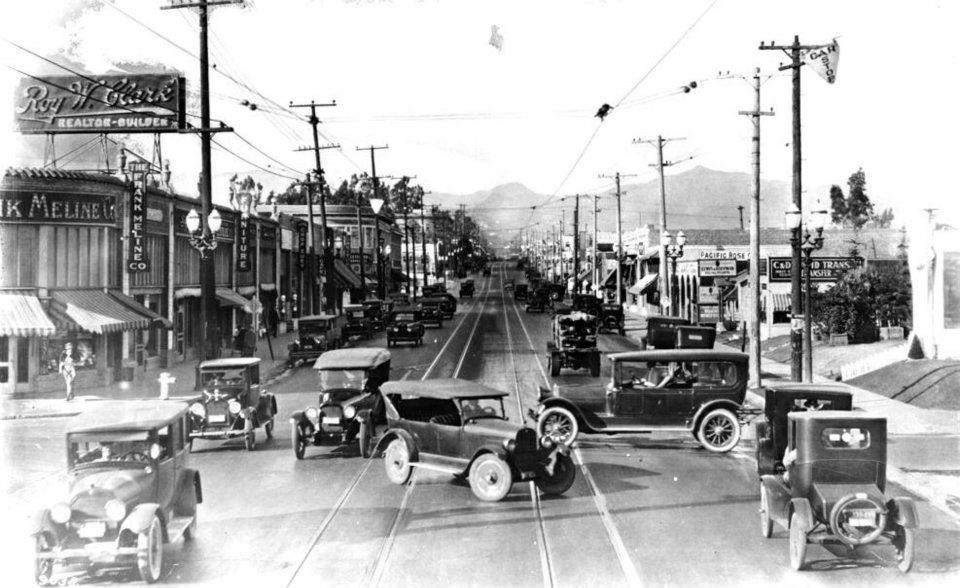 |
|
| (1924)^^ - View looking north on Western Avenue at Beverly Blvd. This intersection looks like its in need of a traffic signal. Note the unusual triangular sign attached to a power pole on the upper right. It reads: CAR STOP. |
Then and Now
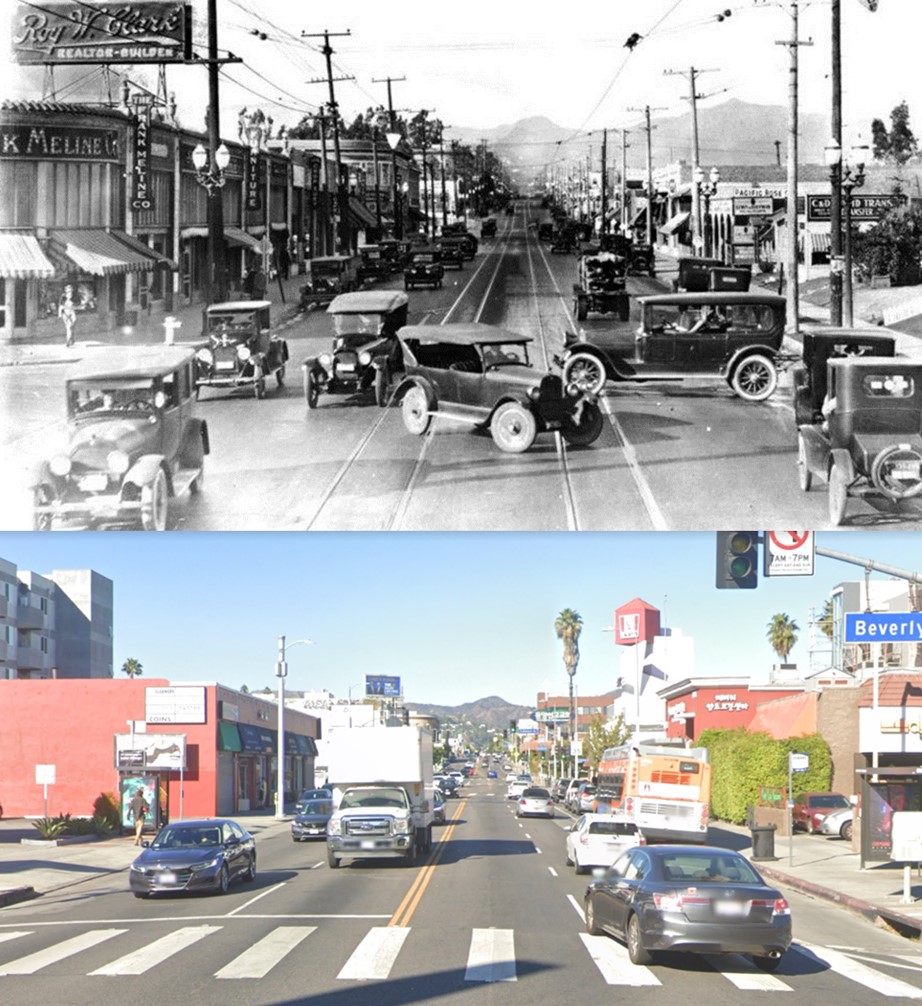 |
|
| (1924 vs. 2021)* – Looking north on Western Avenue at Beverly Boulevard. Photo comparison by Jack Feldman. |
Western and 1st
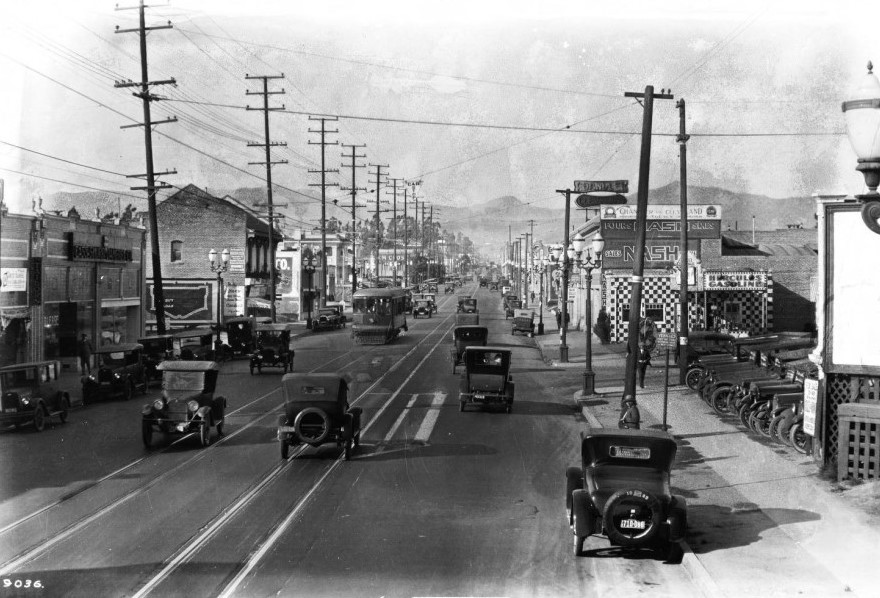 |
|
| (ca. 1924)^^ - View of Western Avenue looking north from 1st Street toward the Hollywood Hills. |
Western and 6th
 |
|
| (ca. 1924)^^ - View looking north on Western Avenue at 6th Street. |
Western and 7th
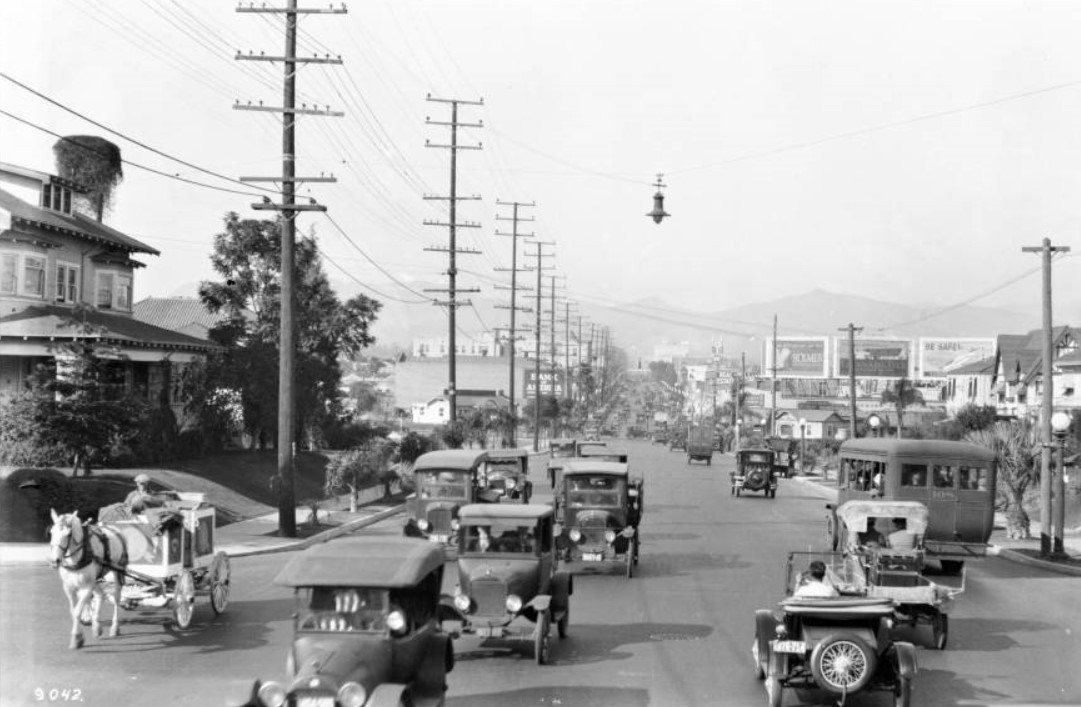 |
|
| (ca. 1924)* - View of Western Avenue looking north from 7th Street. Automobiles and a horse-drawn carriage make their way towards the viewer at left, while other traffic, a small bus amidst it, moves down the paved road to the right. |
Historical Notes Horses continued to march down (and foul up) Los Angeles streets well into the 1920s. Not until 1924 had the balance of power tilted to motorists such that city leaders felt comfortable banning horse-drawn vehicles from downtown during rush-hour -- a traffic-relief measure that remains on the books to this day.* |
Then and Now
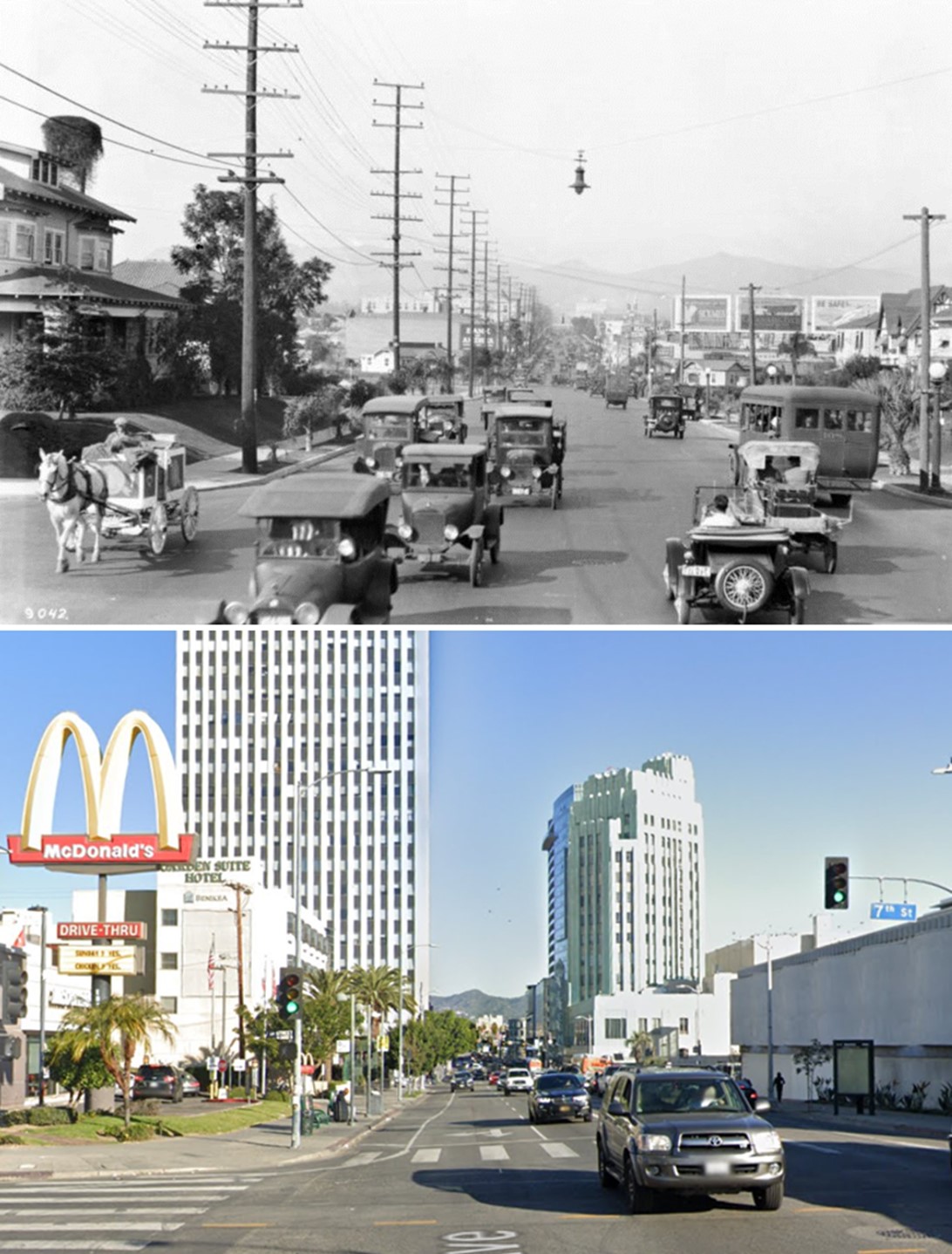 |
|
| (1924 vs 2023)* - Looking north on Western Avenue at 7th Street. Photo comparison by Jack Feldman. |
Western and Vernon
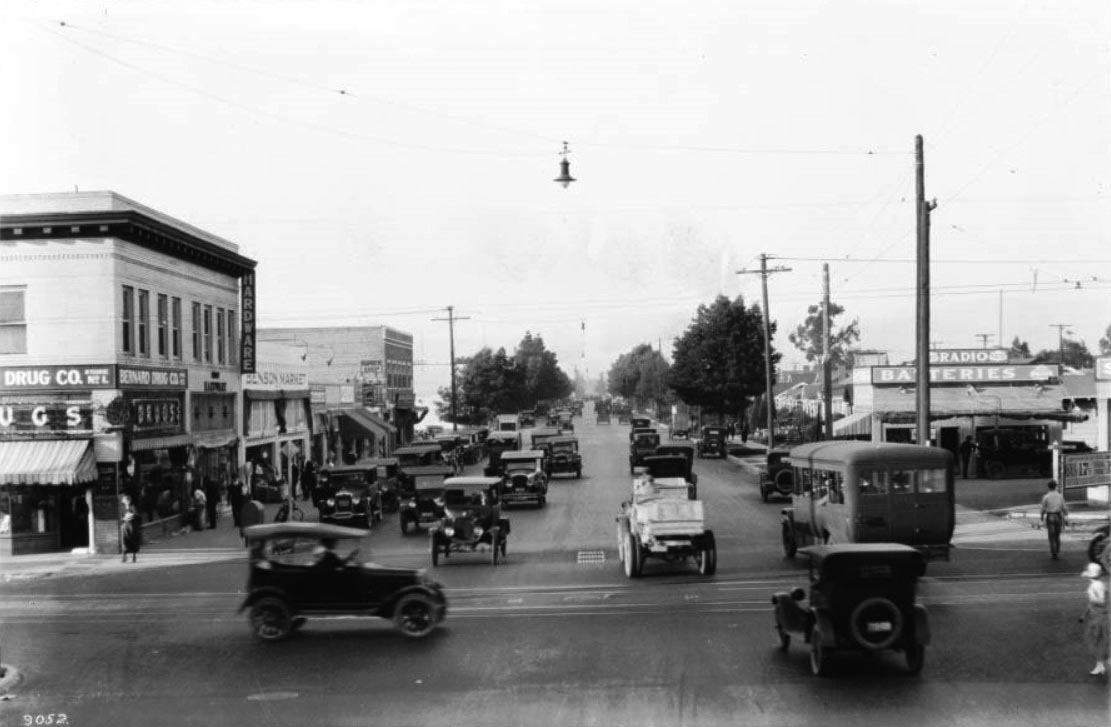 |
|
| (ca. 1924)^^ – View showing the intersection of Western and Vernon avenues. One automobile crosses the width of the image on Vernon, while the majority of the other autos, including a bus and a lightly-colored car, make their way up and down Western. On the corner to the left, the two-story brick building of the Bernard Drug Company can be seen, just in front of the Benson Market building, where pedestrians can be seen making their way along the sidewalk. More pedestrians can be seen crossing the intersection at the extreme right of the photo. Gas at the Gas Station on the right is going for 17 cents/gallon. Click HERE to see more early LA Gas Stations. |
Wilshire and Western
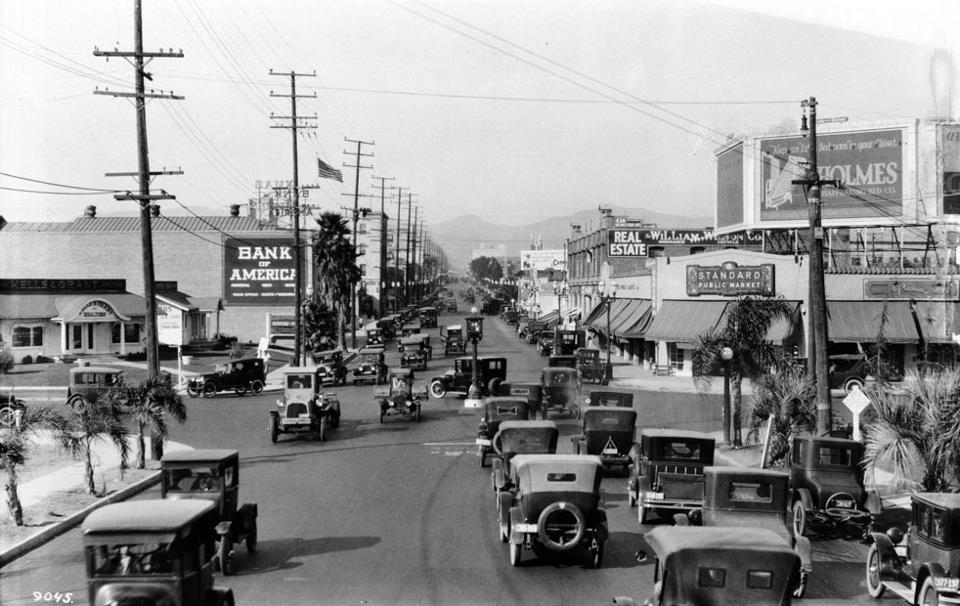 |
|
| (ca. 1924)^^ - Street view looking north on Western Avenue at Wilshire Boulevard. Note the traffic signal in the middle of the intersection. |
Historical Notes Los Angeles experimented by placing signals in the middle of a few of its busiest intersections. Nicknamed the “American Bobby” since it stood in the same place as a London traffic control officer, the new signal stood high atop a tall stanchion. Its location in the center of the intersection may have presented a traffic hazard, but the red and green lights, which replaced the unreliable semaphore arms, were easily visible to motorists in all four directions..*+* |
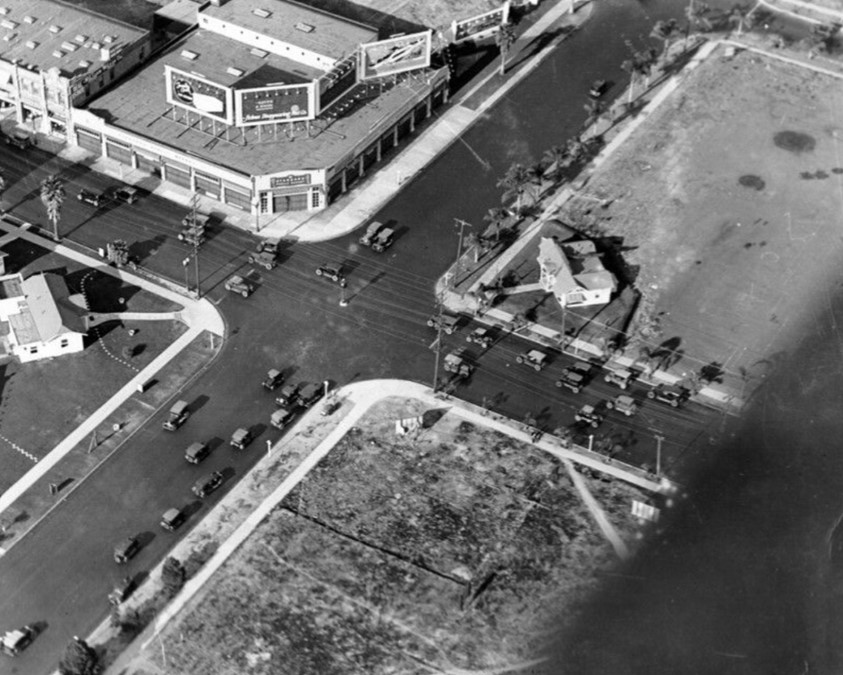 |
|
| (1924)^ - Aerial view of the intersection of Wilshire Boulevard (running bottom left to upper right) and Western Avenue with traffic signal in the middle of intersection. Both corners on the right side of the picture are so far undeveloped, although there is a real estate office on one corner. |
Historical Notes The Pellissier Building and Wiltern Theatre would be built in 1931 on the southeast corner of Wilshire and Western (upper-right), where the real estate office is locted. |
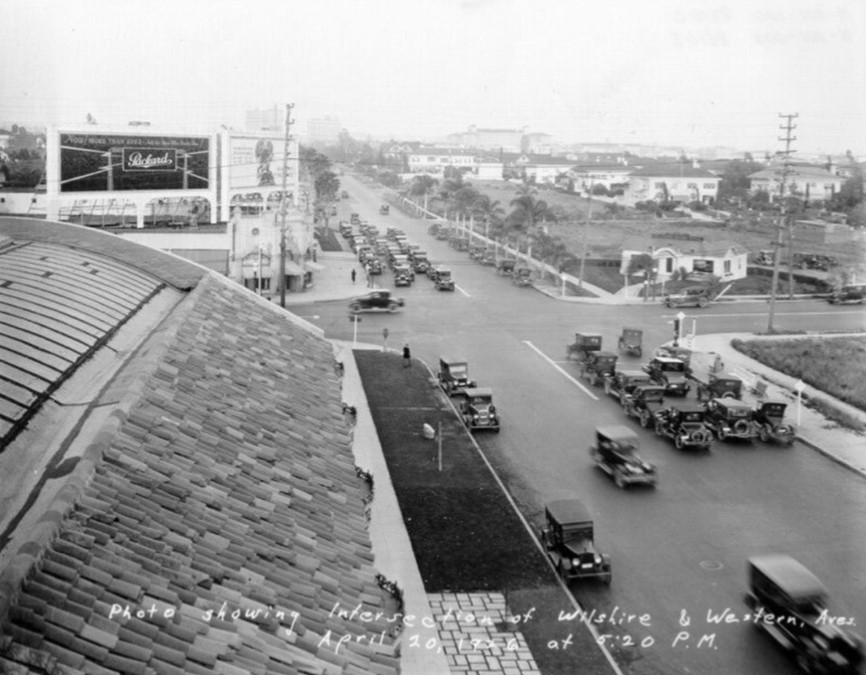 |
|
| (1926)^ – Rooftop view looking east on Wilshire Boulevard showing stopped cars while cross traffic on Western Avenue passes. Across the street on the S/E Corner (upper-right) stands a real estate office building. This will be the location of the Pellissier Building and Wiltern Theatre. |
.jpg) |
|
| (1926)^ - Street view looking east on Wilshire Boulevard from Western Avenue showing newly installed traffic signal. |
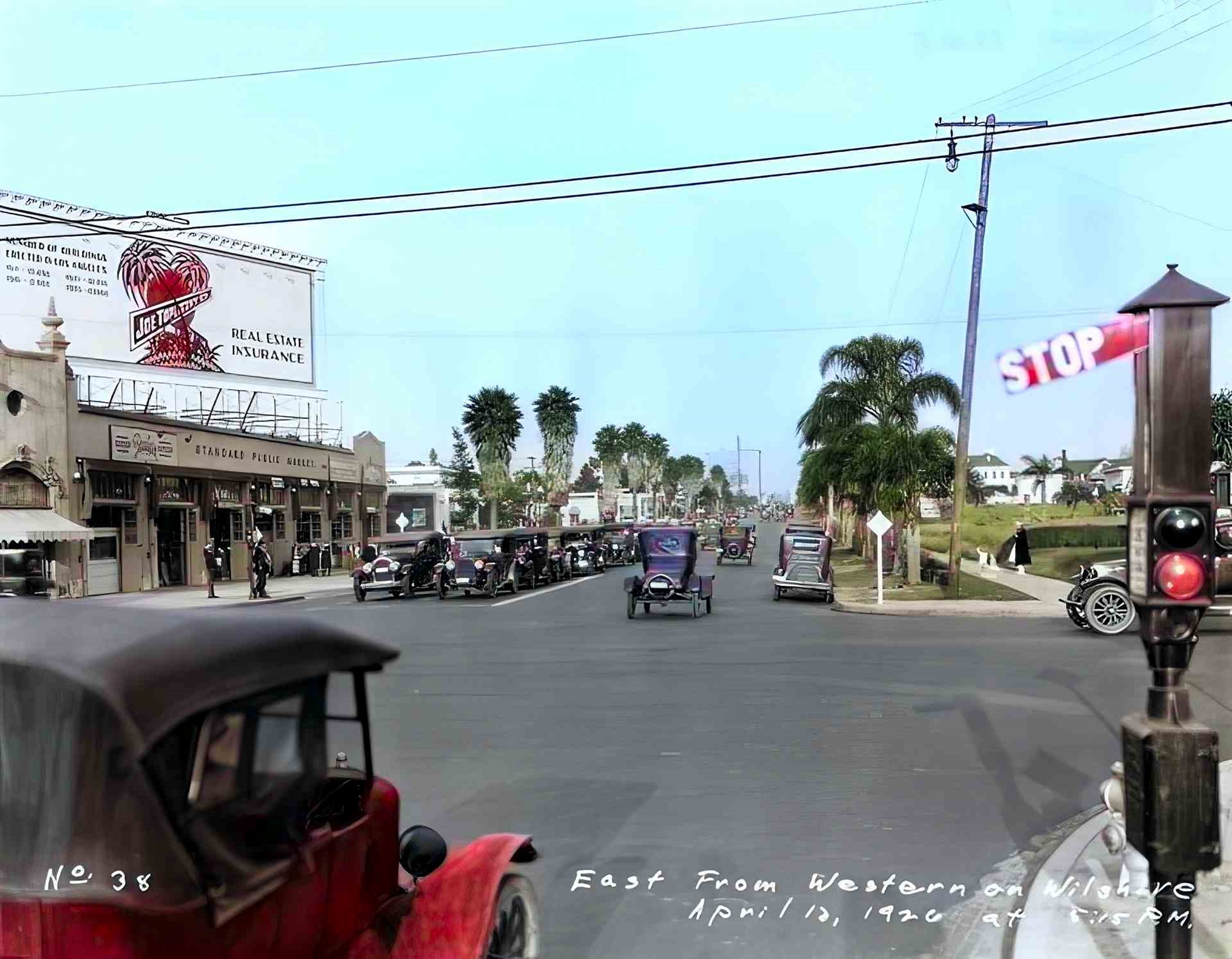 |
|
| (1926)^ - Street view looking east on Wilshire Boulevard from Western Avenue showing newly installed traffic signal. Image enhancement and colorization by Richard Holoff. |
Then and Now
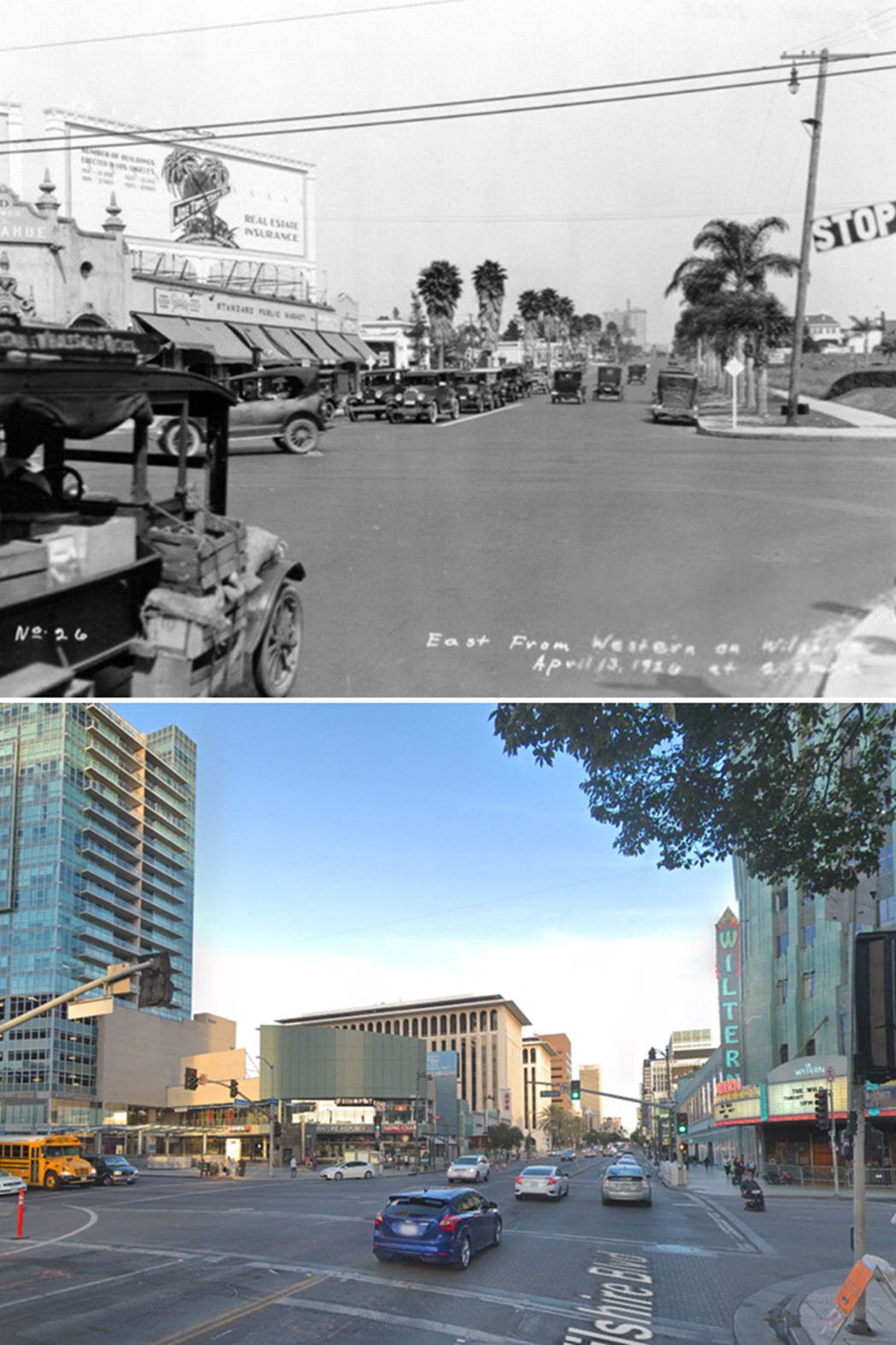 |
|
| (1926 vs 2017)* - Looking east on Wilshire Boulevard from Western Avenue. Photo comparison by Jack Feldman. |
.jpg) |
|
| (1926)^ - View looking west on Wilshire Boulevard at Western Avenue. Traffic is stopped whiule a pedestrian crosses Wilshire. |
Historical Notes By the 1930s and 1940s, Wilshire and Western would become the nation's busiest intersection, and the Miracle Mile would emerge as an important retail center.**# Click HERE to see more Early Views of the Wilshire and Western intersection (1929 - 1931). |
* * * * * |
 |
|
| (ca. 1924)^ - View showing the intersection of 3rd and Rampart with a billboard in the background advertising for Desmond’s Clothing Store. |
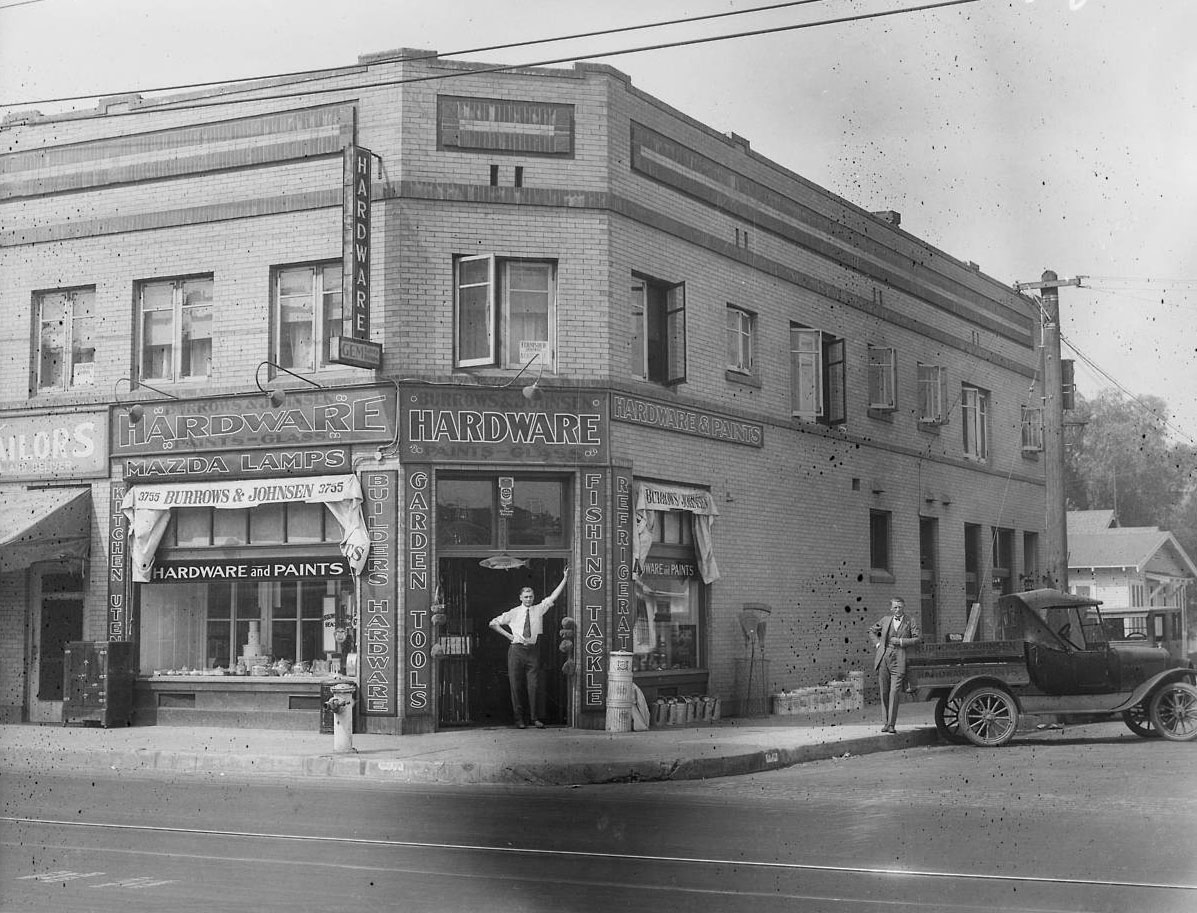 |
|
| (1924)^^ - View of a man standing in the doorway of Burrows & Johnson Hardware Store, at 3755 S. Vermont Ave. Another man is leaning on a truck parked diagonally against the curb. |
Historical Notes The Burrows & Johnson Store on the corner of 37th St. and Vermont Ave. was one of many businesses lining Vermont near the University of Southern California (USC). A tailor’s shop is seen next door. This building and the house behind it are now a gravel empty lot.^*#* |
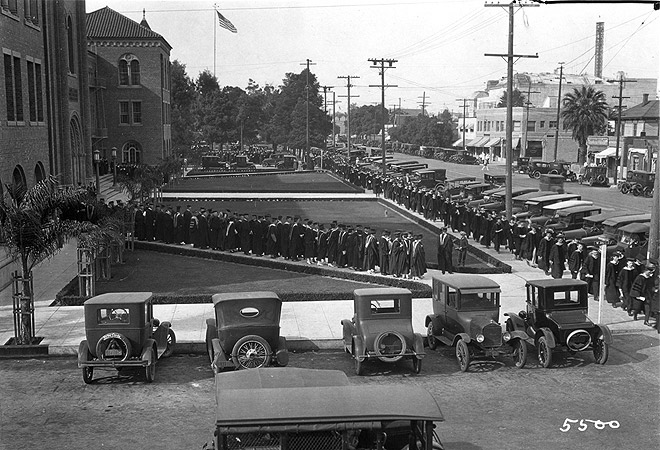 |
|
| (1925)^*#* - View from the USC Student Union building, looking north at Bovard and University Avenue (now Trousdale). |
Historical Notes Behind the line of graduates can be seen some of University Avenue before USC took over. There is a row of stores along the street, and the roof of the Shrine Auditorium is visible in the background. The two story commercial building on the corner is now where Von Kleinsmid Center is located.^*#* |
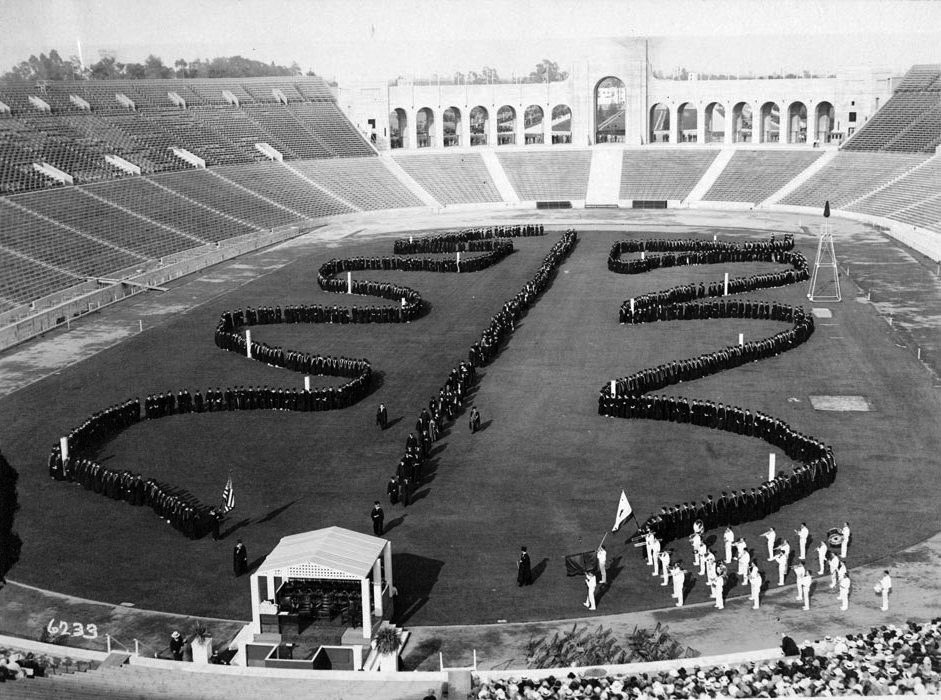 |
|
| (1926)^^ -- View of the USC Academic Serpentine of '26 at the Los Angeles Memorial Coliseum. The President, deans and faculties advance through the rows of graduates who are about to receive their diplomas in the stadium, June 5th, 1926 |
Historical Notes Click HERE to see more in Early Views of USC |
Rancho La Cienega O' Paso de la Tijera
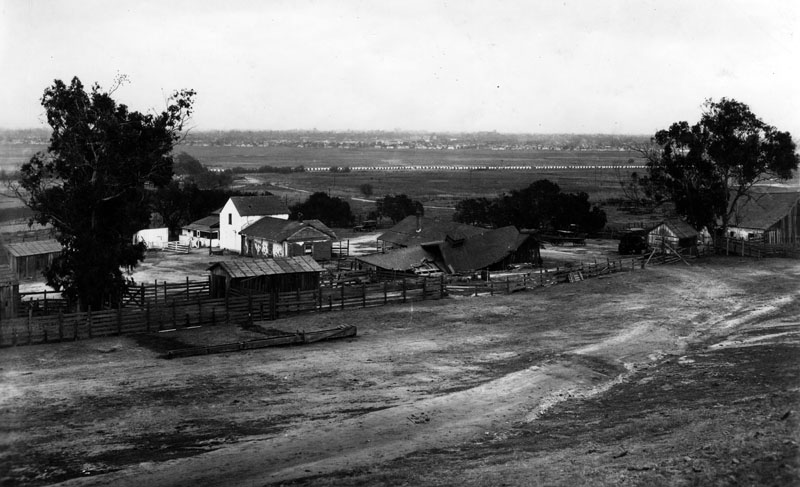 |
|
| (1924)^ - Panoramic view of Rancho Cienega O' Paso de la Tijera located on the 2400 block of S. Crenshaw Boulevard in the Baldwin Hills area, looking east. It shows an adobe, as well as several small buildings and a few trees, clustered inside a fenced-in area. |
Historical Notes Rancho La Cienega O' Paso de la Tijera was a series of adjoining adobe structures located on the eastern side of the Baldwin Hills in an area determined to be approximately 4,481 acres. The unusual title of the Rancho is actually two names combined: "La Cienega" ("The Swamp"), refers to the marshes in the area between Baldwin Hills and Beverly Hills; the latter half of the name "Paso de la Tijera" ("Pass of the Scissors"), was a name used by the early Spanish to describe the pass through the nearby hills that resembled an open pair of scissors.^ |
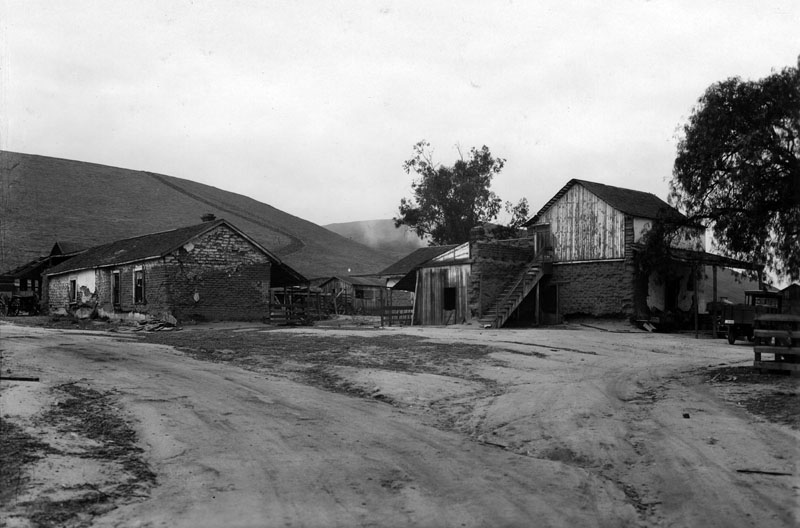 |
|
| (1924)^ - View of Rancho Cienega O' Paso de la Tijera shows two adobes, a single-story on the left, and a two-story on the right; another smaller building is visible in the background between the adobes. |
Historical Notes The Rancho La Cienega O' Paso de la Tijera area remained unclaimed for many years following the first Spanish settlements in California. Squatters from the pueblo considering these lands public and built the La Tijera adobe as early as 1790 or 1795 for the purpose of raising cattle on surrounding land. In 1843, Manuel Michaeltorrena (then Mexican Governor of Alta California) formally granted Rancho La Cienega O' Paso de la Tijera to Vicente Sánchez. In more recent years, a portion of Rancho La Cienega O' Paso de la Tijera became the center of Sunset Fields public golf links located at 3725 Don Felipe Drive, off Crenshaw Boulevard. In 1959, Bernadette Fathers sold the property to Park View Women's Club.^ Rancho La Cienega O' Paso de la Tijera was declared Los Angeles Historic-Cultural Monument No. 487 on May 1, 1990 (Click HERE to see complete listing). |
Click HERE to see more Early Views of Rancho La Cienega O' Paso de la Tijera |
* * * * * |
Olympic and La Cienega
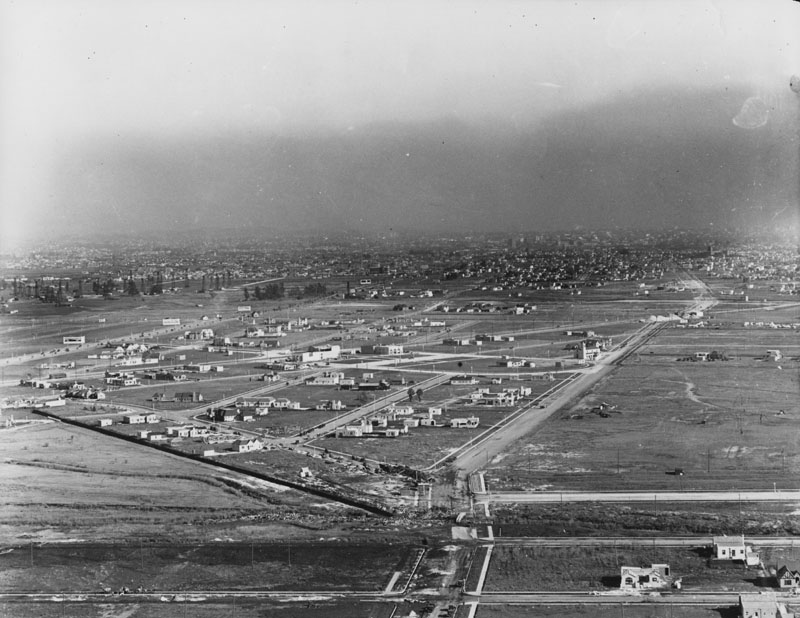 |
|
| (1924)^ - Aerial view looking east from Western, towards Olympic Boulevard, La Cienega and Carthay Circle. |
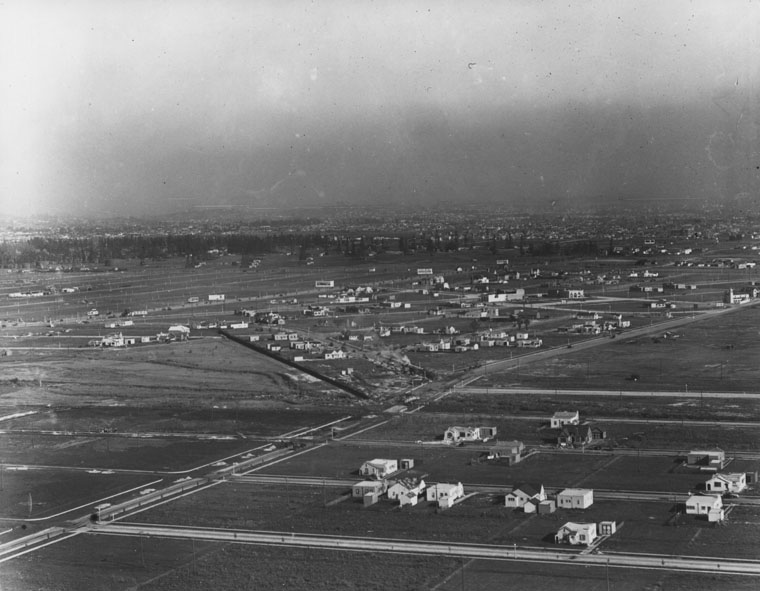 |
|
| (1924)^ - Another aerial view looking east from Western, towards Olympic Boulevard, La Cienega and Carthay Circle. |
Beverly Hills
.jpg) |
|
| (ca. 1924)^ - A panoramic view of Beverly Hills and neighboring cities, seen from an airplane. Especially noticeable is an area where 6 roads all meet. To the left of that intersection the Beverly Hills Hotel can be seen. |
Historical Notes Two years before Beverly Hills became an incorporated city, the Beverly Hills Hotel opened on May 12, 1912; the hotel initially included the main building and twenty-three separate bungalows in the Mediterranean Revival style, designed by Elmer Grey. In the 1940s, a new wing was added to the east side of the main building. Eighty years after it opened, the hotel closed for two and a half years for a complete restoration. The hotel was named the first historic landmark in Beverly Hills on September 12, 2012.^ |
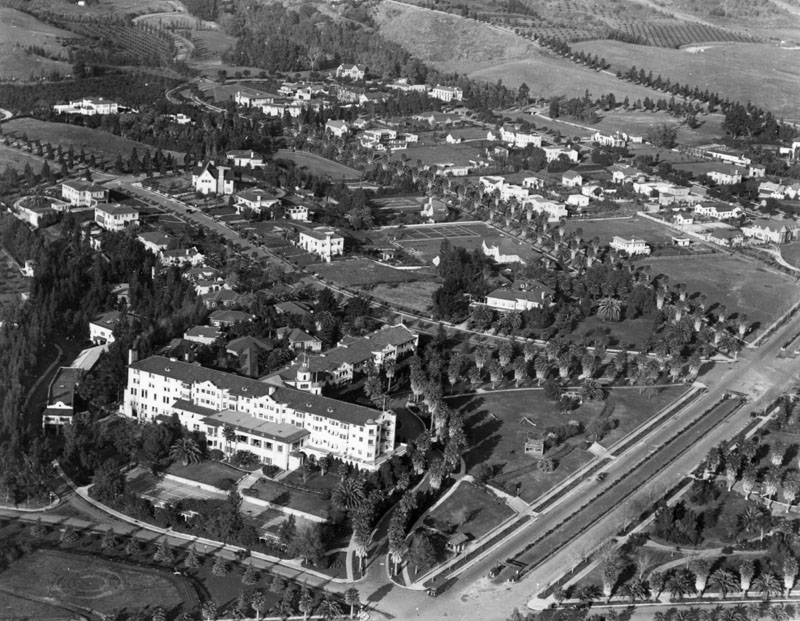 |
|
| (ca. 1924)^ - Aerial view of Beverly Hills, with the Beverly Hills Hotel in the foreground, located on Sunset Blvd. A number of homes have been built in the development. Elmer Grey was the architect of the hotel, built in Mission Revival style in 1911-1912. |
Click HERE to see more Early Views of Beverly Hills. |
San Pedro Harbor
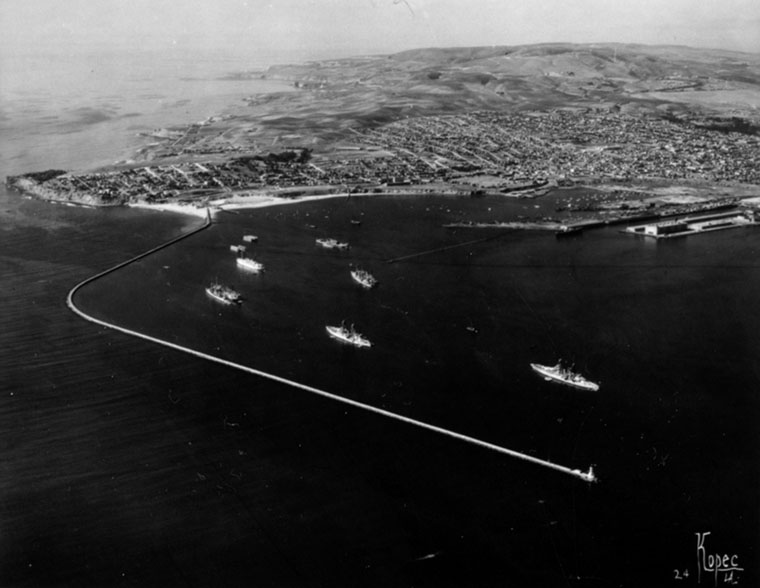 |
|
| (ca. 1924)^ - Aerial view of Point Fermin, Palos Verdes and hills, government breakwaters and the outer harbor. Ships can be seen in the harbor. |
Historical Notes After the Panama Canal opened in 1914, the Port of Los Angeles became the natural port-of-call for most transpacific and coastal users. |
Click HERE to see more in Early Views of San Pedro and Wilmington |
* * * * * |
Palos Verdes Peninsula and South Bay Area
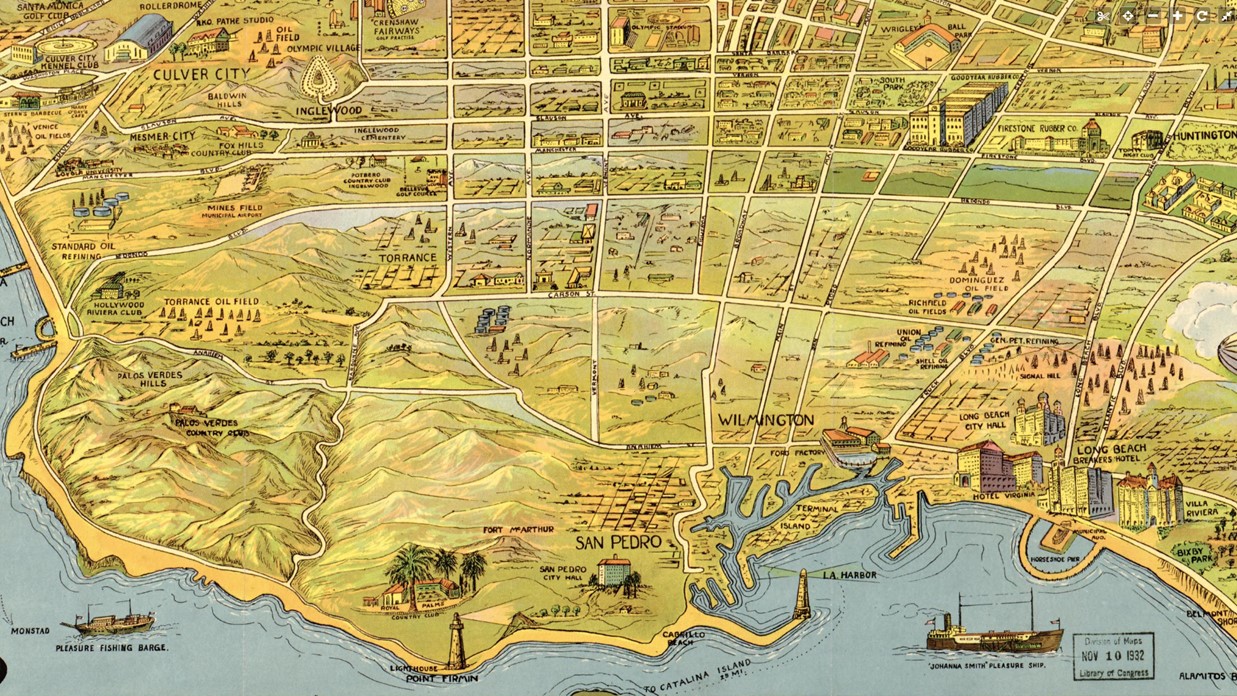 |
|
| (1932)*– Map highlighting key points of interest in the South Bay area of Los Angeles County. |
Historical Notes This 1932 map captures the South Bay region at a moment when its modern identity was still taking shape. The area includes the Beach Cities of Hermosa Beach, Manhattan Beach, and Redondo Beach, the Palos Verdes Peninsula communities of Palos Verdes Estates, Rancho Palos Verdes, Rolling Hills, and Rolling Hills Estates, the harbor districts of San Pedro, Wilmington, and Harbor City, and inland cities such as Torrance, Gardena, Hawthorne, Inglewood, and Carson. At the time this map was produced, much of the land shown was either newly subdivided or still agricultural. The ports of Los Angeles and Long Beach were expanding rapidly, aviation was emerging in El Segundo and Hawthorne, and the Palos Verdes Peninsula was being carefully developed as one of Southern California’s earliest master planned communities, distinct from the more industrial growth taking place closer to the harbor. |
 |
|
| (1923)* – Bird’s eye view of the Southland showing the beachfront communities between Santa Monica and Long Beach. |
Historical Notes This 1923 bird’s eye view illustrates how lightly developed the coastline still was between Santa Monica and Long Beach in the early twentieth century. Large stretches of open land separate the growing city of Los Angeles from the ocean, underscoring how recent coastal urbanization truly is. Roads are sparse, and many of the communities that would later become densely populated beach cities appear only as small clusters of buildings. At the left edge of the image is a proposed site for a new university on the Palos Verdes Peninsula. This location was seriously considered as a possible campus for the Southern Branch of the University of California, which later became UCLA. Ultimately, concerns about accessibility and transportation led planners to choose the Westwood site instead, leaving the Palos Verdes land to develop along residential and recreational lines. |
* * * * * |
Palos Verdes Peninsula
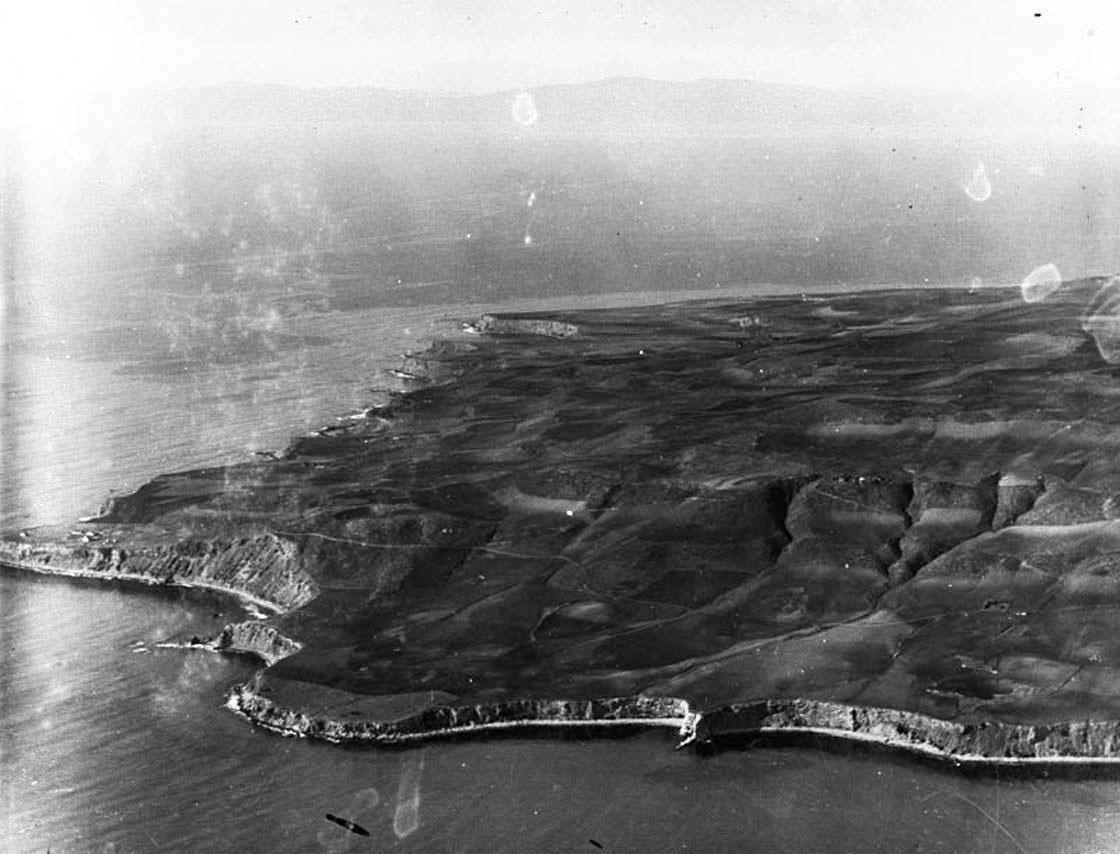 |
|
| (ca. 1920)* - Aerial view looking north across the Palos Verdes Peninsula. |
Historical Notes The Palos Verdes Peninsula derives its name from Spanish words meaning green sticks, a reference to the vegetation noted by early explorers. Long before European settlement, the peninsula was home to the Tongva Gabrielino people, who lived throughout the Los Angeles Basin for thousands of years. Archaeological evidence in the region dates back as much as 8000 years. This early aerial view shows the peninsula largely untouched by modern development. Its steep coastal bluffs, rolling hills, and isolation from the Los Angeles plain made it both difficult to access and attractive to later planners seeking to preserve open space, natural beauty, and a distinct identity separate from the growing city below. |
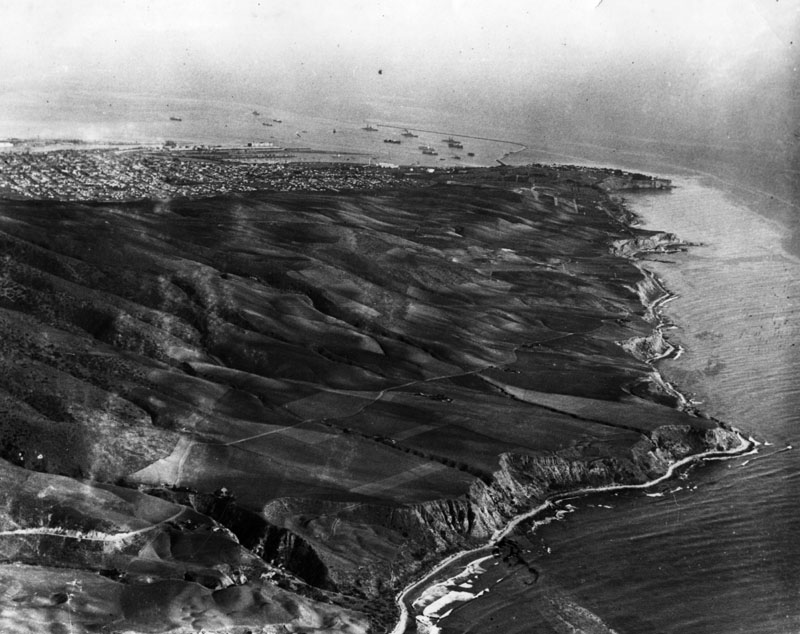 |
|
| (1924)* - Aerial view of the Palos Verdes Peninsula looking southeast toward Point Fermin, with San Pedro Harbor in the distance. |
Historical Notes In 1882, ownership of the Rancho de los Palos Verdes passed to Jotham Bixby, who used the land primarily for cattle ranching. Portions of the ranch were leased to Japanese farmers, who introduced agriculture and built some of the earliest roads on the hill. In 1894, Bixby’s foreman Harry Phillips constructed the first permanent residence and planted eucalyptus trees that still shape the landscape today. In 1913, Bixby sold the ranch to Frank A Vanderlip, a New York banker who envisioned one of the nation’s first comprehensively planned communities. Vanderlip divided the land into estates, emphasized preservation of natural contours, and proposed amenities such as a grand golf club and coastal parklands. Development in Malaga Cove began in the early 1920s, and in 1923 the La Venta Inn became the first completed structure on the peninsula. |
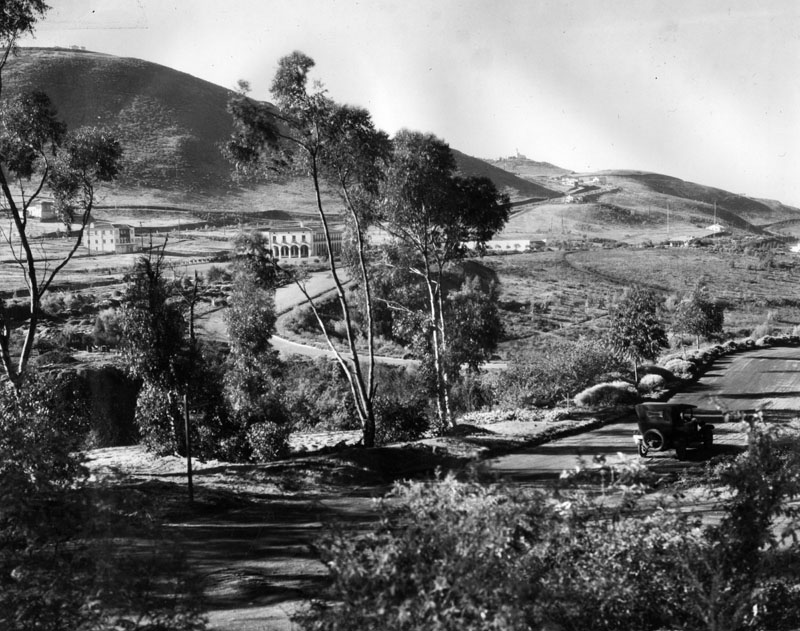 |
|
| (1923)* - Panoramic view from Palos Verdes Drive North looking southwest toward early construction at Malaga Cove |
Historical Notes This panoramic view shows the earliest stages of development in Malaga Cove, the civic and cultural heart of Palos Verdes Estates. Roads curve gently with the terrain, reflecting the planners’ intention to work with the natural landscape rather than impose a rigid street grid. The Malaga Cove Plaza, library, and surrounding homes were designed to form a cohesive village center rather than a commercial strip. This approach set Palos Verdes apart from much of Southern California development and helped establish its enduring character as a carefully curated residential community. |
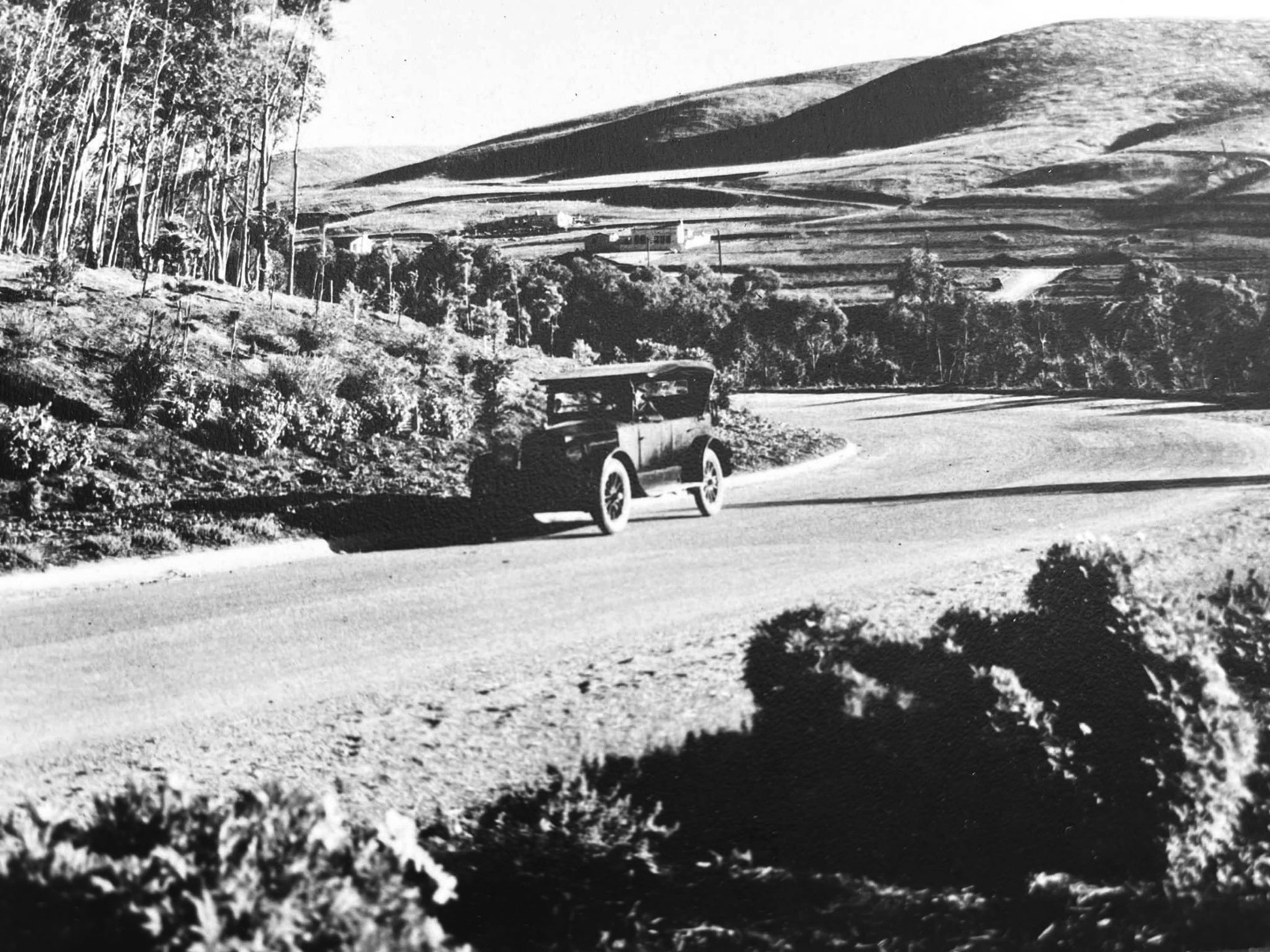 |
|
| (ca. 1925)* - View toward the Malaga Cove Plaza area from the origin of Palos Verdes Drive North. |
Historical Notes By the mid 1920s, Malaga Cove was clearly emerging as the peninsula’s focal point. From this vantage point, the gently rising road leads the eye toward what would become the civic core of Palos Verdes Estates. The future site of St Francis Episcopal Church lies just beyond the right edge of the image. This area was intentionally designed to concentrate public life in one place, with schools, churches, shops, and gathering spaces located within walking distance, reinforcing the sense of a small, self contained village. |
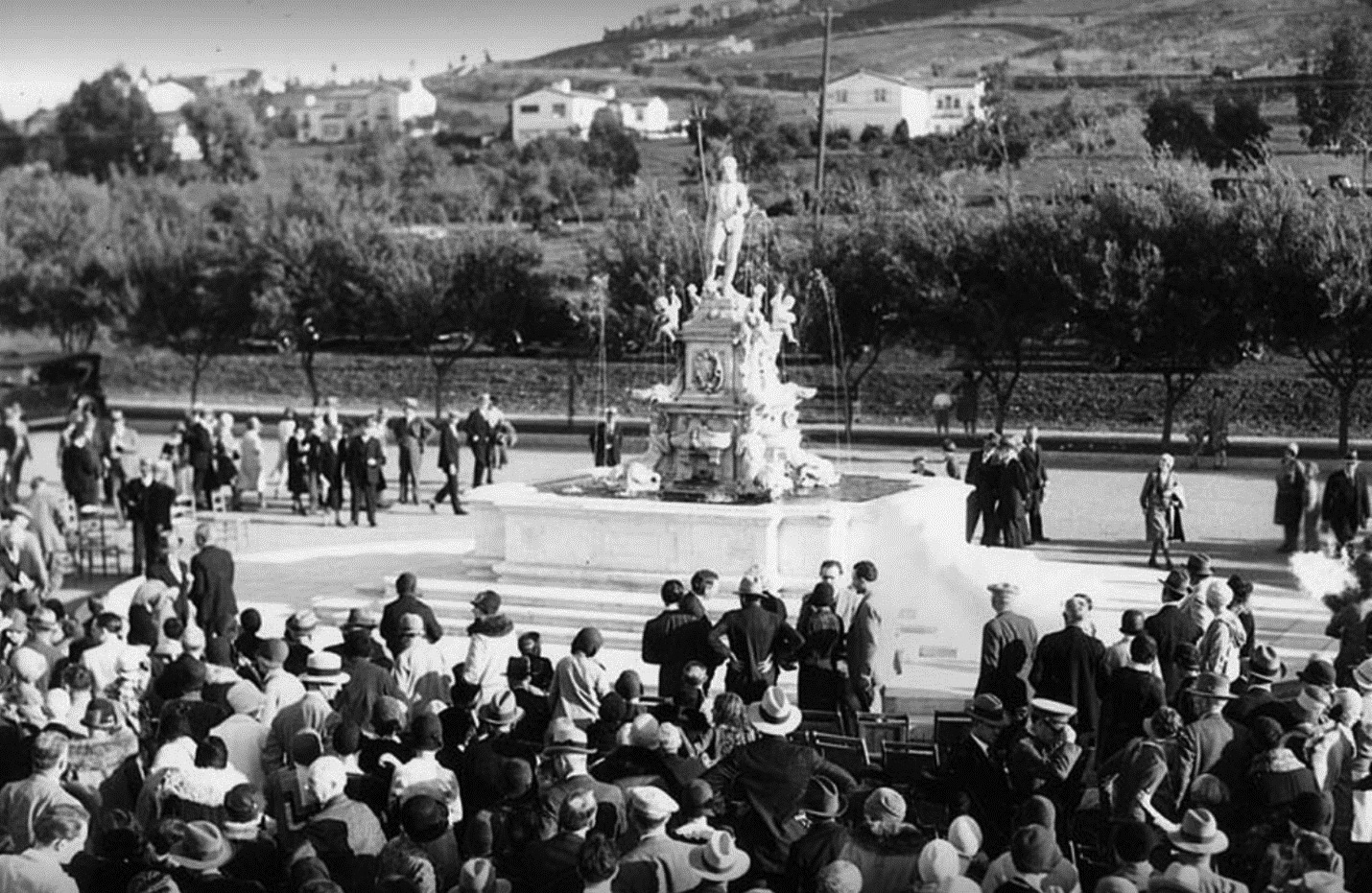 |
|
| (ca. 1928)* - Dedication ceremony for the fountain at Malaga Cove Plaza. |
Historical Notes The dedication of the fountain marked a symbolic milestone in the development of Palos Verdes Estates. Placed at the center of Malaga Cove Plaza, the fountain became an instant visual and social anchor for the community. Its installation reinforced the planners’ goal of blending European inspired civic design with Southern California’s coastal setting, giving the young city a sense of history and permanence from its earliest years. |
 |
|
| (ca. 1937)* - Close up view of the marble fountain at the center of Malaga Cove Plaza. |
Historical Notes The white marble fountain is a replica of a famous Neptune fountain in Bologna, Italy. Decorated with dolphins, shells, and a mermaid, it is crowned by Neptune, the Roman god of the sea, gazing outward toward the Pacific Ocean. Originally part of a private European villa, the fountain was donated to Palos Verdes Estates in 1930. Over time it became one of the most recognizable landmarks on the peninsula and was carefully restored in 1997 to preserve its detail and craftsmanship. |
Then and Now
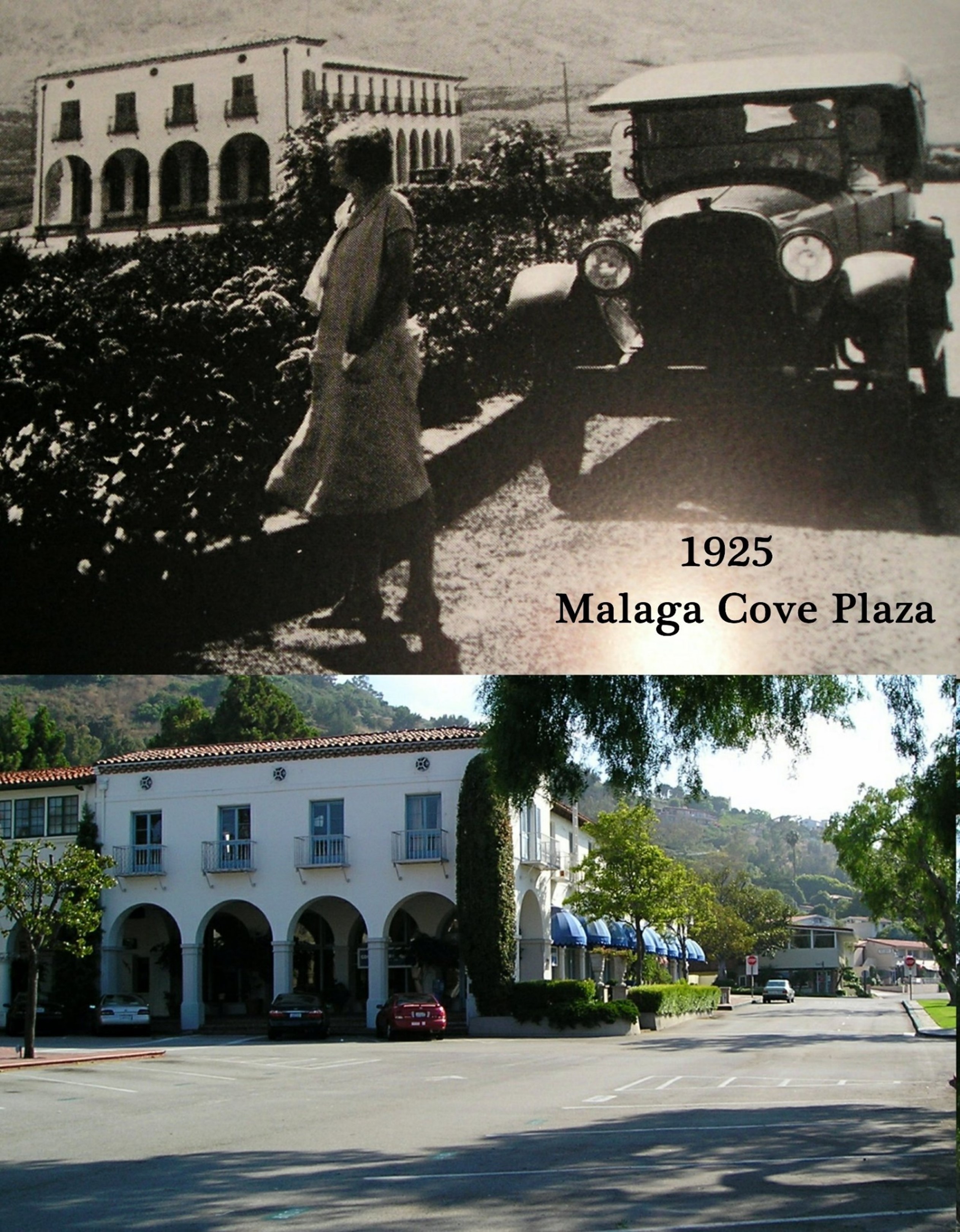 |
|
| (Then and Now)* - Malaga Cove Plaza |
Historical Notes This then and now comparison shows how Malaga Cove Plaza matured from a lightly built early village center into the established heart of Palos Verdes Estates. In the 1925 era view, the landscape is still open and the plaza area feels new and spacious, with surrounding hillsides largely undeveloped and the road network still settling into its final form. The image captures the early planning idea behind Palos Verdes: a walkable civic core set within a carefully protected natural setting. In the modern view, the plaza reads as a fully formed community landmark. The central fountain and the Mediterranean style buildings help preserve the original village character even as trees, landscaping, and decades of daily use have softened the scene. What stands out most is continuity: the plaza remains the same gathering place it was intended to be, offering a sense of permanence in a region that changed dramatically everywhere else. |
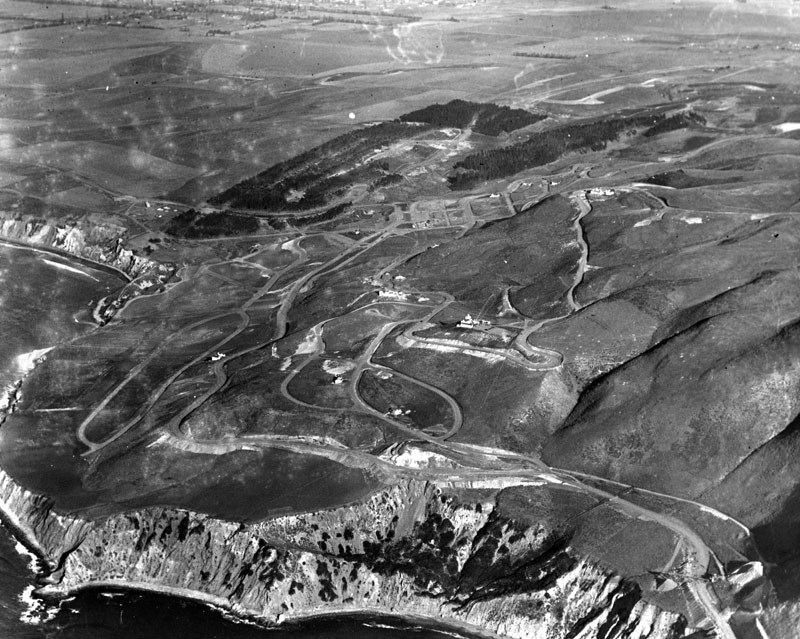 |
|
| (1925)* - Aerial view of the Palos Verdes Peninsula showing limited development. |
Historical Notes This 1925 aerial photograph emphasizes how little of the peninsula had been developed just a few years after construction began. Vast areas of open land dominate the scene, with only a handful of roads and buildings visible. The image reflects the deliberate pace of development imposed by planners, who sought to avoid overbuilding and preserve views, open space, and the natural relationship between land and sea. |
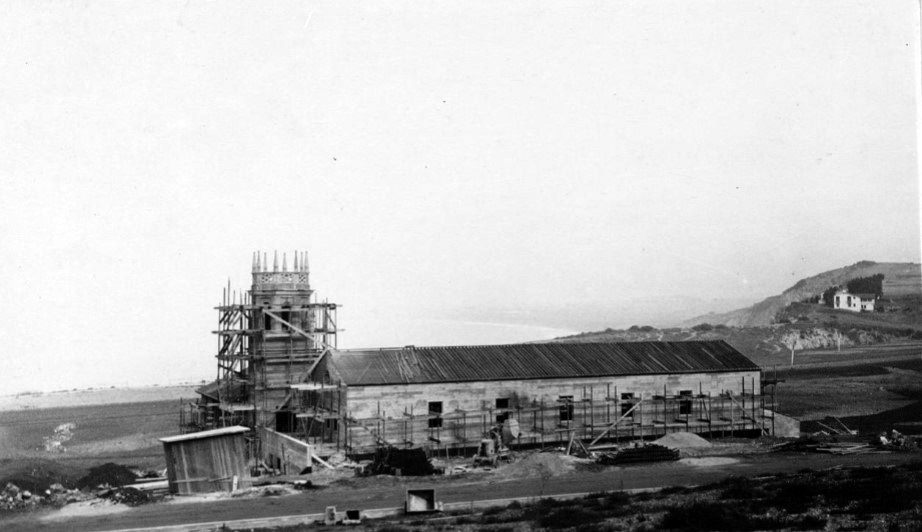 |
|
| (1926)* – Panoramic view showing construction of Malaga Cove School at 385 Via Almar. |
Historical Notes Malaga Cove School opened on April 5, 1926, serving as both an educational facility and a community center. By its opening, the school accommodated 35 students and three teachers, with classrooms, an auditorium seating nearly 300, offices, and community spaces. From the beginning, the school was designed to be more than a place of instruction. It functioned as a gathering place for meetings, performances, and civic events, a role it continues to serve today as one of the peninsula’s most important community institutions. |
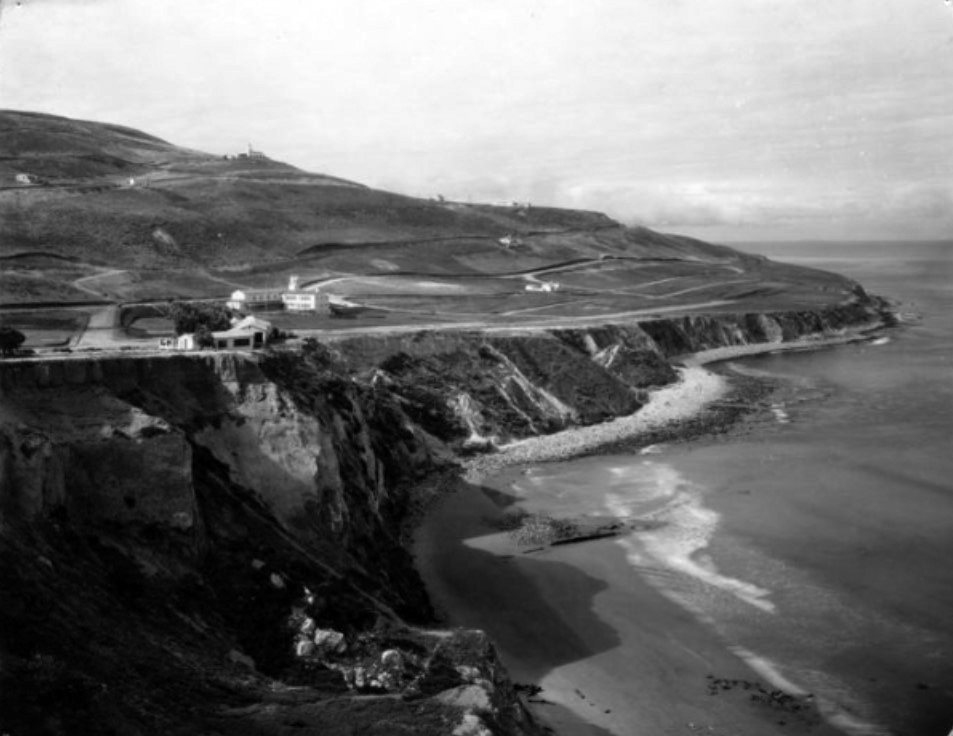 |
|
| (1925)* – Elevated view looking south with the Frederick Law Olmsted Jr residence at left, Malaga Cove School beyond, and La Venta Inn on the hilltop. |
Historical Notes The residence of Frederick Law Olmsted Jr stood prominently on Rosita Place, overlooking the cliffs of Malaga Cove. Olmsted, a leading landscape architect and planning consultant for Palos Verdes, lived briefly on the peninsula while shaping its early design philosophy. The house was demolished in 1971 due to bluff erosion, a reminder of the ongoing tension between development and the peninsula’s dynamic coastal geology. |
* * * * * |
Palos Verdes Peninsula: Then and Now
 |
|
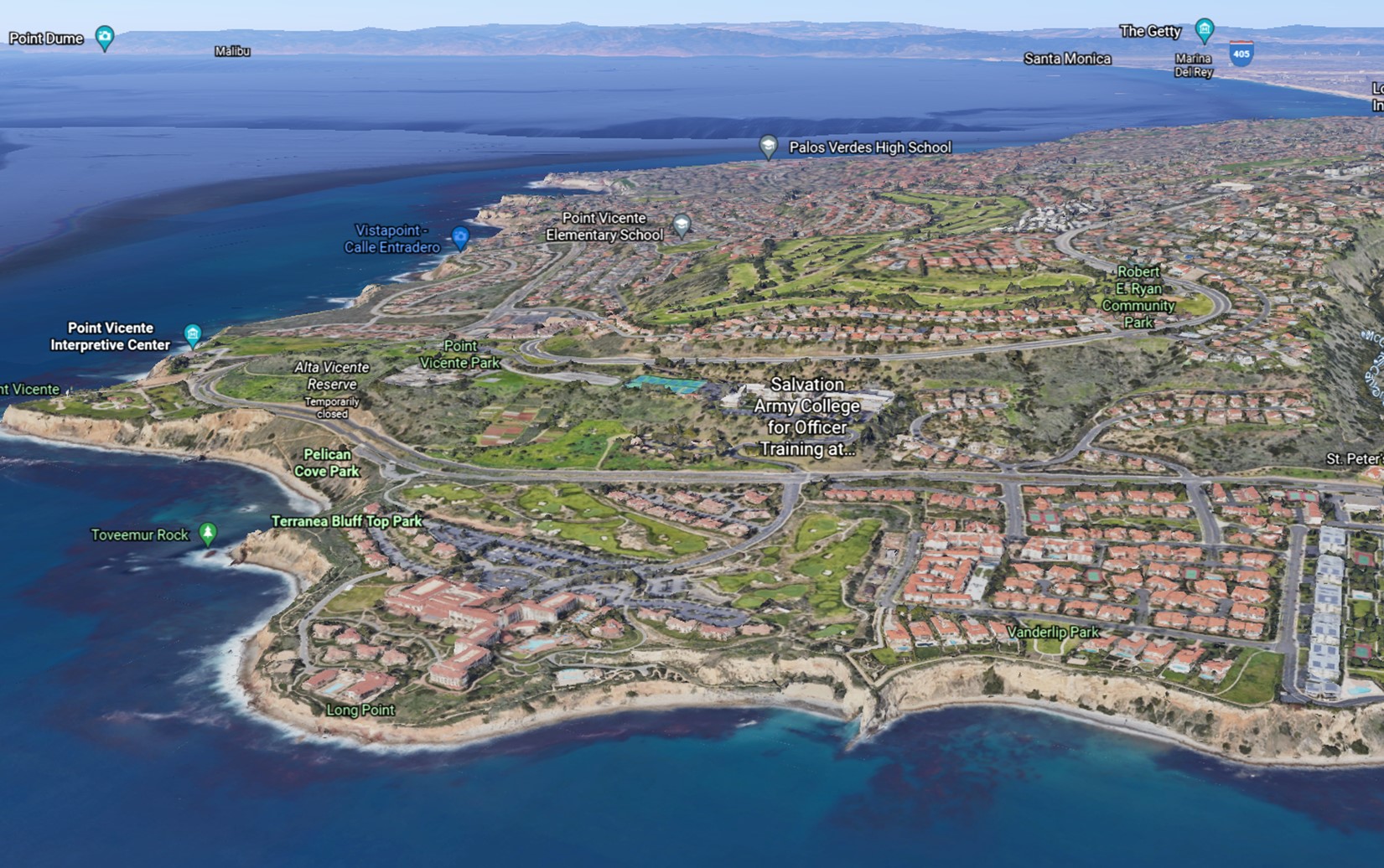 |
|
| (1920 vs. 2021) - Palos Verdes Peninsula. Photo comparison by Jack Feldman |
Historical Notes In the 1920 image, the Palos Verdes Peninsula appears largely undeveloped, with open hillsides and only a small network of roads and structures visible. The land dominates the scene, and the separation from the Los Angeles Basin below is clearly defined. This view reflects the peninsula before widespread residential growth began. The modern image reveals a fully developed but carefully controlled landscape. Homes, streets, and mature landscaping now occupy much of the peninsula, yet open space and coastal views remain protected. The comparison highlights how development followed the original intent to preserve natural contours rather than overwhelm them. |
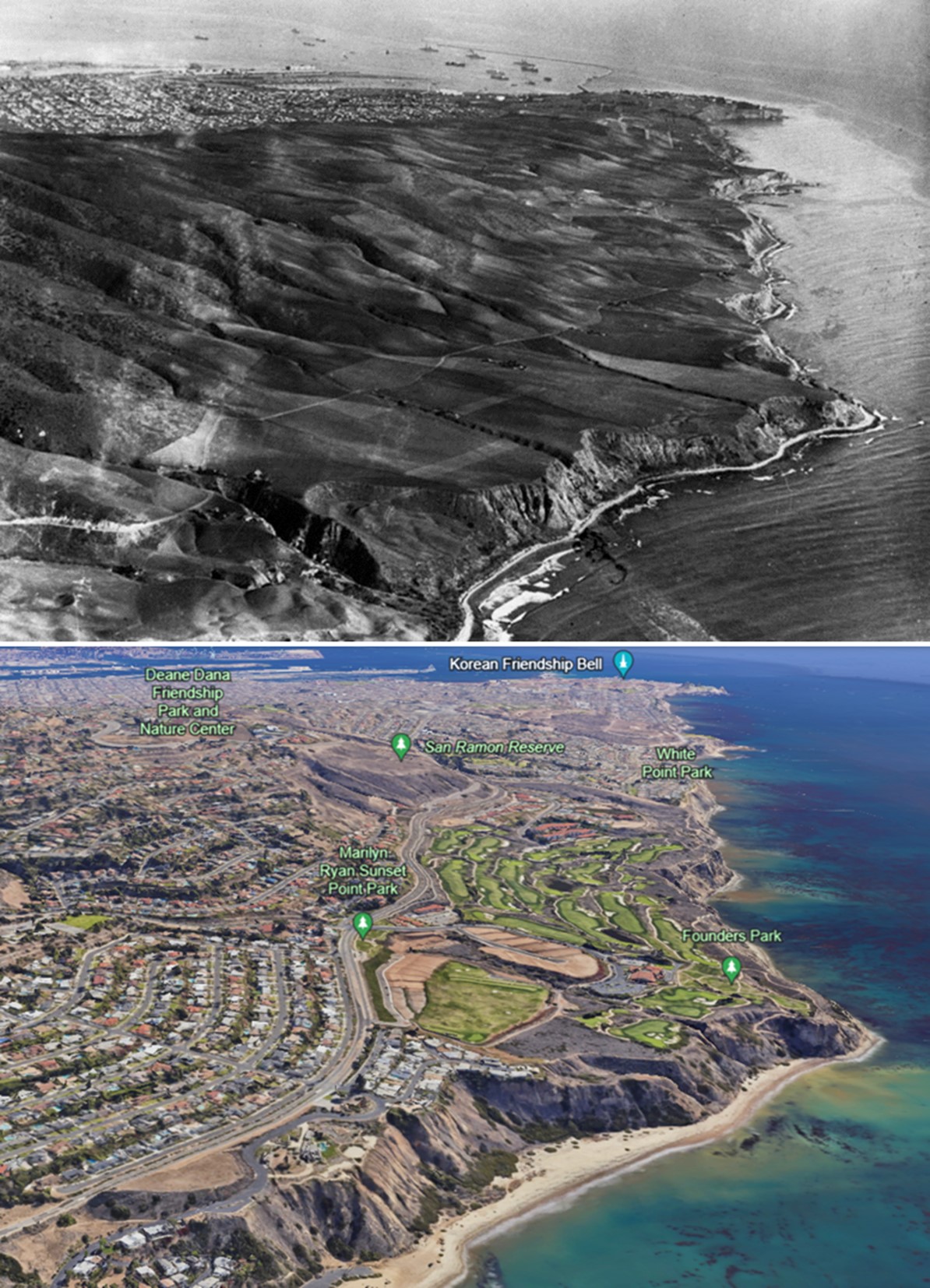 |
|
| (1924 vs 2023)* - Palos Verdes Peninsula, looking southeast towards Point Fermin with San Pedro Harbor seen in the distance. Portuguese Bend is at lower right. Photo comparison by Jack Feldman. |
Historical Notes The earlier photograph shows sweeping open land descending toward the harbor, with minimal construction and uninterrupted views toward Point Fermin and San Pedro Harbor. Portuguese Bend is visible in the foreground, already showing the natural instability of the land even before modern development. In the present day view, residential growth is clearly visible across the peninsula, yet the coastline and major sightlines remain recognizable. Ongoing land movement in Portuguese Bend continues to shape the area, reminding viewers that natural forces remain as influential today as they were a century ago. |
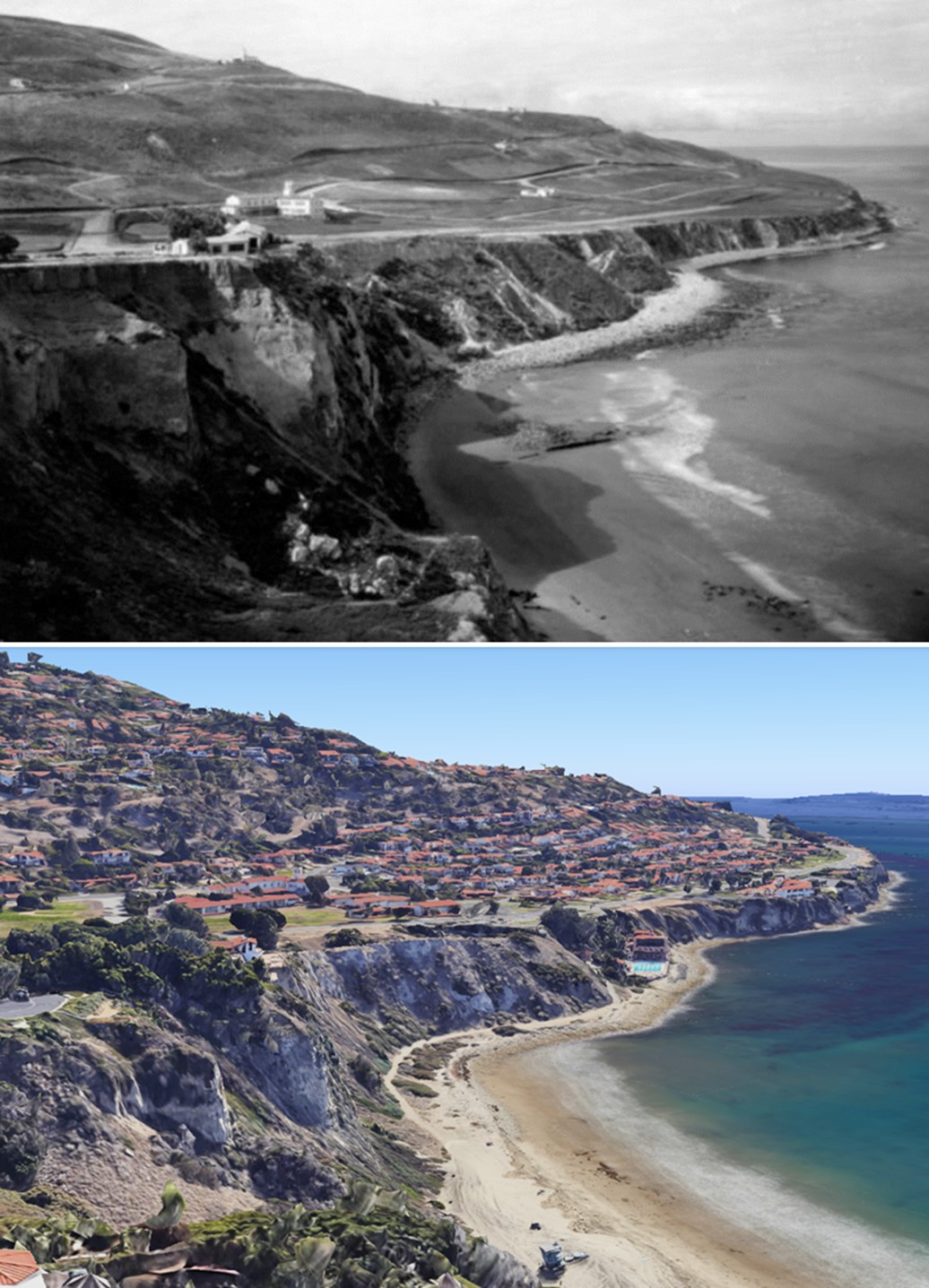 |
|
| (1925 vs 2023)* - Looking southwest toward the cliffs of Malaga Cove. Photo comparison by Jack Feldman. |
Historical Notes In the 1925 image, the cliffs of Malaga Cove are largely untouched, with only a few prominent structures visible, including the Frederick Law Olmsted Jr residence and early community buildings along the ridge. The landscape appears raw and newly claimed, with development still secondary to the natural setting. The modern image shows a settled residential environment framed by mature vegetation and established roads. While the Olmsted residence is no longer present, the overall form of the land remains familiar. The comparison underscores how early architectural and planning choices respected the terrain, allowing the area to evolve without losing its original character. |
* * * * * |
La Venta Inn
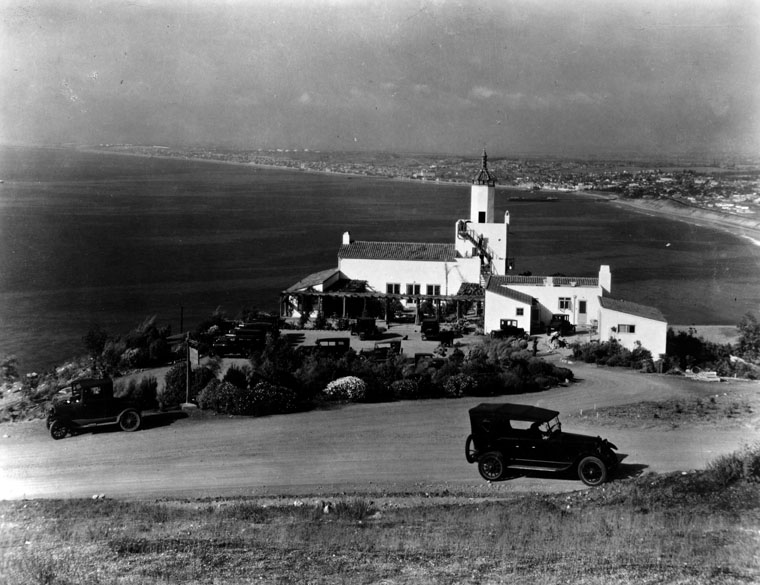 |
|
| (1926)* - Scenic view of La Venta Inn and the coastline stretching north from Redondo Beach. |
Historical Notes La Venta Inn opened in 1924 and was the first completed structure on the Palos Verdes Peninsula. Designed by architects Walter and Pierpont Davis, with gardens planned by the Olmsted Brothers, it initially served as a private clubhouse for real estate agents and prospective buyers. Perched dramatically on the bluff, La Venta was intended to sell the vision of Palos Verdes as much as its land. Its architecture, views, and setting embodied the lifestyle that planners hoped to attract. |
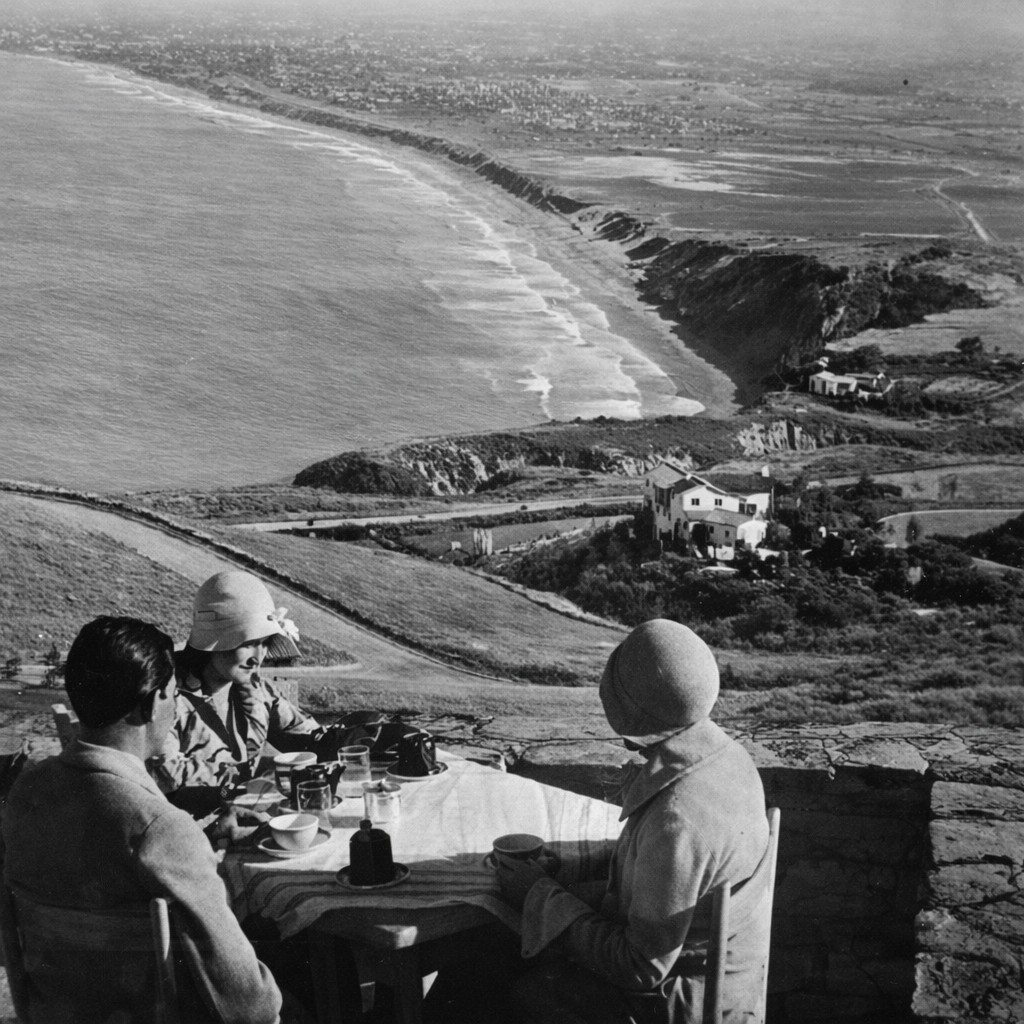 |
|
| (1930s)* - View looking north from the patio of La Venta Inn. |
Historical Notes During the 1920s and 1930s, La Venta became a celebrated destination, known for black tie dinners, weekend retreats, and panoramic ocean views. Visitors included prominent figures from Hollywood, aviation, and high society. During World War II, the inn’s tower was repurposed as a twenty four hour lookout for the US Coast Guard, highlighting the strategic importance of the peninsula’s coastal vantage points. |
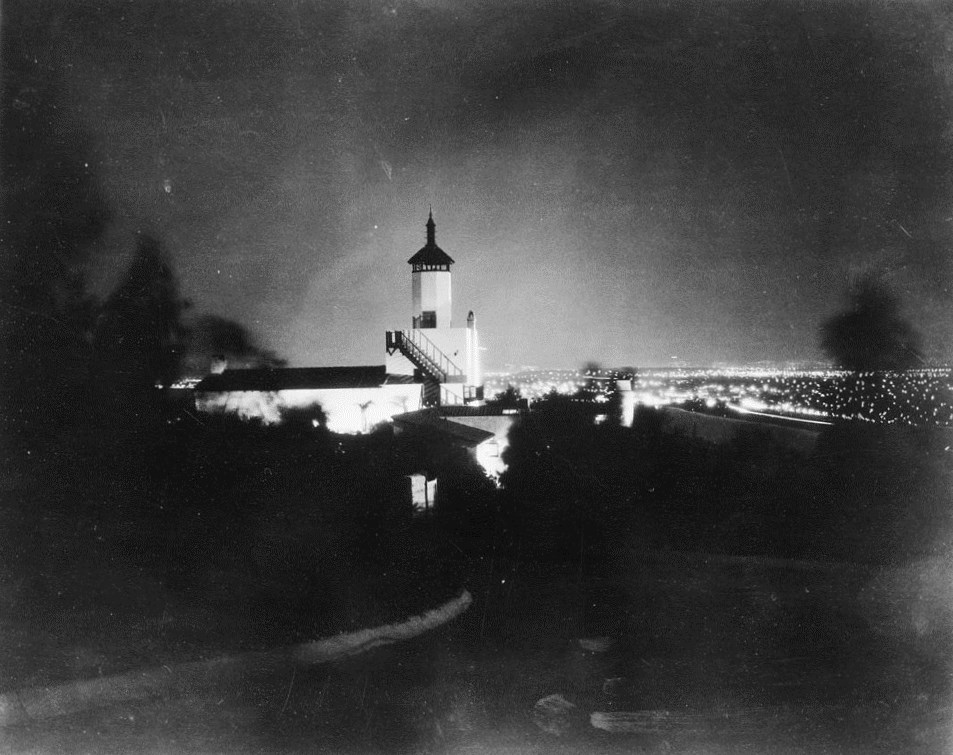 |
|
| (1930)* - Exterior view of the La Venta Inn at night, Palos Verdes, April 1930. |
Historical Notes Illuminated against the dark coastline, La Venta Inn symbolized both elegance and isolation. Its remote setting made it feel worlds away from downtown Los Angeles, despite being only a short drive from the city. The inn’s reputation during this period cemented its place as one of Southern California’s most distinctive coastal landmarks. |
 |
|
| (1930s)* – Close-up daytime view of the La Venta Inn. |
Historical Notes In 1944, La Venta was sold for use as a private residence, but strong public interest quickly led to its reopening as a social and event venue. Over the decades it hosted countless weddings, receptions, and community gatherings. In 1992, professional management was introduced to preserve the property while maintaining its historic character, ensuring that La Venta continues to serve as a living link to the peninsula’s earliest days. |
* * * * * |
Playa Del Rey
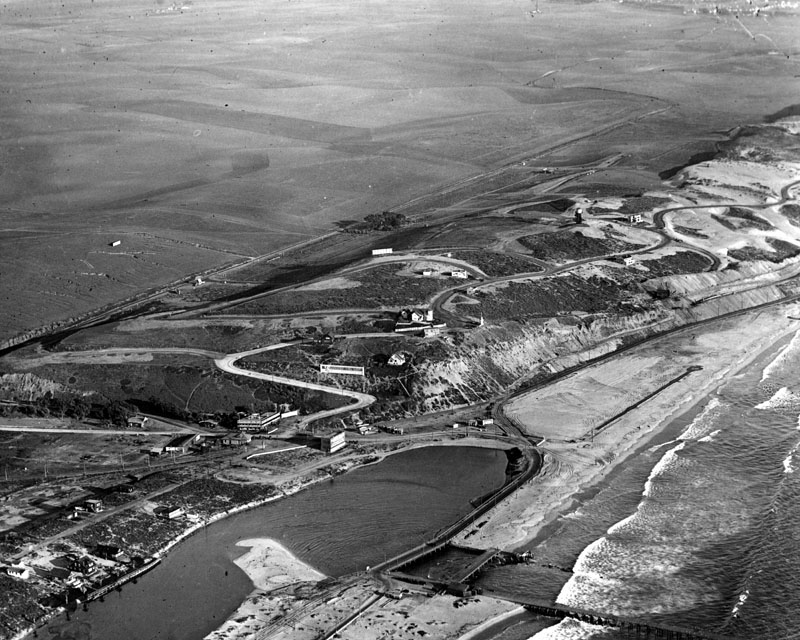 |
|
| (ca. 1924)^ - Aerial view of Playa Del Rey showing the area called "Surfridge". |
Historical Notes A small airfield opened to the east of Surfridge in 1928. It became a popular location for residents to see air shows. The growing number of commercial flights into Los Angeles following World War II meant a higher number of planes flying low over Surfridge. Many residents learned to co-exist with the noise from propeller planes, but jet engines were impossible to ignore. In the 1960s and 1970s, the Sufridge area was condemned and acquired by the City of Los Angeles in a series of eminent domain purchases to facilitate airport expansion (LAX) and to address concerns about noise from jet airplanes. Home owners were forced to sell their property to the City. Several homeowners sued the City and remained in their houses for several years after the majority of houses were vacated. Eventually all the houses were either moved or demolished. |
* * * * * |
Venice Canals
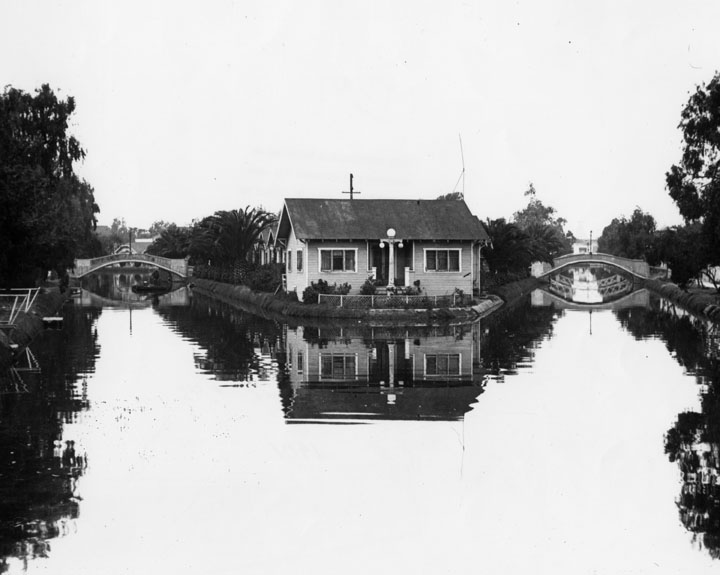 |
|
| (1924)^ - Looking straight ahead at the houses you see a complex of rental bungalows known as United States Island. It was accessible only by the foot bridges seen on either side of it. In this view, looking north, Altair Canal is on the left and Cabrillo Canal on the right. |
Click HERE to see more Early Views of the Venice Canals (1904+). |
* * * * * |
Santa Monica Pier
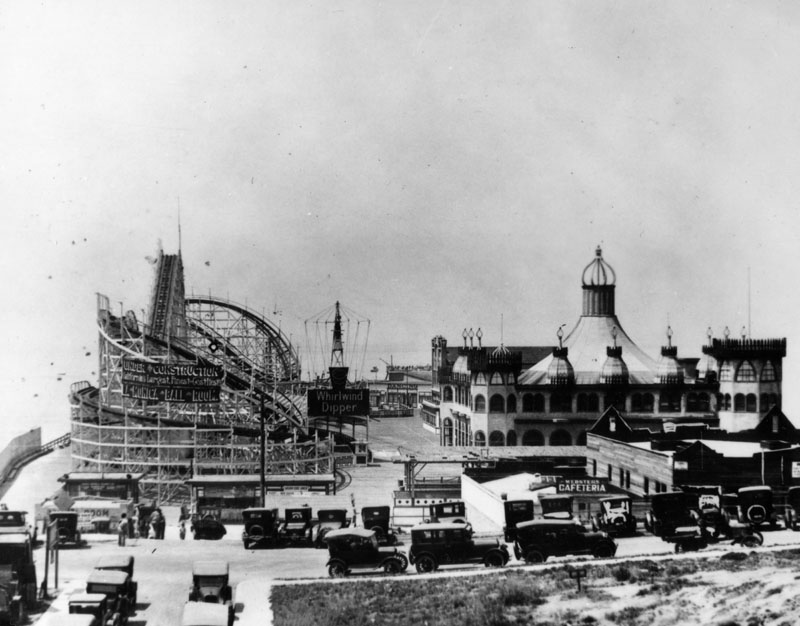 |
|
| (1924)^ - View shows an amusement park, complete with wooden roller coaster, on the Santa Monica pier. |
Historical Notes The Santa Monica Municipal Pier opened in 1909 and was the first pier on the west coast to use reinforced concrete pilings. It was thirty-six feet wide and stretched 1200 feet into the Pacific Ocean. In 1916, Charles I.D. Looff constructed a Moorish-Byzantine hippodrome, which housed a merry-go-round with 44 hand-crafted horses, a billiards and bowling hall, a two-track Blue Streak Racer wooden roller coaster along with The Whip and the Aeroscope thrill rides, a "What Is It?" maze, and several smaller rides. Looff's opening day, July 4, 1917, drew over 100,000 people; the biggest crowd in the city's history.^ In 1987, the Santa Monica Looff Hippodrome was added to the National Registry of Historic Places. Click HERE to see more in Early Views of Southern California Amusement Parks |
Venice Pier
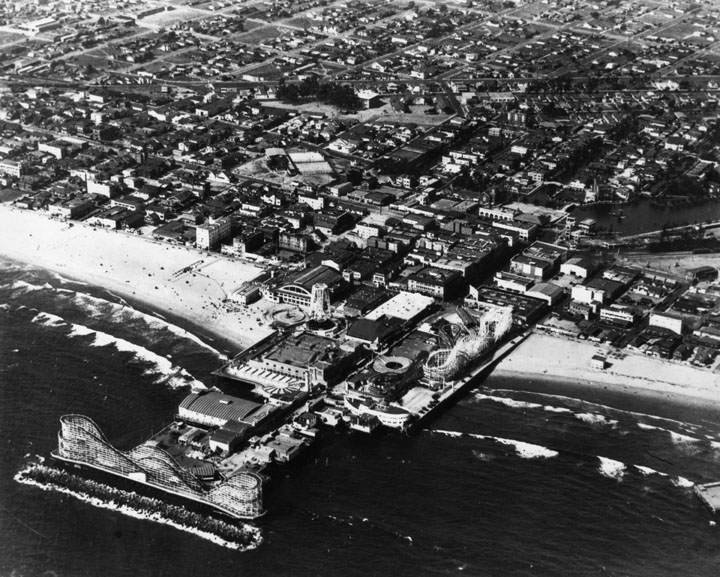 |
|
| (ca. 1925)^ - Aerial view of Venice, its beach and pier. The canals are visible at the extreme right. |
Click HERE to see more in Early Views of Southern California Amusement Parks |
* * * * * |
Southland Beaches
_1925.jpg) |
|
| (1925)^ - The ocean water is filled with people swimming or playing, and the beach is likewise filled with people and umbrellas (to keep off the sun). The view is looking north towards Ocean Park where some buildings and part of Lick Pier are visible. |
Click HERE to see more early views of Southland Beaches in Early Views of Santa Monica |
* * * * * |
San Fernando Valley
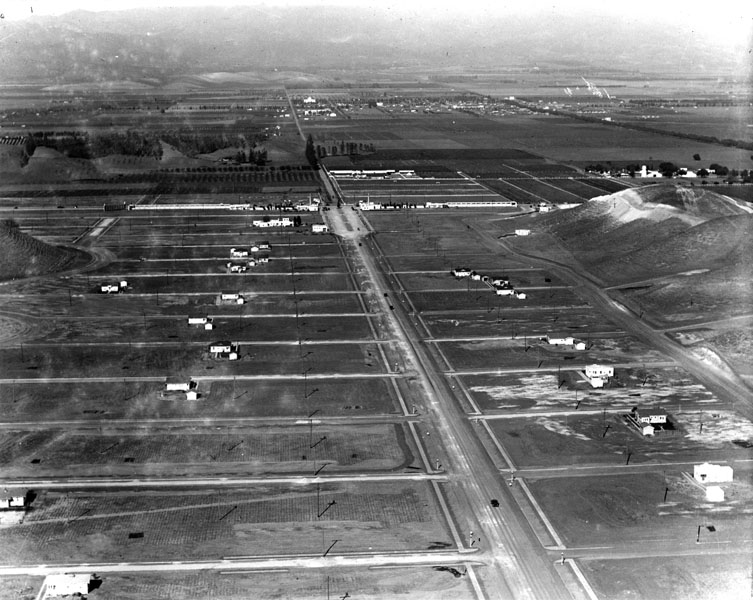 |
|
| (1924)^ - Aerial view of Woodland Hills (Girard) in 1924. |
Historical Notes Victor Girard Kleinberger was a land huckster with big dreams. Born in Kentucky, he began his sales career peddling Persian rugs -- fakes, of course -- door to door. Girard's modus operandi was to shove the rolled-up rug into the door frame (thus preventing the door from being slammed shut on him) and begin coughing profusely -- all the while mumbling about tuberculosis and priceless rugs. It was a ruse that apparently worked, and by 1899, with his fortune already made, the 18-year-old Girard (he had dropped his last name) headed west to Los Angeles, where he branched out into other enterprises, including real estate.*## In 1922, Girard Kleinberger bought 2,886 acres in the west San Fernando Valley and founded the town of Girard. He sought to attract residents and businesses by developing an infrastructure, advertising in newspapers, and planting 120,000 trees. His 300 pepper trees forming an arch over Canoga Ave. between Ventura Boulevard and Saltillo St. are Los Angeles Historic-Cultural Monument #93 in 1972 (Click HERE to see the LA Historic-Cultural Monuments List***). |
 |
|
| (ca. 1924)^ - This is the intersection of today's Ventura Boulevard (foreground) and Topanga Canyon Boulevard, in the real estate development of Girard. |
Historical Notes Although Girard Kleinberger's early efforts were criticized as providing only a dubious facade of economic activity (local lore has it that in order to attract development he erected false store fronts on Ventura Boulevard, for which he spent time in jail), the Girard Golf Course completed in 1925 continues to operate today as the Woodland Hills Country Club, and his scheme was ultimately successful in attracting interest in the community. |
Click HERE to see more in Early Views of the San Fernando Valley |
* * * * * |
Mulholland Highway
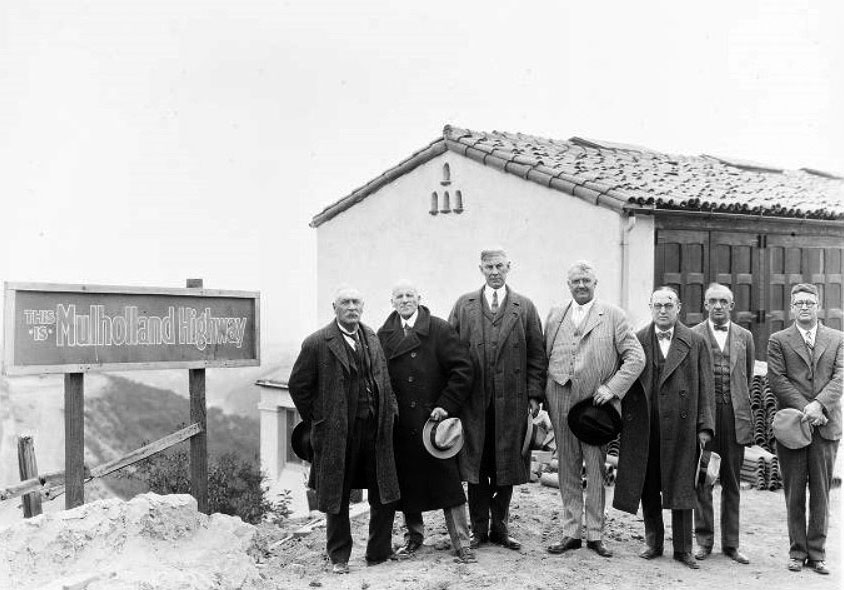 |
|
| (1920s)*^#^ - William Mulholland (far left), Moses Sherman (2nd from left), Harry Chandler (center) and a group of men posing next to a "Mulholland Highway" sign while out examining the Mulholland Dam site. |
Historical Notes Mulholland Highway (later Mulholland Drive) has its origins in 1921 as a scenic drive, with the “working name” of Skyline Drive, engineered by DeWitt Reaburn. The scenic drive was engineered in small sections, with work actually beginning at several points along the route simultaneously. The road was originally planned to encompass a right of way of 200 feet and intended to be 20 miles long, taking a mere two years to complete. For reasons, some to honor Mulholland, but mostly to use his stature and accomplishments to silence opposition, the most traveled scenic highway conceived as Skyline Drive became Mulholland Highway. ##** |
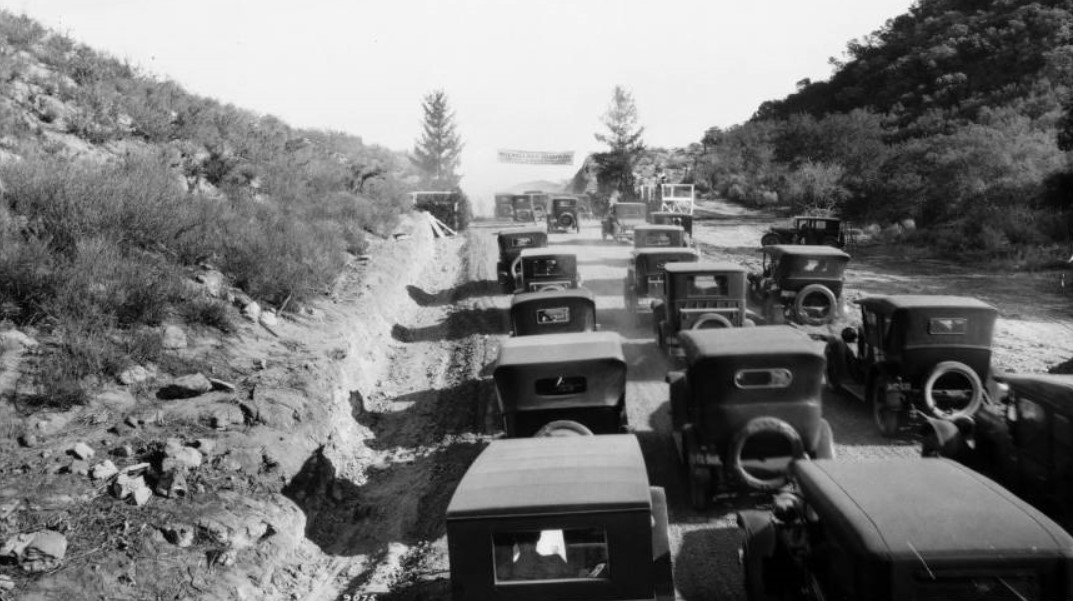 |
|
| (1924)^^ - View of over a dozen early model cars clustered at the opening of the Mulholland Highway. Three rows of early automobiles make their way up the hill and through the mountains on the Mulholland Highway. Rocks and scrub vegetation cover the slopes to either side, a parked car and a wooden platform visible to the right, just off the road. At the peak of the hill, a banner is hung between two trees. |
Historical Notes This winding ridgeline road in the Santa Monica Mountains was dedicated in honor of William Mulholland, the water engineer who designed the Los Angeles Aqueduct, on Dec. 27, 1924. Originally dirt and called Mulholland Highway, the name was changed to Mulholland Drive in 1939. Portions of the original road remain unpaved.^* |
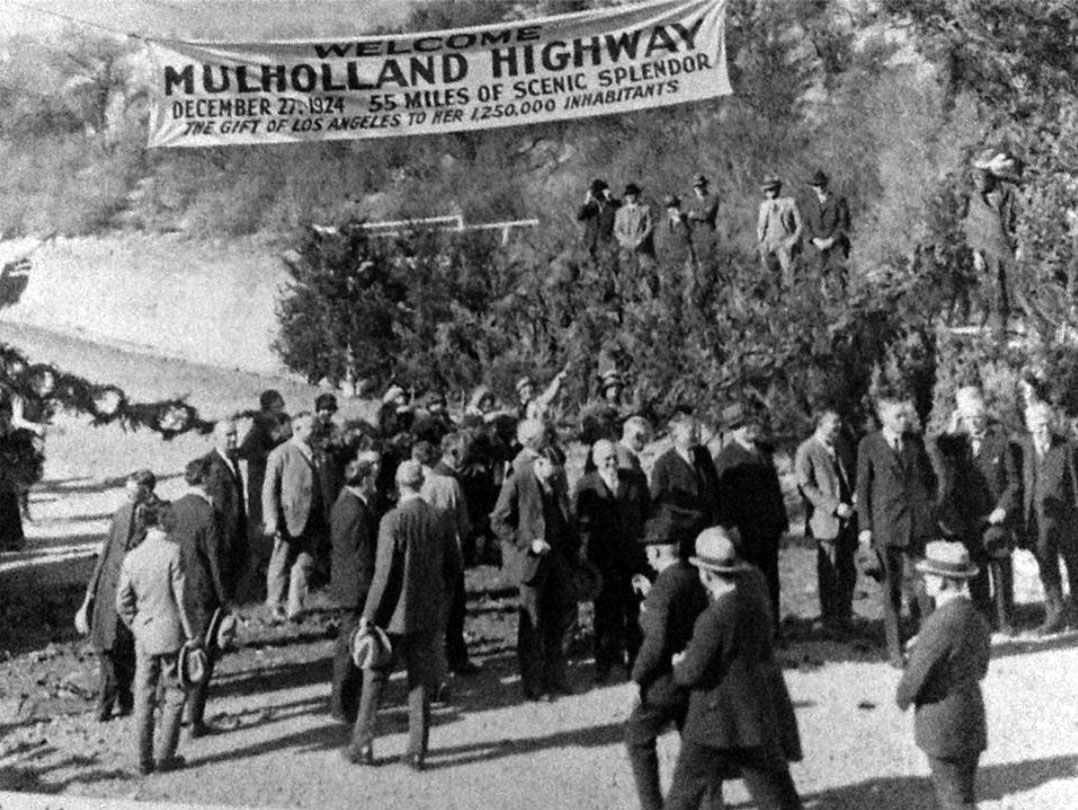 |
|
| (1924)^#*^ – Closer view showing dignitaries assembling near a banner which reads: Welcome Mulholland Highway - December 27, 1924 – 55 Miles of Scenic Splendor – The Gift of Los Angeles to her 1,250,000 Inhabitants |
Historical Notes The eastern terminus of Mulholland Drive is at its intersection with Cahuenga Boulevard at the Cahuenga Pass over the Santa Monica Mountains (at this point Cahuenga Boulevard runs parallel to Highway 101/The Hollywood Freeway). The road continues to the west, offering vistas of the Hollywood Sign, downtown Los Angeles, and then Burbank, Universal City, and the rest of the San Fernando Valley with the San Gabriel, Verdugo, and Santa Susana Mountains.*^ |
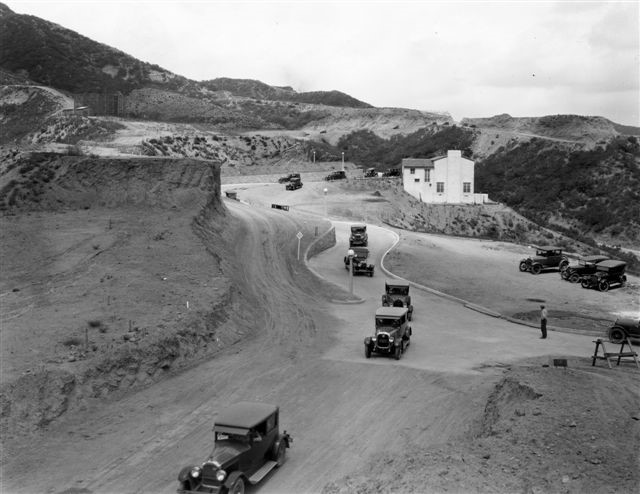 |
|
| (1925)^ - View of Mulholland Highway under construction near Beachwood Canyon. |
Historical Notes Mulholland Highway curves around the western edge of Beachwood Canyon like a massive snake. A man-made thoroughfare buttressed by granite retaining walls, the Highway was built, like all the roads in Hollywoodland, in the mid-1920s. It contains both a split-level section (under construction in the photo above) and a cliff-side stretch locals call the blind curves. |
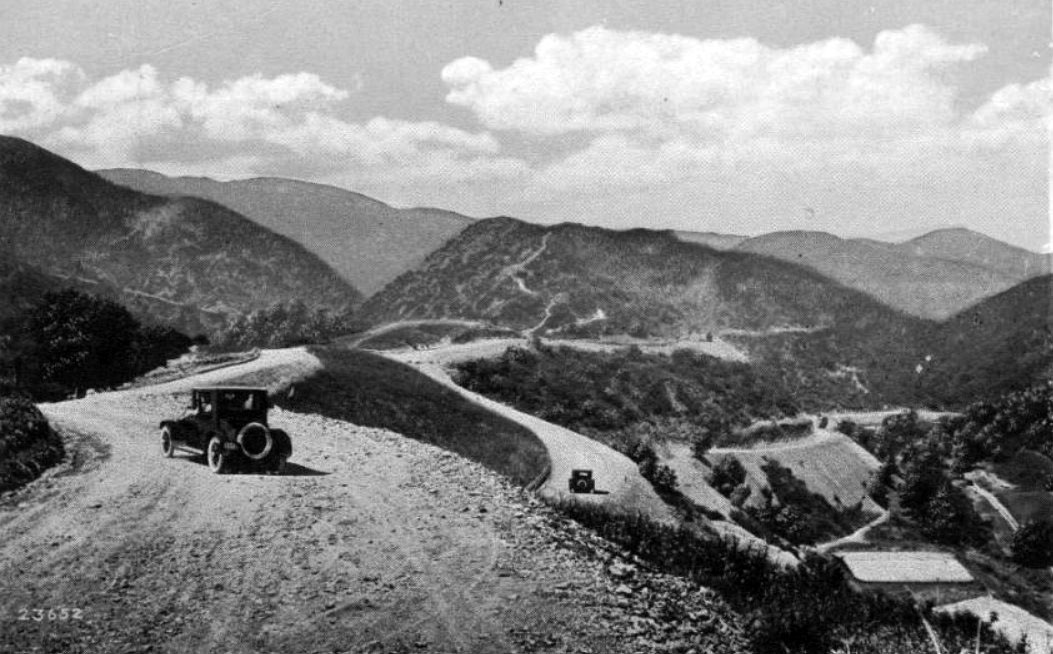 |
|
| (ca. 1925)^*## – Postcard view showing two early model cars near the intersection of Mulholland Highway (later Drive) and Franklin Canyon. |
Historical Notes Curving ingeniously through the eastern Santa Monicas, the Mulholland Drive motorway once brought a heavy slew of Angelenos into the Valley. In the early 1970s, however, 5,000 local activists successfully prevented the cement paving of most of that stretch. To this day, that section is known as 'Dirt Mulholland', and is only open to cyclists and pedestrians. From the famous Mulholland Bridge east, Mulholland Drive completes its creator's vision, and winds through the affluent Hollywood Hills to Mulholland Drive's easternmost terminus at Cahuenga Boulevard, near Universal Studios, until again becoming an unpaved footpath to Griffith Park. The paved road begins again east of Topanga Canyon Boulevard at Santa Maria Road. Shortly thereafter, the thoroughfare splits into Mulholland Drive and Mulholland Highway. Mulholland Drive terminates at U.S. Highway 101 (the Ventura Freeway), where it becomes Valley Circle Boulevard. Mulholland Highway continues to the southwest until it terminates at State Route 1 (PCH) in Leo Carrillo State Park at the Pacific Ocean coast and the border of Los Angeles and Ventura counties.*^ |
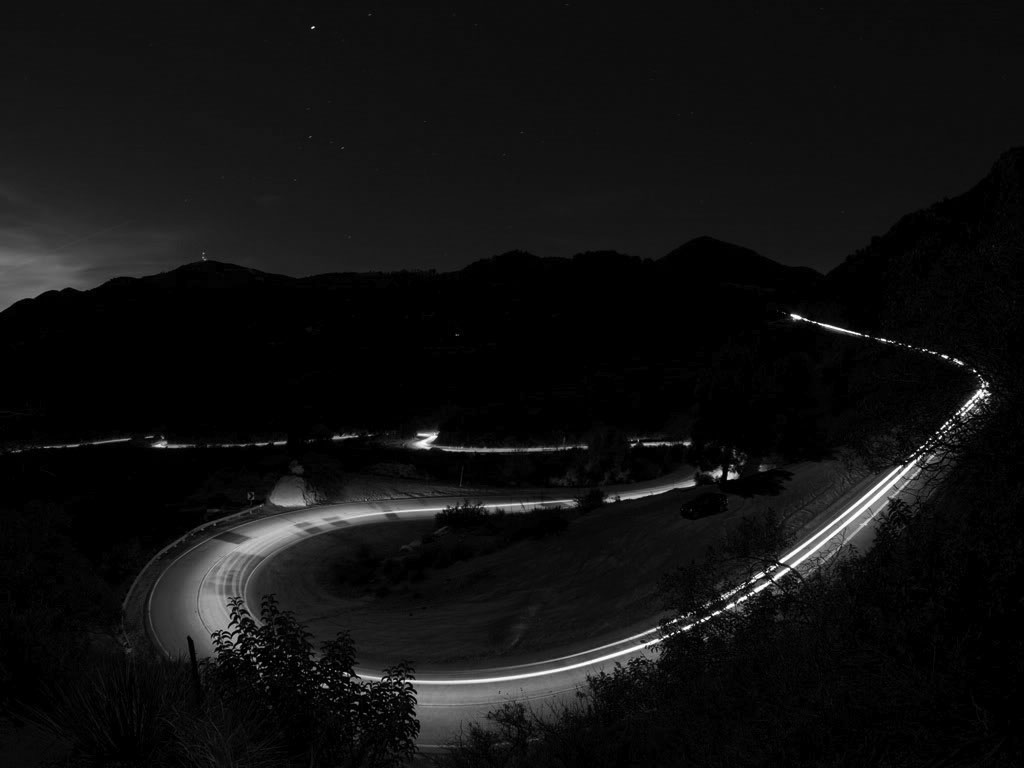 |
|
| (ca. 2011)+^+ – Time-lapse image showing Mulholland Drive at night. |
Historical Notes The road offers spectacular views of the Los Angeles Basin, the San Fernando Valley, and the Hollywood Sign. Mulholland Drive is home to some of the most exclusive and most expensive homes in the world. Many of these homes are set back from the road and offer outstanding views of downtown Los Angeles. Celebrities such as Jack Nicholson, Sylvester Stallone, Justin Timberlake, Eric Stoltz, Jessica Biel, Paris Hilton and Reese Witherspoon all live nearby.*^ |
Click HERE to see more in Mulholland Monuments |
* * * * * |
Family Camps and Parks
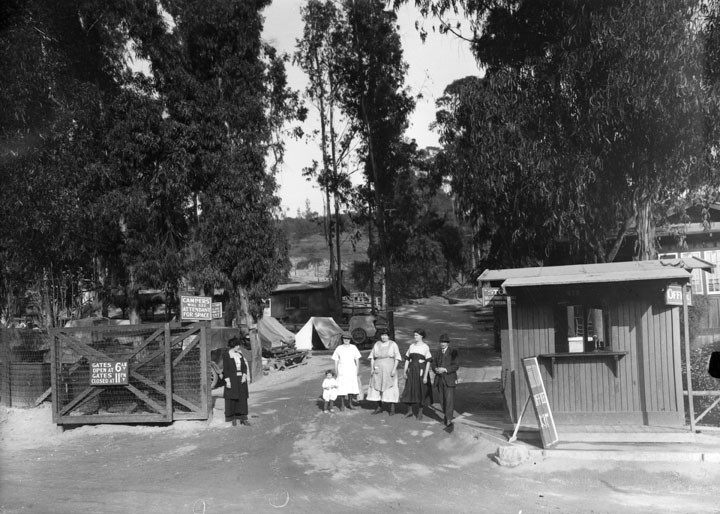 |
|
| (1920s)^ - Five adults and a child stand at the entrance to a camping area in Elysian Park. Next to them is a wooden building with the sign "Office" on the end. The gates on the other side of them announce they open at 6 and close at 11. |
Historical Notes From humble beginnings, City Council created the Department of Parks in 1889. At that time the city owned several pieces of land that were believed suitable for park purposes. They turned over these properties to the newly-organized Department of Parks. In a generous mood during Christmas of 1896, Colonel Griffith J. Griffith offered to donate five square miles of the Los Feliz Rancho to the City as a park. He said, "it must be made a place of recreation and rest for the masses, a resort for the rank and file, for the plain people..." What followed was the development of several more parks including the original pueblo lands of the old plaza, Elysian Park, Pershing Square, and later Lincoln Park, MacArthur Park, Echo Lake Park, and Hollenbeck Park.++* |
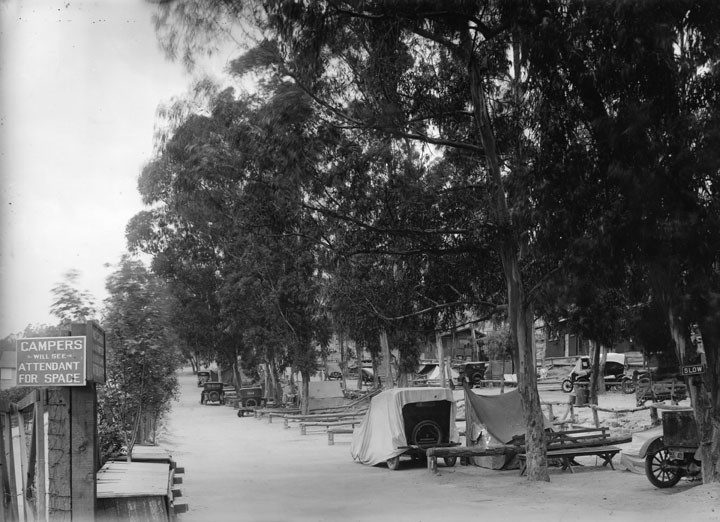 |
|
| (1920s)^ - A view from the entrance gate down two rows of campsites at Elysian Park. A few tents and a few cars are already in place. At the entrance a sign notifies all that "Campers will see attendant for space". |
Historical Notes Children's camps and family camp as a municipal recreation service began in 1913. Although no longer open, the first camp was established in Redondo Beach. In 1914 Camp Seely in the San Bernardino Mountains in Crestline was the first family camp built, and in 1919 Camp Radford opened in Big Bear in the San Bernardino National Forest. Camp High Sierra in the Mammoth region opened to families in 1924 and has proved popular to this day with generations of the same family members attending the camp. Then came the local camps; Griffith Park Boys Camp opened in 1925 and a year later Hollywoodland Girls Camp opened. The last two camps to be added were Decker Canyon Camp in Malibu and Camp Valcrest in Angeles National Forest. The Department's camping program was so innovative that Oakland, Berkeley, Sacramento, Stockton, Long Beach, and San Diego followed suit.++* |
* * * * * |
Downtown Los Angeles
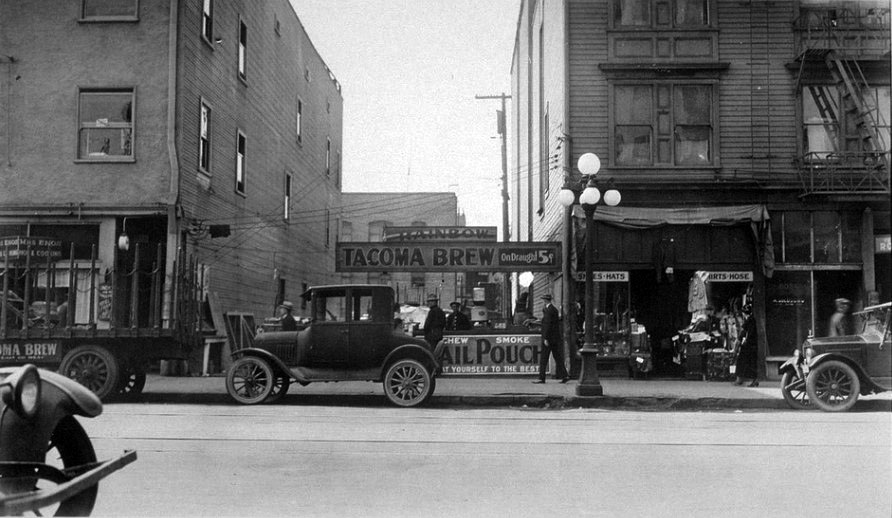 |
|
| (1924)#^ - Open Fruit Stand, 812 E. 5th Street, Los Angeles. Sign reads: 'Rainbow Tacoma Brew - 5 Cents' |
Hill and 5th Street
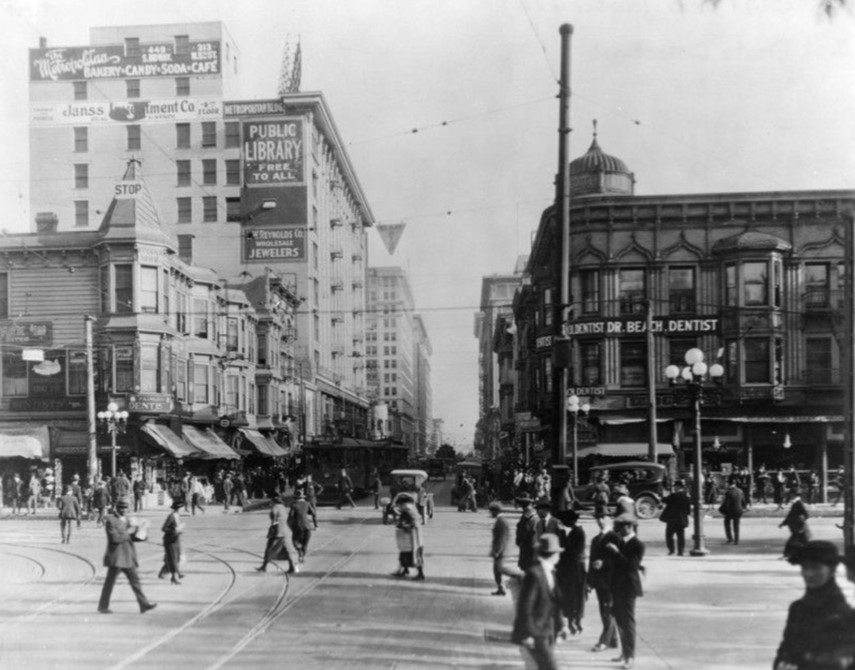 |
|
| (1920)* - Looking east on 5th at Hill street. Several buildings such as the Spinks, Metropolitan and Bath Building (aka Willoughby Hotel) can be seen, as well as several storefronts like Dr. Beach, Dentist. Pershing Square is to the right out of view. |
.
 |
|
| (1922)^^ – View looking east on 5th Street at Hill Street. Streetcars, autos, and pedestrians share the streets. Boos Bros. Cafeteria can be seen behind the streetcar. The building on the right is the Willoughby Hotel (S/E corner of 5th and Hill) which was built in 1898 and demolished in 1982. Pershing Square is across the street from the Willoughby out of view (to the right). |
Historical Notes In 1906, Horace Boos and three siblings opened one of Los Angeles' first cafeterias. Their idea of a fast food, self-service restaurant consisted of unheard-of impositions for that time: patrons would wait on themselves and return their trays and dishes to the kitchen. The brothers' downtown cafeteria was the first link, in a chain of seven that ultimately stretched from Los Angeles to San Francisco. They opened four more in the downtown area one in Santa Catalina Island, and two in San Francisco. By the 1920s, the chain of cafeterias had become widely known. When Horace Boos died in 1926, the surviving brothers sold the seven cafeterias for a record $7 million to the Childs Corp. In turn, Childs sold two of the cafeterias to Clifford E. Clinton, who launched the Clifton's Cafeteria Chain. Eventually, Henry Boos bought back two, one on Hill Street and the other in Avalon on Catalina Island. The Boos Brothers offered inexpensive fare of a "40-cent dinner", but would call it quits in the late 1940s, before cafeterias began losing popularity due to the arrival of luncheonettes, soda fountains, and fast-food restaurants.^ |
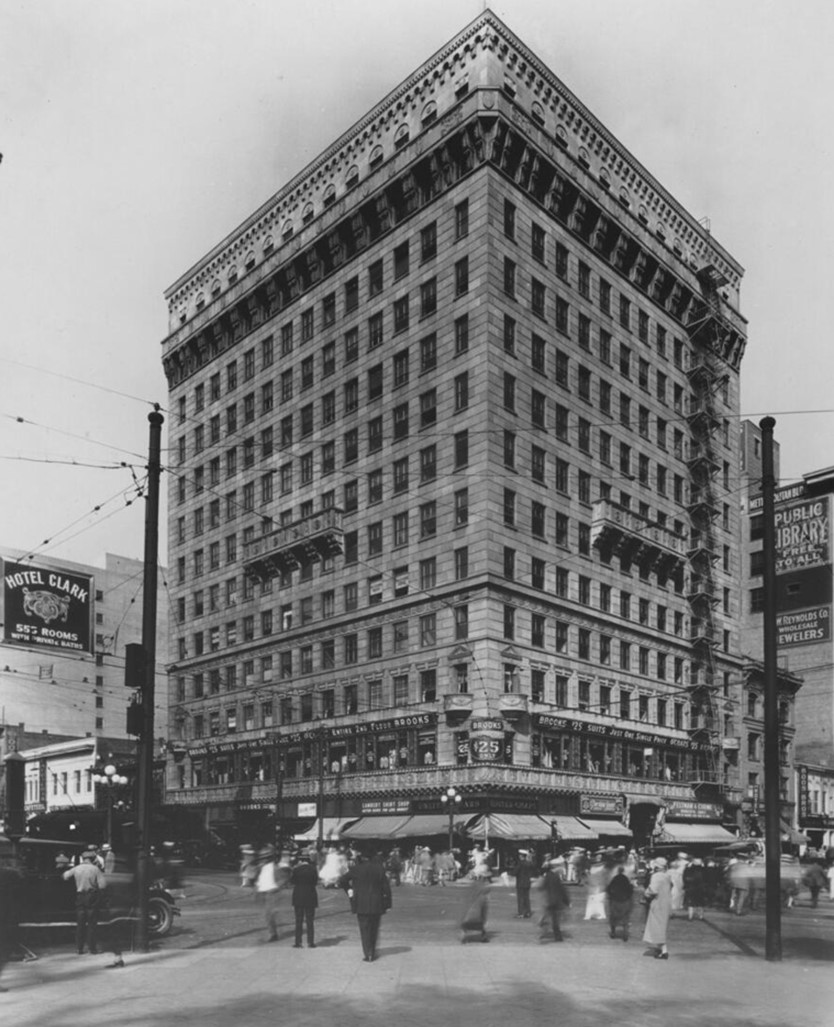 |
|
| (1924)* – Looking at the NE corner of 5th and Hill streets showing the newly built Pershing Square Building. |
Historical Notes The Pershing Square Building was built in 1924 and designed by architects Claud Beelman and Aleck Curlett in the Italian Renaissance Revival style that features classic design elements, symmetry, arches, and ornamental stone brackets. |
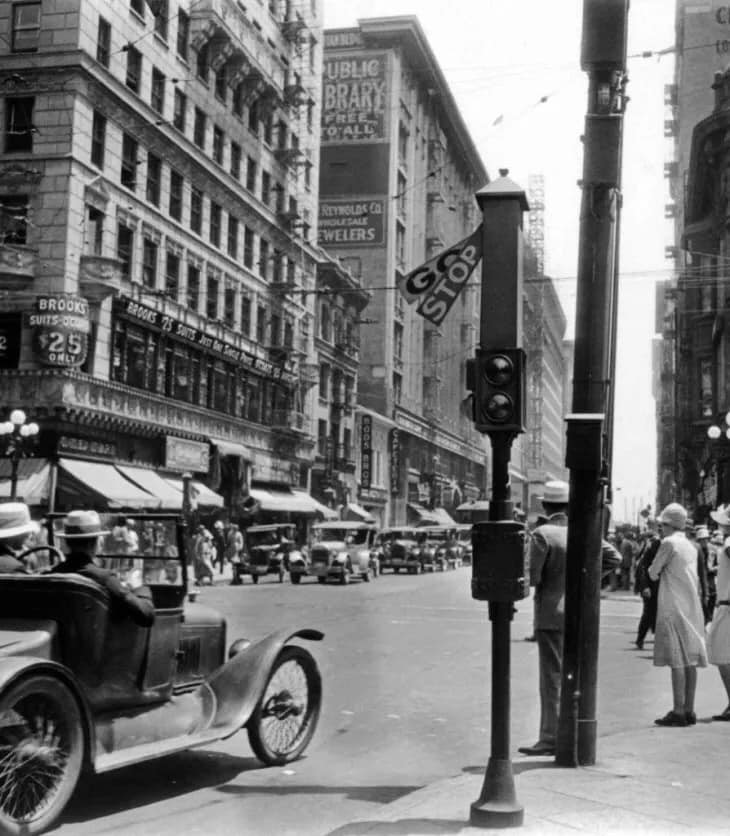 |
|
| (ca. 1925)* – Looking east on 5th Street at Hill Street showing a newly installed semaphore traffic signal |
Then and Now
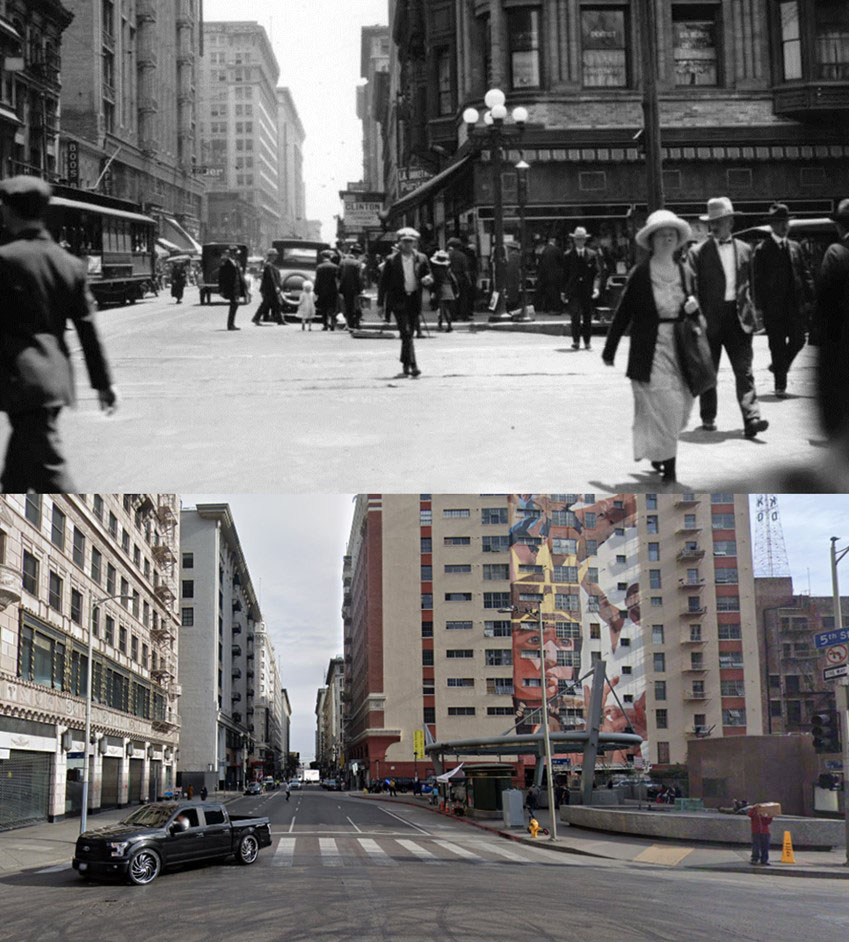 |
|
| (1922 vs. 2022)* - 5th Street looking East from Hill Street. Pershing Square is on the right behind the camera. Photo comparison by Jack Feldman. |
Then and Now
 |
|
| (1890 vs. 2021)* – 5th Street looking West from Hill Street with Pershing Square (then 6th Street Park) seen on the left. Photo comparison by Jack Feldman. |
Pacific Electric Hill Street Station and Subway Tunnel
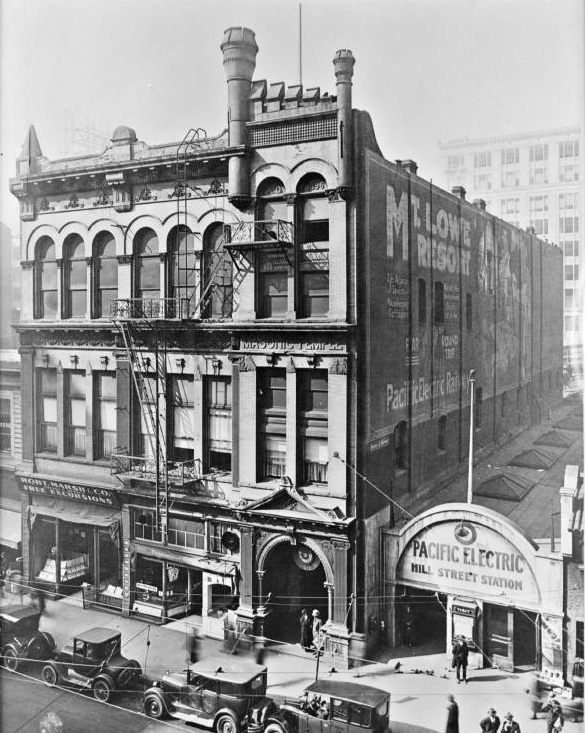 |
|
| (ca. 1920s)^## - Pacific Electric Hill Street Station & Masonic Bldg. West side of Hill St. between 4th & 5th Streets. |
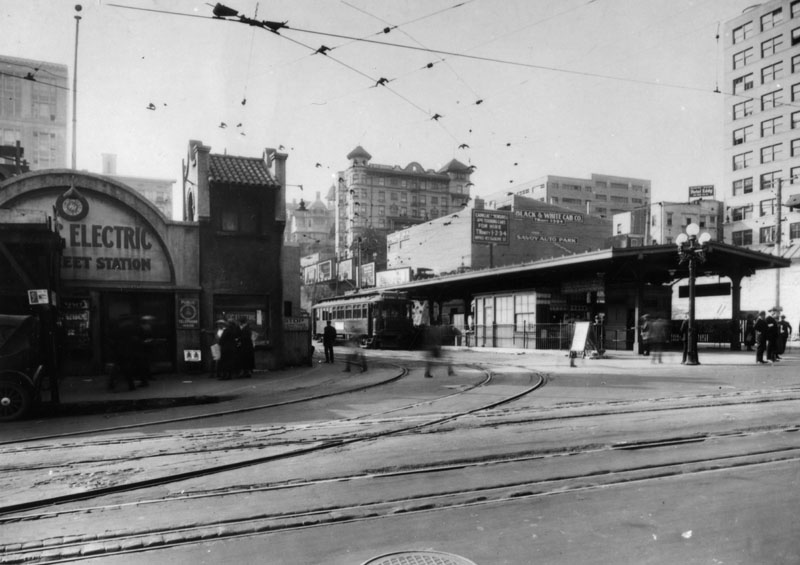 |
|
| (ca. 1922)^ - The Pacific Electric Hill Street station, located at 427 South Hill Street, between 1922 and 1925. |
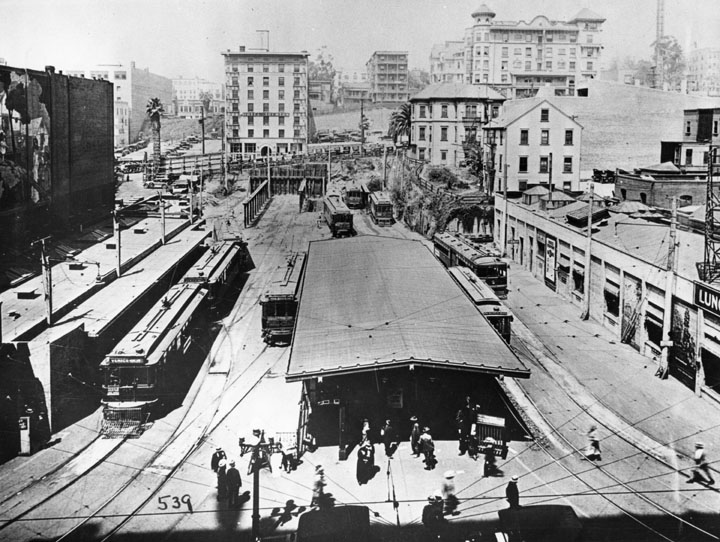 |
|
| (ca. 1920s)^ - The Hill Street station for electric cars during 1922 to 1925, before the Subway Terminal Building was built, looking west toward Bunker Hill. |
Historical Notes As street traffic increased in downtown Los Angeles, the Pacific Electric Railway undertook its most ambitious project, a dedicated right of way into downtown through a subway - the existing terminal in the Pacific Electric Building at Sixth and Main was reached by shared street running. Responding to the traffic congestion that clogged the streets, the California Railroad Commission in 1922 issued Order No. 9928, which called for the Pacific Electric to construct a subway to bypass downtown's busy streets.*^ |
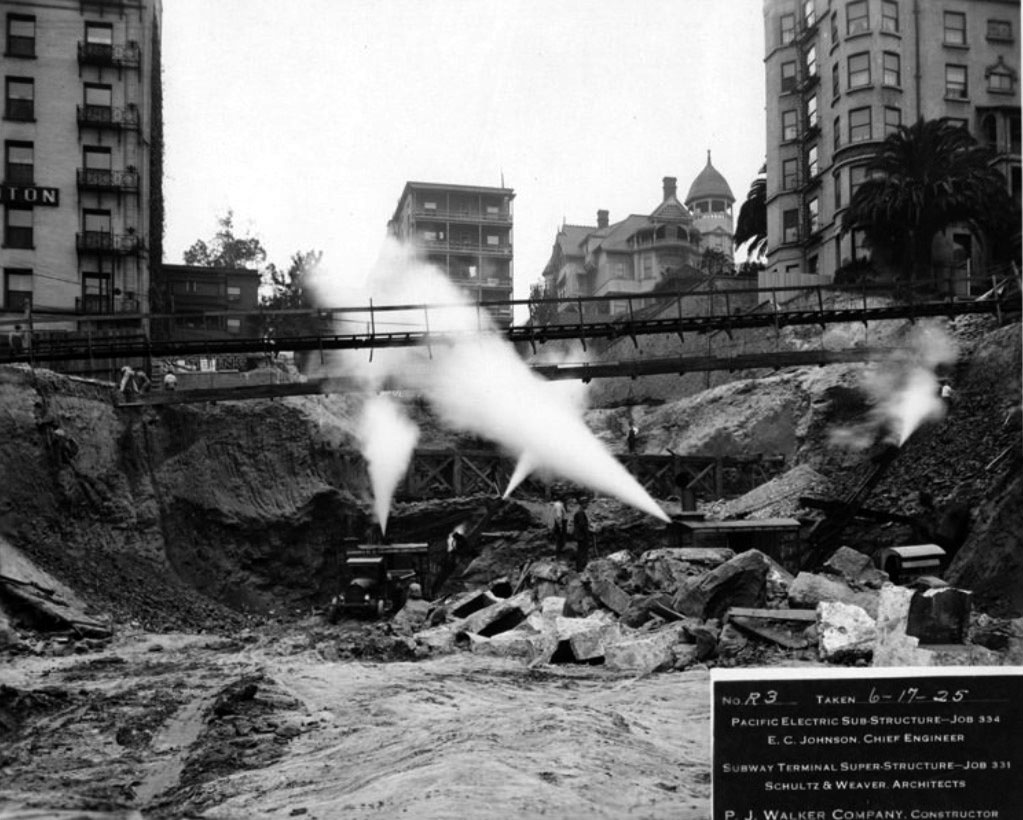 |
|
| (1925)^.^ – View, looking west from Hill Street, of the construction site as the PE Hill Street Station is converted to a massive building and entrance to a subway tunnel which will cross Bunker Hill to Toluca Yard (1st/2nd/Beverly Boulevard/Glendale Boulevard). Here they have breached the Olive Street roadbed and spanned the vacated Olive Street School/Health Department property. The Trenton (on the left) and the Fremont (on the right) look on nervously. The Rose Mansion at 4th Street and Grand Avenue can be seen behind the Fremont Hotel. |
Historical Notes After 18 months of construction and $1.25 million in expenditures, the Subway officially opened to the public on December 1, 1925, between the intersection of Beverly and Glendale Blvds in Westlake, and the Subway Terminal Building.*^ |
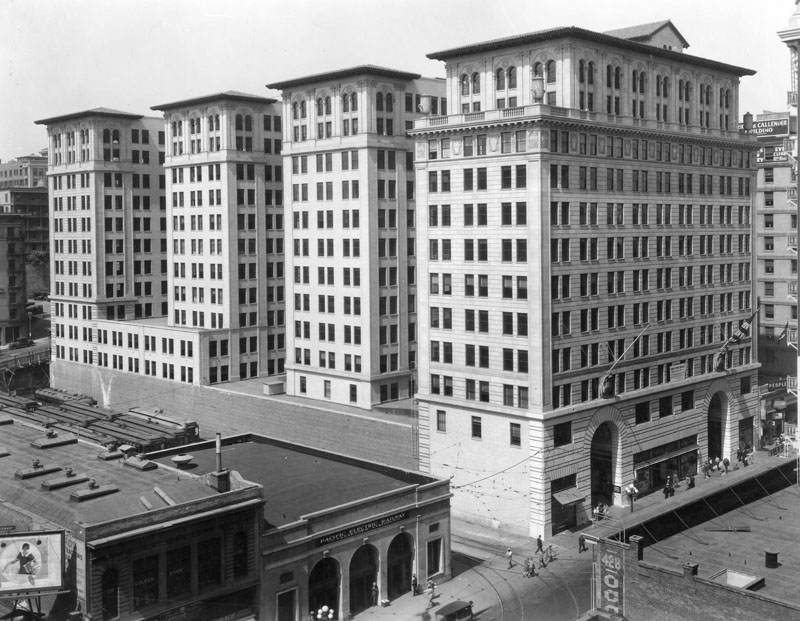 |
|
| (1925)^ - View of the Subway Terminal Building and the Pacific Electric Railway Passenger Station in 1925, the year they were built. View is of the Hill Street side south of 4th Street. |
Historical Notes The Subway Terminal Building was built to conform to the 150 foot height limit imposed on all downtown construction. The other end of the subway line emerged at the surface at the Belmont Tunnel / Toluca Substation and Yard.*^ |
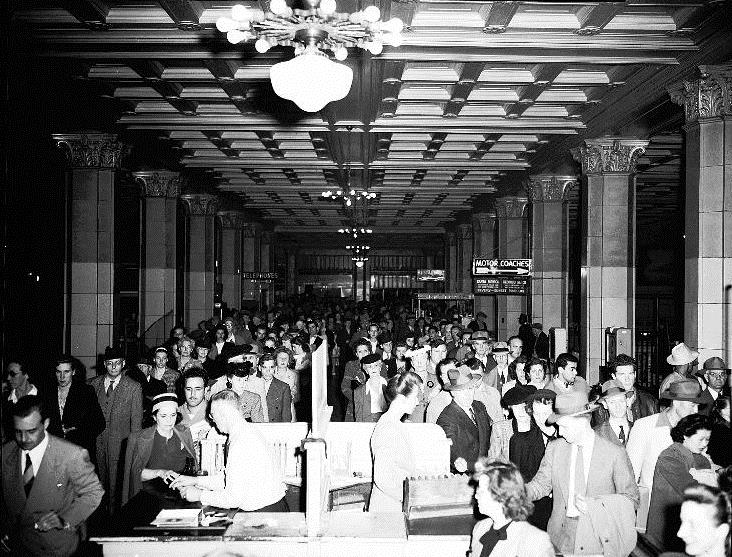 |
|
| (ca. 1925)^## - View showing crowds of people navigating through the Subway Terminal main hall. |
Historical Notes After 18 months of construction and $1.25 million in expenditures, the Subway officially opened to the public on December 1, 1925. The trains, which traveled a distance of slightly over one mile, transported passengers between the tunnel's mouth near the intersection of Beverly and Glendale Boulevards in Westlake, and the Subway Terminal Building.*^ |
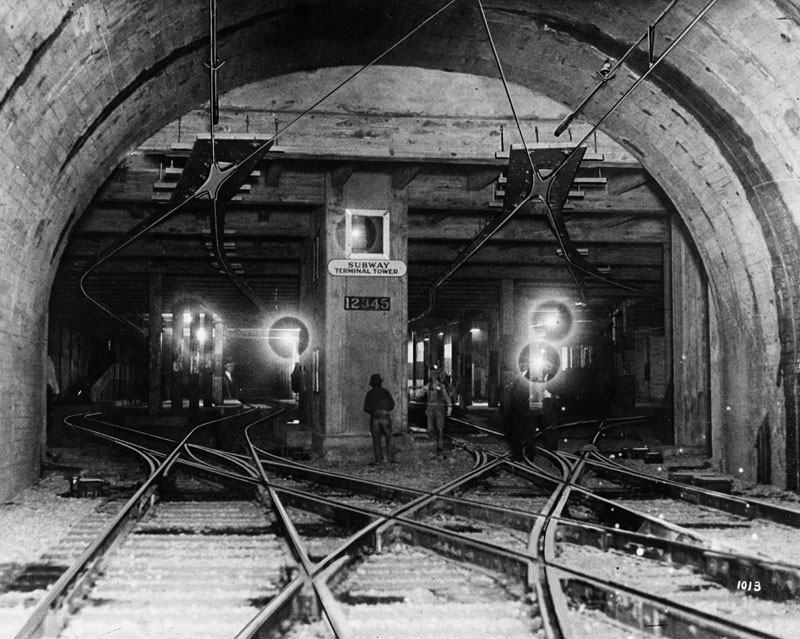 |
|
| (ca. 1925)^ - Interior view of the Subway Terminal Building in downtown Los Angeles, showing Pacific Electric car tracks running in various directions in the subway. |
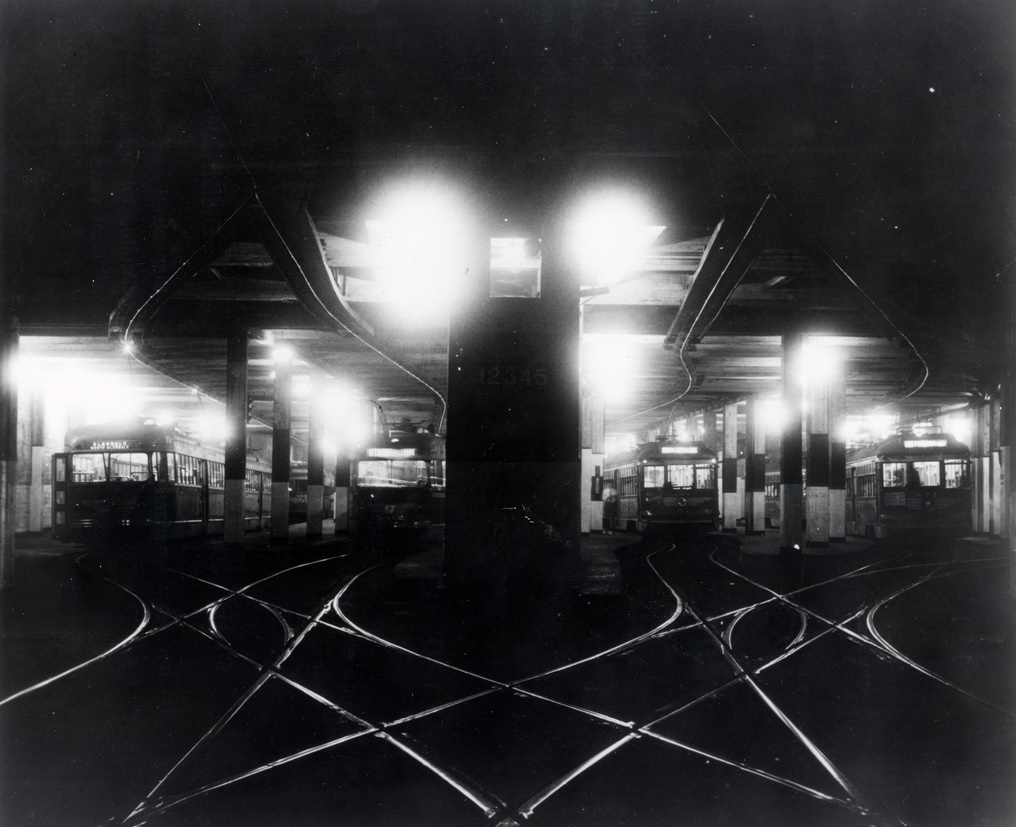 |
|
| (n.d.)^## - View of the symmetry in the tracks within the Pacific Electric Subway Building. The subway was in operation from 1925 to 1955. |
* * * * * |
Belmont Tunnel / Hollywood Subway – Western Portal & Toluca Yard
Construction of the Western Portal
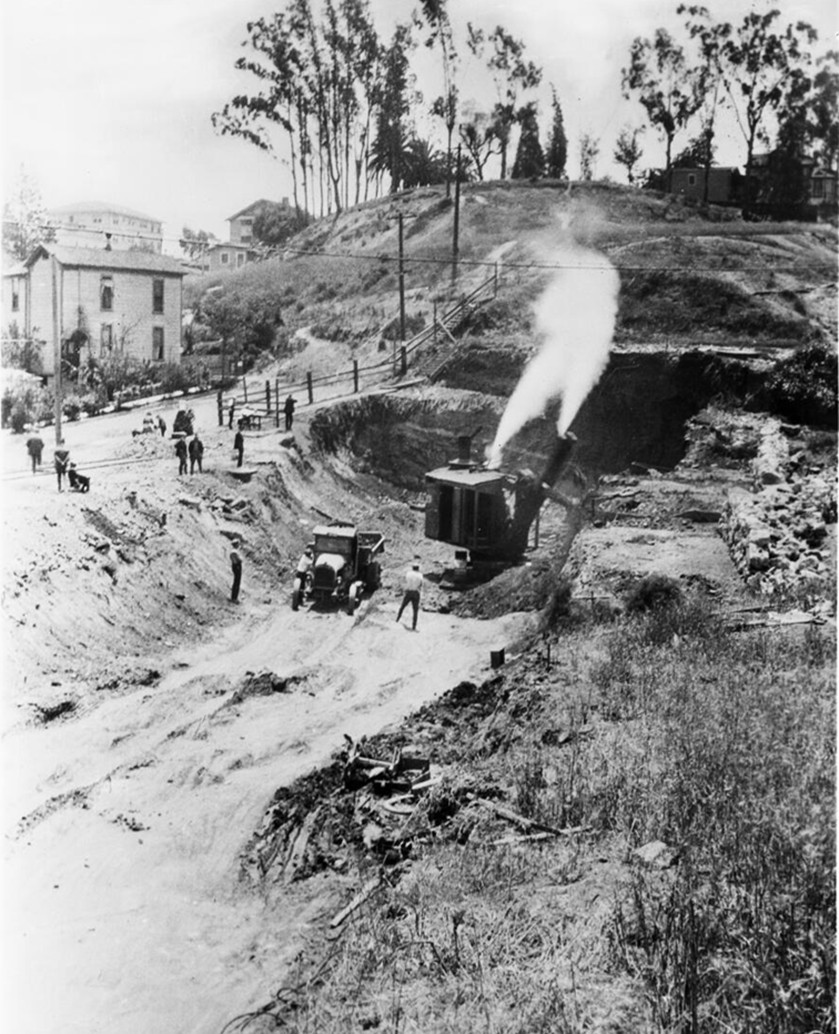 |
|
| (1924)* - Construction of the western portal of the Pacific Electric subway tunnel at 1st Street and Glendale Boulevard. |
Historical Notes Plans for what newspapers called the “Hollywood Subway” (officially the Pacific Electric Subway) were prepared in early 1924, and groundbreaking took place on May 3, 1924. The tunnel provided a grade-separated shortcut beneath Bunker Hill between the Subway Terminal at 4th and Hill Streets and the western portal near Beverly and Glendale Boulevards. It was approximately one mile long and double-tracked. Click HERE to see construction of the Eastern Portal of the PE Subway Tunnel. |
Opening of the Tunnel
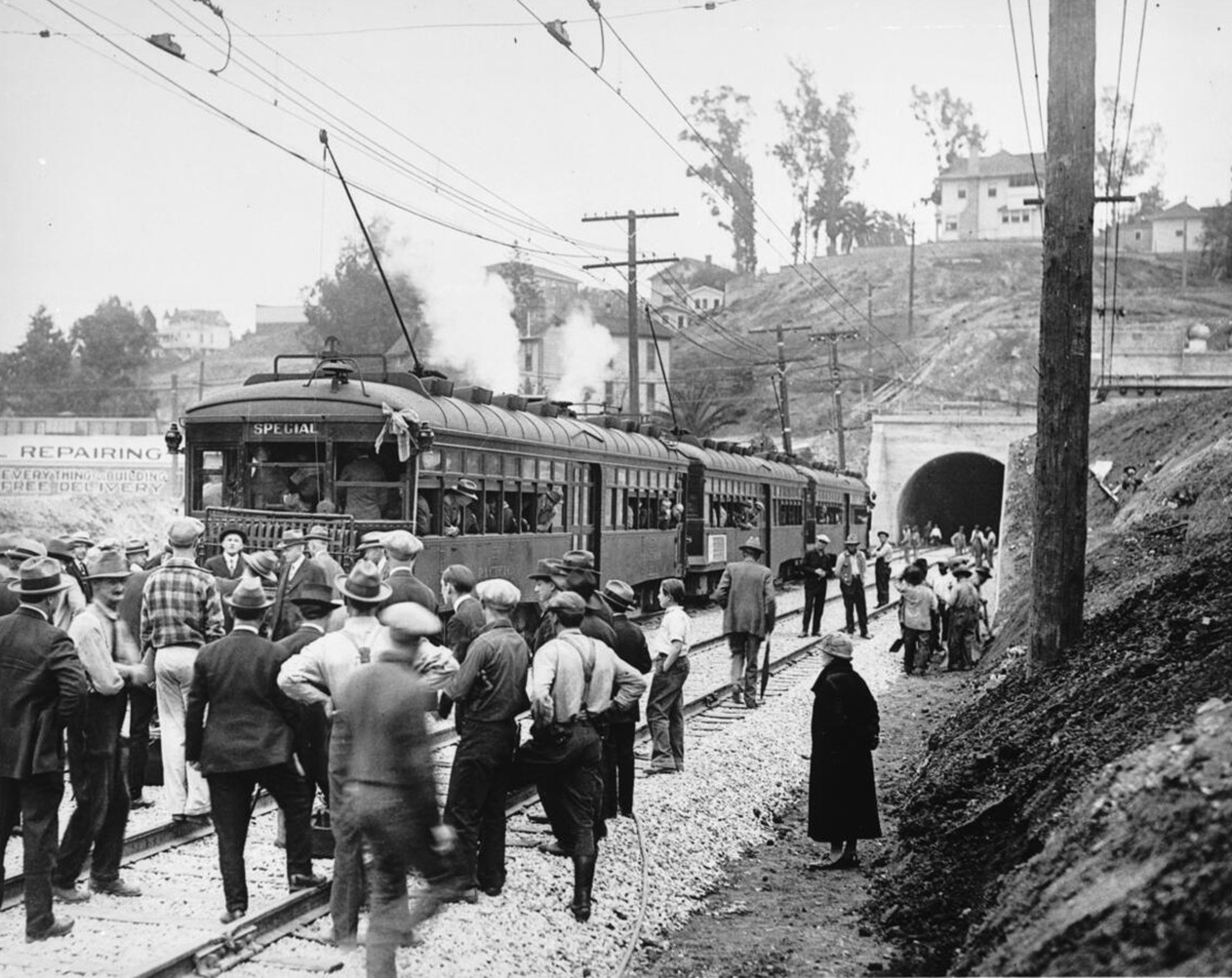 |
|
| (1925)* - Ceremonies commemorating the opening of the Pacific Electric tunnel under Bunker Hill, from Beverly Boulevard to 5th and Hill Street. The line opened to the public on December 1, 1925. |
Historical Notes The Subway Terminal at 417 South Hill Street and its new tunnel were built to move cars faster than street traffic. The terminal opened December 1, 1925, after roughly eighteen months of construction. |
Early Operation
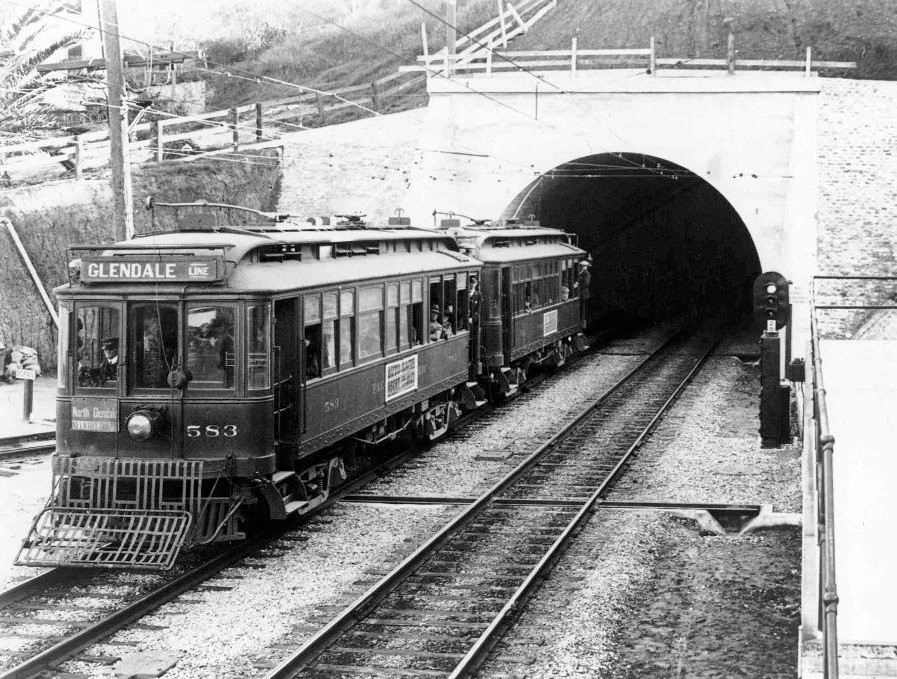 |
|
| (1927)* - Glendale-bound car No. 583 exits the Pacific Electric subway portal. |
Historical Notes Through the late 1920s and 1930s, the subway carried heavy daily traffic. During World War II, service peaked at about 65,000 riders per day and 880 train movements through the tunnel. |
Intersection Complexity and Expansion
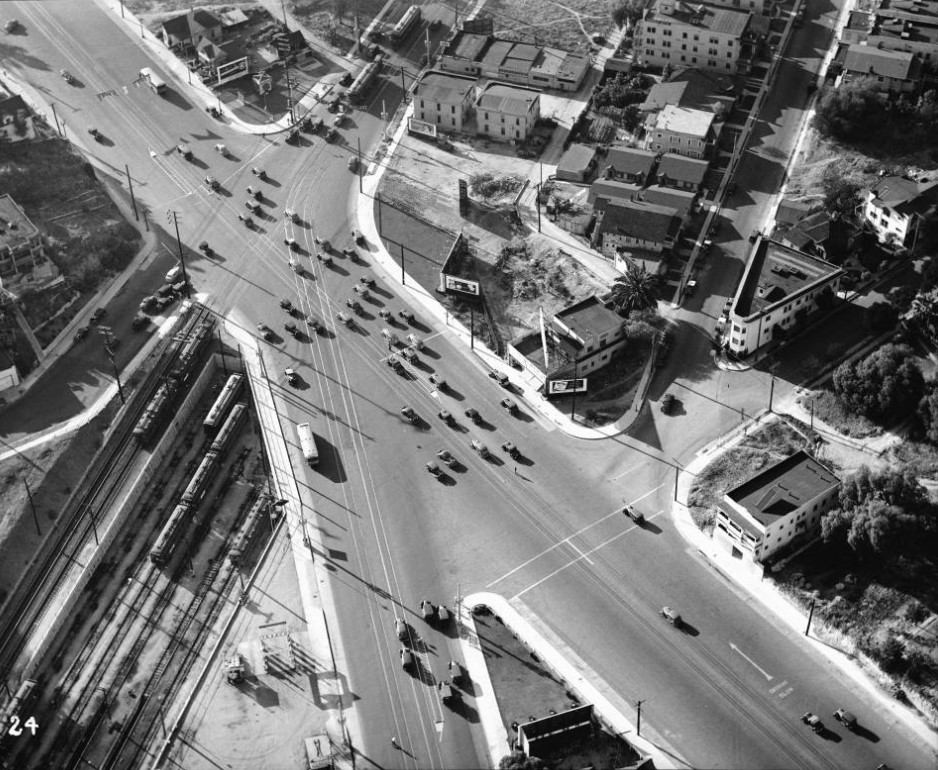 |
|
| (1936)* - Aerial view of the junction of 1st Street, 2nd Street, Beverly Boulevard, and Glendale Boulevard with the Pacific Electric Toluca Yard at lower left. The subway portal is off-frame at lower left. The awkward multi-street meeting often caused congestion and crashes, which led to construction of a new viaduct in the early 1940s. |
Historical Notes The photograph looks northwest over the intersection where east-west 1st became Beverly, and 2nd curved north to become Glendale. The Toluca Yard sat just below the Beverly/1st Street viaduct line. |
Construction of the Viaduct
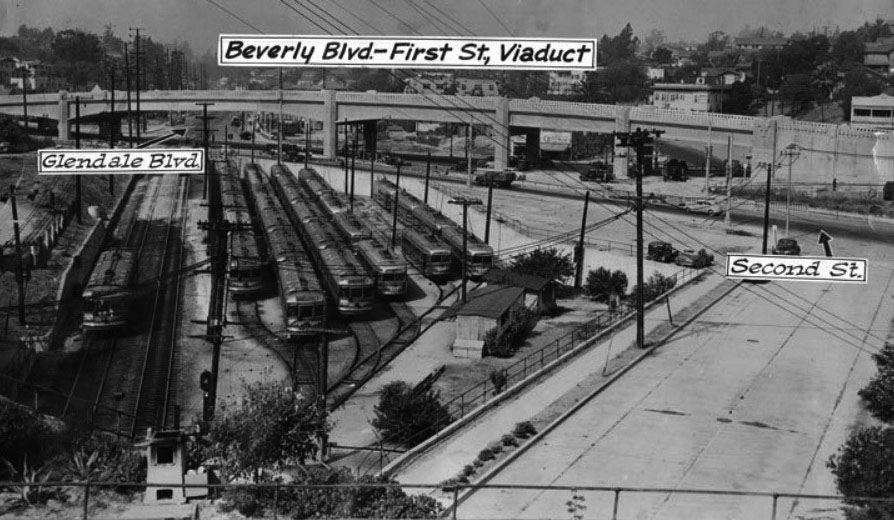 |
|
| (1942)* – View looking north from above the north portal as the new 1st Street/Beverly Boulevard viaduct nears opening. The Toluca Yard is at left. |
Historical Notes The 900-foot viaduct, completed in 1942, carried 1st/Beverly over the knot of streets and tracks below, removing many conflict points and improving traffic flow. Contemporary accounts describe the structure as unusually large for a surface-street junction. |
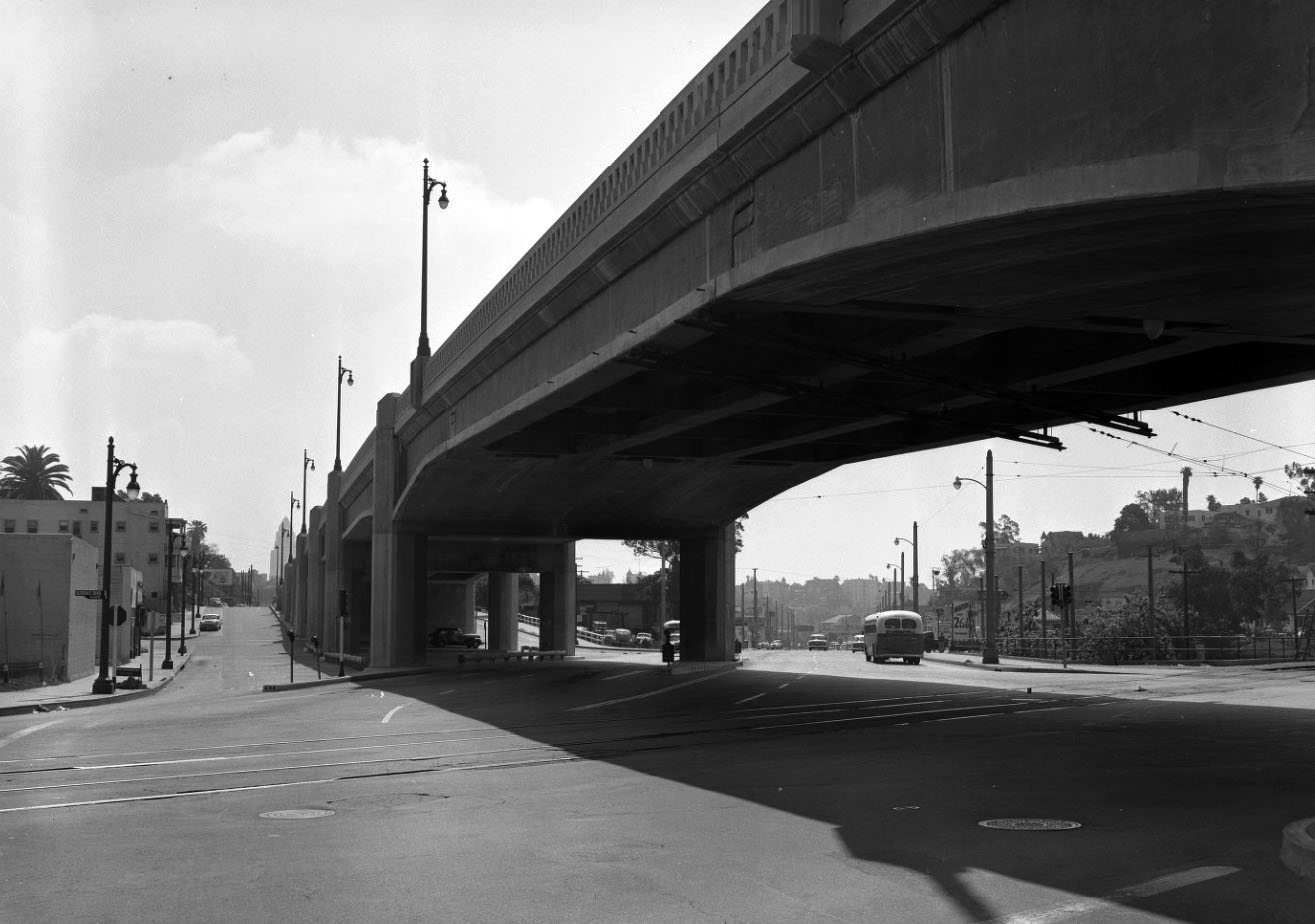 |
|
| (1956)* - First Street–Beverly Boulevard Viaduct over Glendale Boulevard. Tracks to the western portal of the subway run to the right (portal out of frame). Courtesy of the Los Angeles Times Photographic Archive, UCLA Library. |
Historical Notes The viaduct answered years of congestion where as many as six streets and multiple trolley tracks converged. It remained in service as the road network around Westlake and downtown evolved. |
Postwar Years
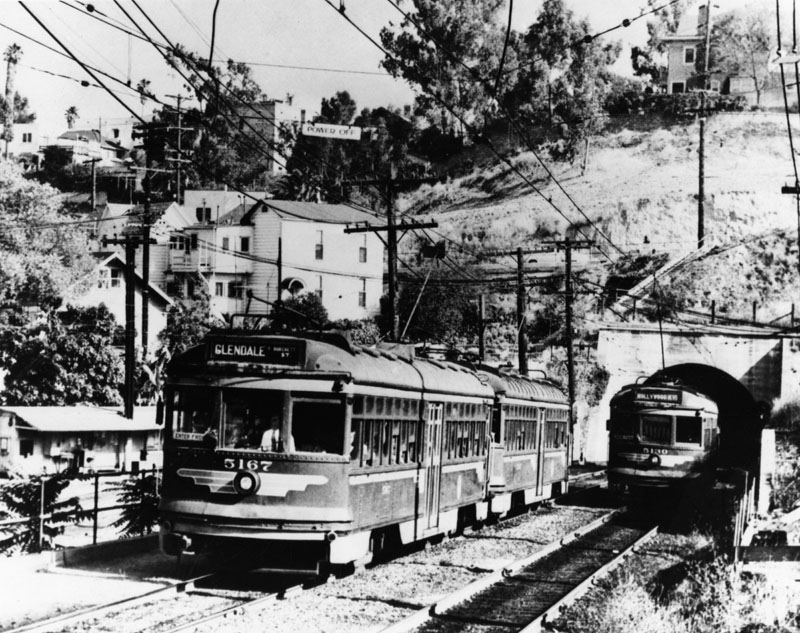 |
|
| (ca. 1950s)^ - Two Pacific Electric cars leave the subway at Beverly Boulevard, one bound for Glendale (Burchett Street) and one for Hollywood Boulevard. Photo courtesy of Tom LaBonge. |
Historical Notes The tunnel carried Red Cars from the Pacific Electric Subway Terminal downtown to points west and north, including Hollywood, Santa Monica, Glendale, and Burbank, without mixing with downtown street traffic. It was an important link that kept Pacific Electric service efficient and separated from the growing congestion above ground. |
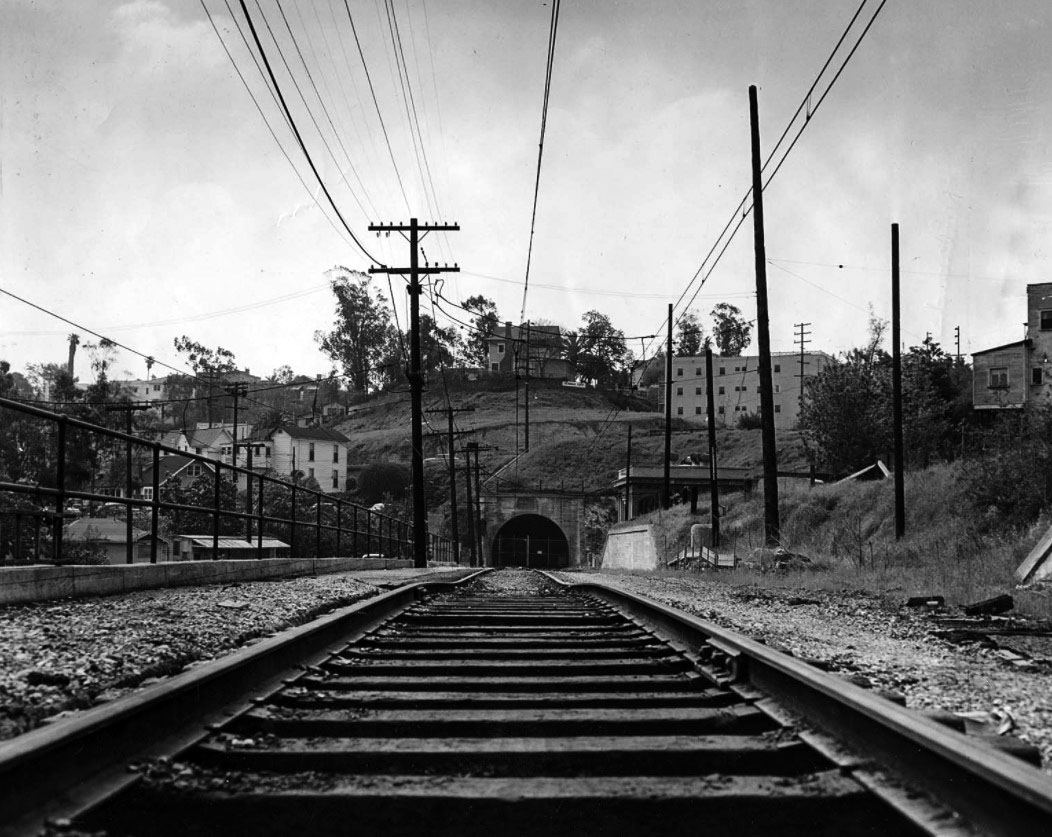 |
|
| (1956)* - View of the old Pacific Electric subway tunnel between Glendale Boulevard and the Subway Terminal. Passenger service ended in June 1955. |
Historical Notes The final passenger run took place on June 19, 1955, with a banner reading “To Oblivion” hanging from the lead car. Soon after, the rails were removed, the terminal was closed, and the Toluca Substation was disconnected—marking the end of Pacific Electric’s subway era. |
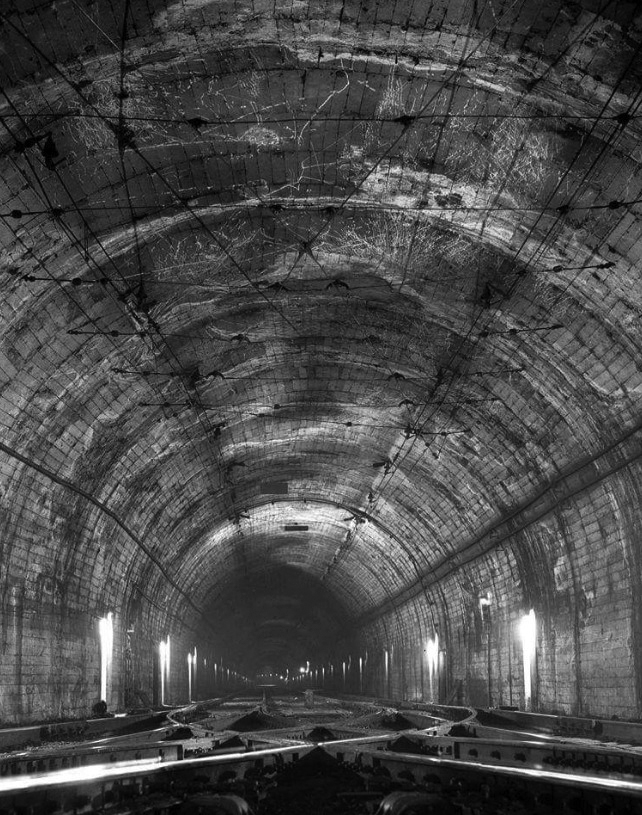 |
|
| (ca. 2000)* – View showing the 1925-built, one-mile Pacific Electric tunnel under Bunker Hill before the north end was sealed. |
Historical Notes In the 1960s, the city explored various uses for the old tunnel, including car storage and later as an emergency shelter. The only major change came in 1967, when a section between Flower and Figueroa Streets was filled in to make room for the Bonaventure Hotel’s foundation. |
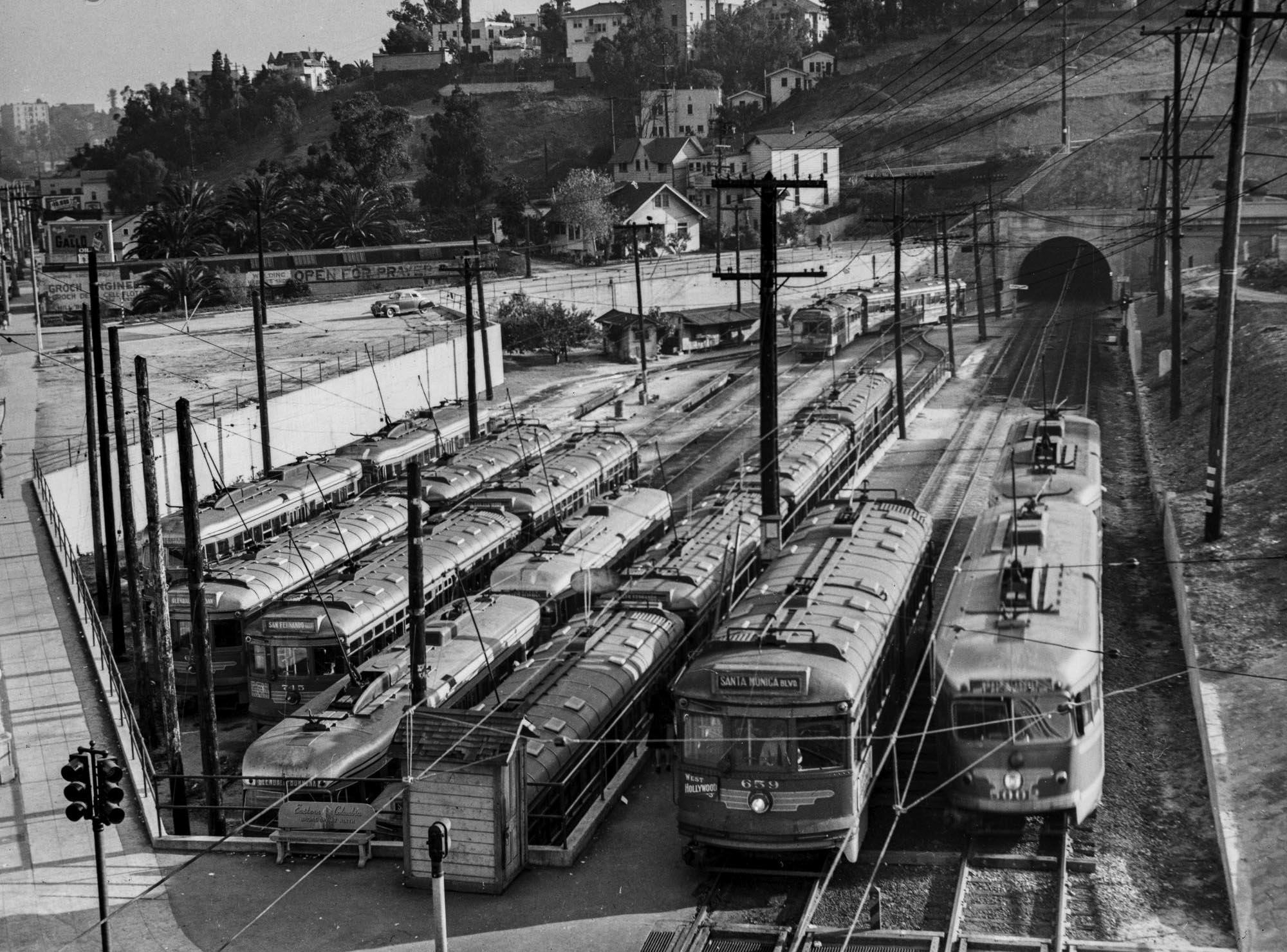 |
|
| (1950s)* - Pacific Electric cars pass the Toluca (Belmont) Yard as seen from the First Street Bridge. Within a few years, the yard was shut down and abandoned. Photo by Ralph E. Melching. |
Historical Notes After the Pacific Electric system shut down, both the yard and tunnel saw limited use before falling into neglect. Over time, the site became overgrown and largely forgotten, a silent reminder of the once vast electric rail network that served Los Angeles. |
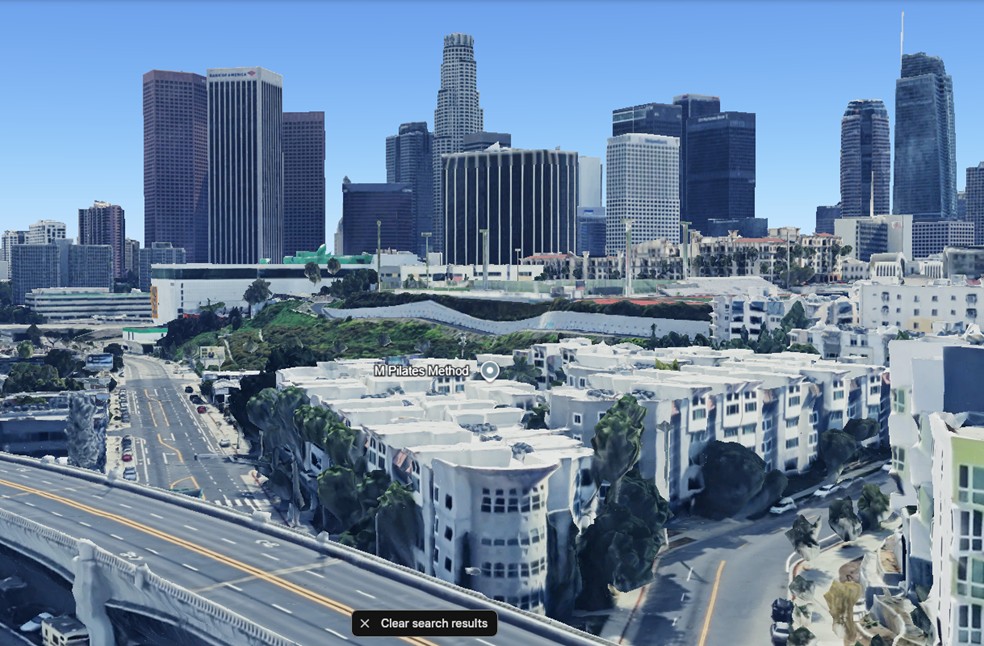 |
|
| (2023)* – Contemporary view looking southeast toward the site where the Toluca (Belmont) Pacific Electric Yard and Tunnel once stood. The area is now occupied by apartment buildings, with the downtown Los Angeles skyline rising in the background. |
Historical Notes The former Toluca (Belmont) Yard is now covered by apartment buildings and streets near Glendale and Beverly Boulevards. The tunnel entrance, long sealed, still extends underground toward downtown beneath the western slope of old Bunker Hill, a hidden remnant of Pacific Electric’s once-busy subway system. |
Then and Now
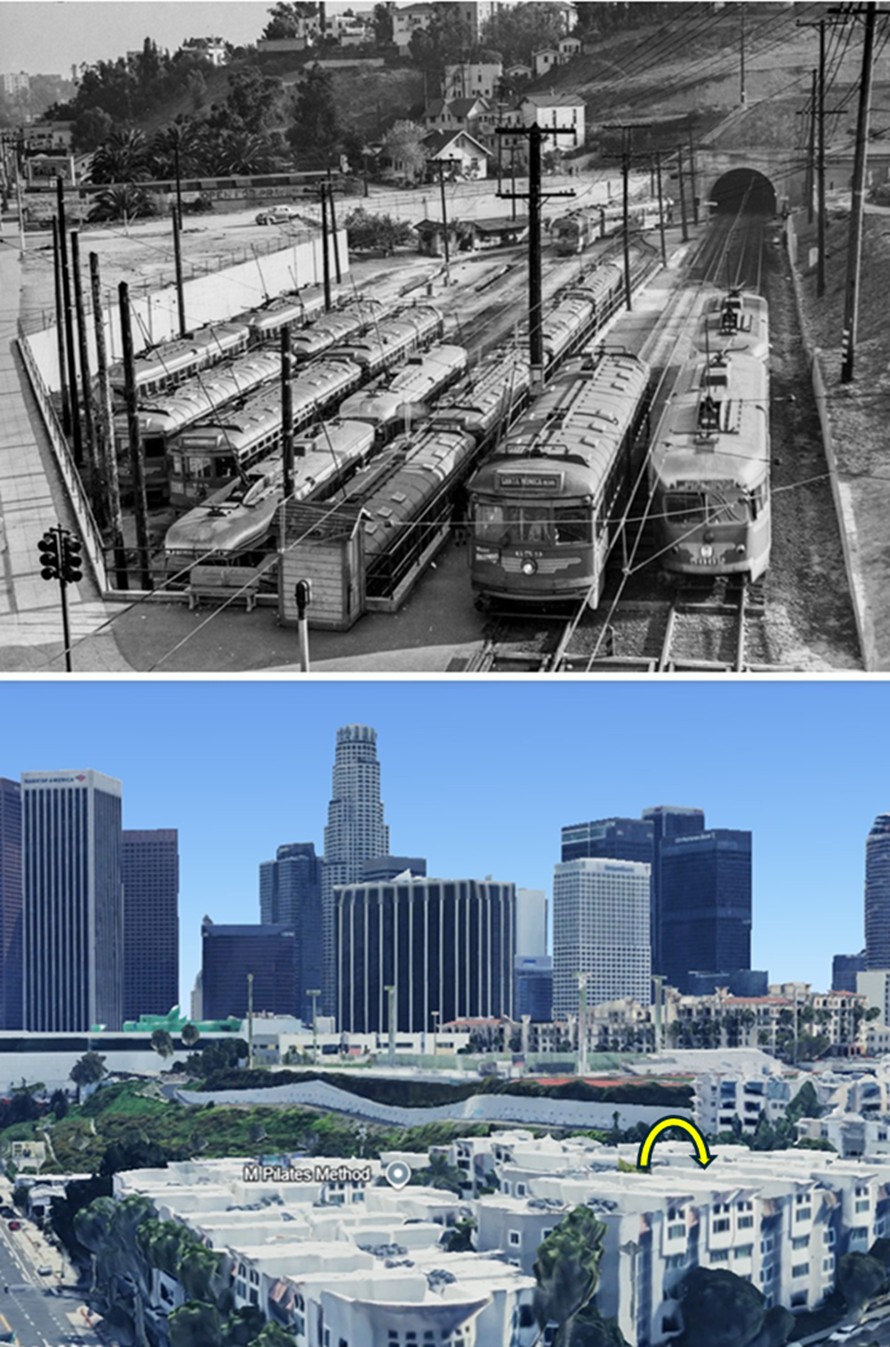 |
|
| (1950s vs. 2023)* – A “Then and Now” view looking southeast from the First Street (Glendale Boulevard) Viaduct toward the Toluca (Belmont) Pacific Electric Yard and Tunnel. Photo comparison by Jack Feldman. |
Historical Notes Once filled with Red Cars awaiting service, this area is now occupied by apartment buildings. The modern view is taken from a slightly higher elevation, with the approximate location of the now sealed-off tunnel highlighted by a yellow semicircle. |
Abandonment and Urban Change
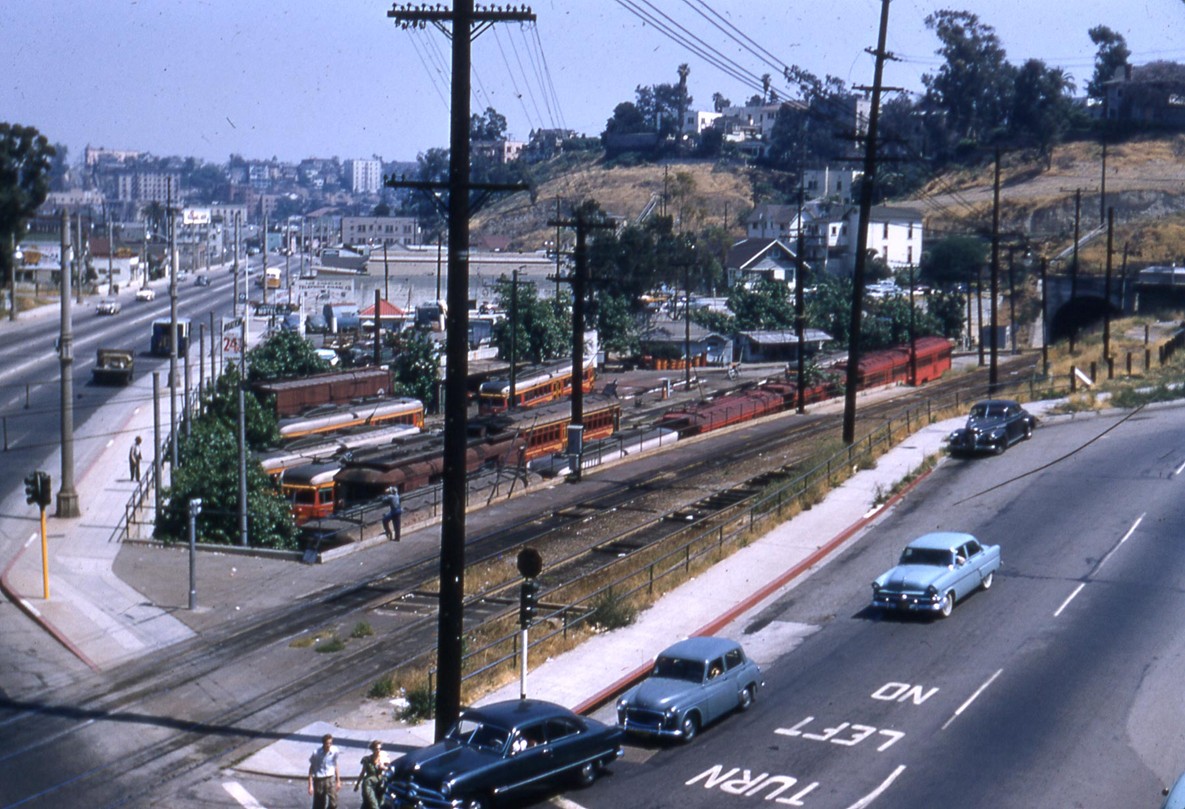 |
|
| (1955)* – View showing the Pacific Electric Subway Yard at Glendale Boulevard and Beverly Boulevard, where Red Cars paused before entering the tunnel beneath Bunker Hill to the Subway Terminal Building at 4th and Hill Streets. The tunnel portal appears at the far right. This small yard served as storage and a turnaround for interurban cars on the Glendale–Burbank and Hollywood lines. Photo from the Ralph Cantos Collection. |
Historical Notes This yard was commonly called Toluca Yard in company records. It sat just west of the 1st/Beverly viaduct and alongside Glendale Boulevard. |
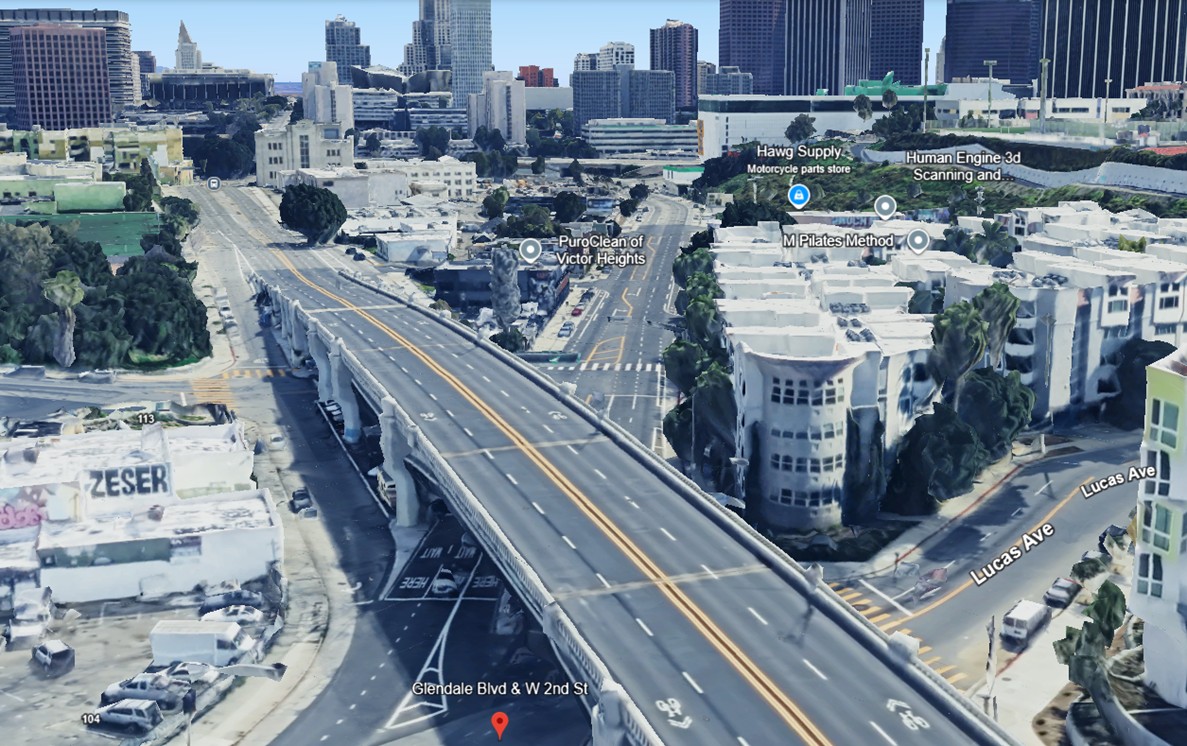 |
|
| (2023)* – Google Earth view shows what exists today on the site of the Pacific Electric Subway Yard. The yard and portal have been replaced by apartments and the curve of Lucas Avenue. Glendale Boulevard and West 2nd Street are visible at the bottom. |
Historical Notes The former yard was redeveloped as Belmont Station Apartments, with the portal sealed and painted with a Red Car mural by artist Tait Roelofs. The Toluca Substation façade survives at the edge of the property. |
Then and Now
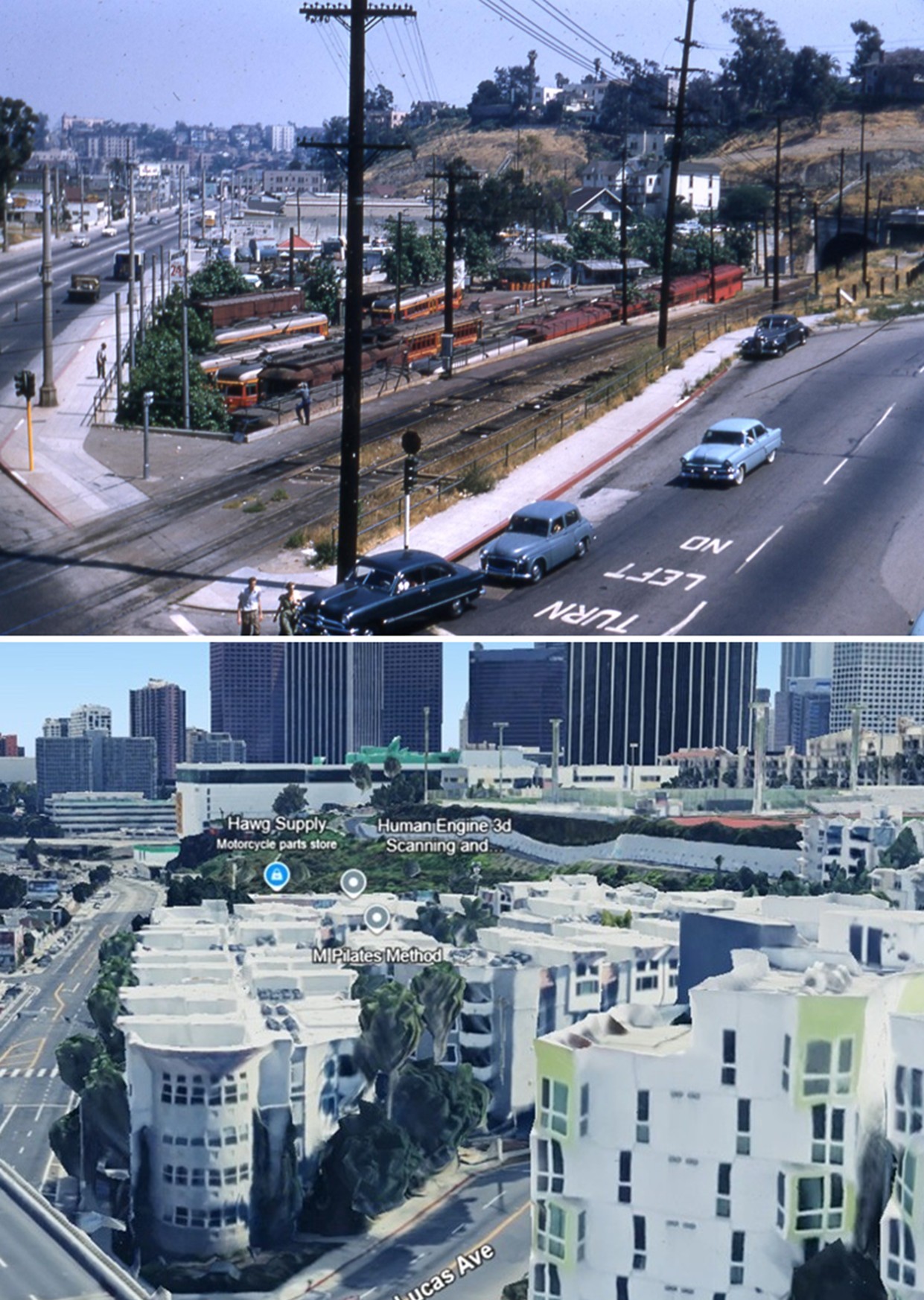 |
|
| (1955 and 2023)* – Comparison views showing the Pacific Electric Subway Yard at Glendale and Beverly (top) and the site today (bottom). In 1955, Red Cars paused here before entering the tunnel. Today the site contains apartments along Lucas Avenue; Glendale Boulevard and West 2nd Street remain in the street grid. Photo comparison by Jack Feldman. |
Historical Notes The tunnel alignment under Bunker Hill still exists but is sealed in sections due to later building foundations; the Subway Terminal survives as Metro 417 apartments, while Pershing Square’s Metro station lies nearby. |
Later Years and Preservation
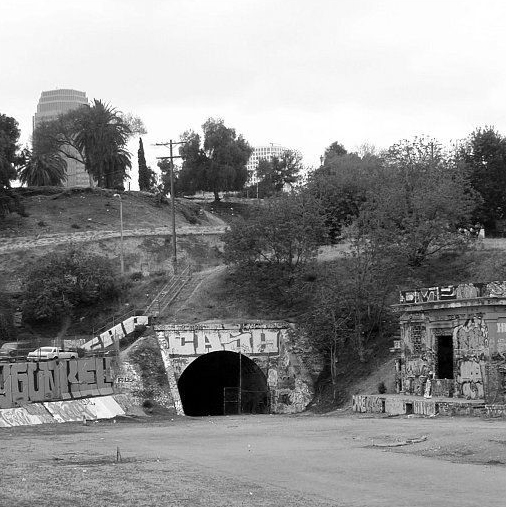 |
|
| (ca. 2003)* - Belmont Tunnel and Toluca Substation abandoned and covered with graffiti. |
Historical Notes For decades after closure, the site was used for vehicle storage and considered as a civil-defense shelter. By the 1980s–1990s it became a well-known graffiti spot. In 2002 a developer purchased the property, built apartments (opened 2008), preserved the substation façade, and sealed the portal with the Red Car mural. In 2005 the complex of remnants (Belmont Tunnel / Toluca Substation and Yard) was designated Los Angeles Historic-Cultural Monument No. 790. Click HERE for contemporary aerial view. |
* * * * * |
Silver Lake
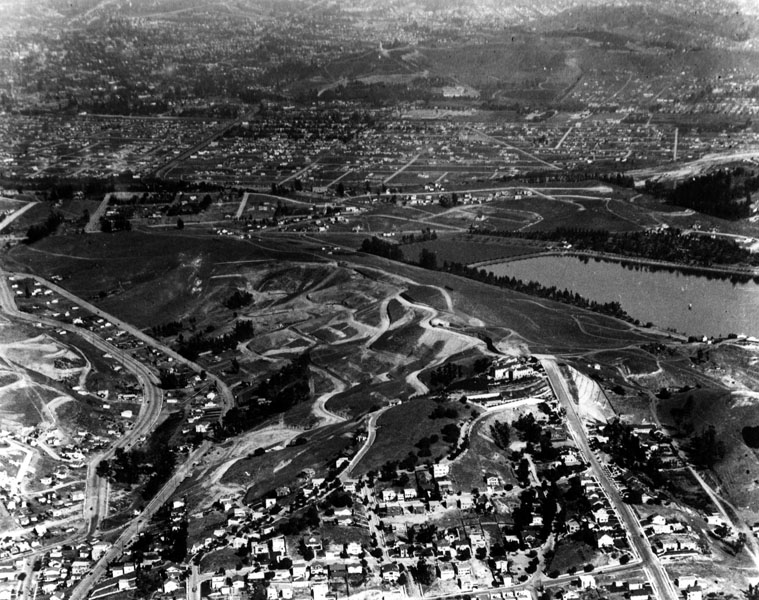 |
|
| (ca. 1924)^ - View of the Silver Lake Reservoir and surrounding area, with streets readied for houses. View is looking north. |
Historical Notes In 1896 Herman Silver was elected to the Los Angeles City Council and was soon voted its President – acting often as the Mayor pro tem of the city. In 1902, he City Council created a the 1st Water Commision and named Herman Silver as its Chairman. Silver was instrumental in planning a reservoir Northeast of Downtown that would combine stored water with a development of nice homes and parks. The next Mayor came into office and failed to re-appoint Silver to the Water Board – for political reasons. The City Council reacted – praising Herman Silver by naming the new water project after him. The area has been known, ever since, by the name – Silverlake.^**# |
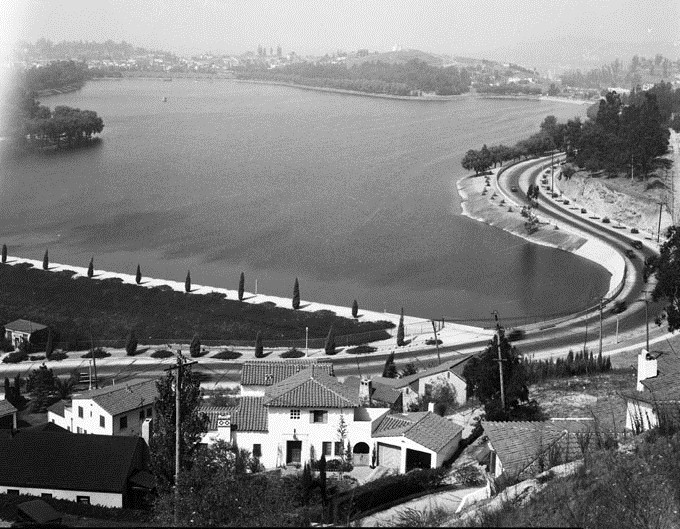 |
|
| (1930)* - Silver Lake Reservoir - Silver Lake Reservoir was named for Herman Silver, first president of the Board of Commissioners, Domestic Water Works System. He served from 1902-1903. The reservoir is a earth fill dam, asphalt concrete, with paved slopes. It was put into service in May 1908. |
Historical Notes In 1989, the Silver Lake Reservoir was designated LA Historic-Cultural Monument No. 422 (Click HERE to see complete listing). |
Click HERE to see more in Early LA Water Reservoirs |
Los Feliz
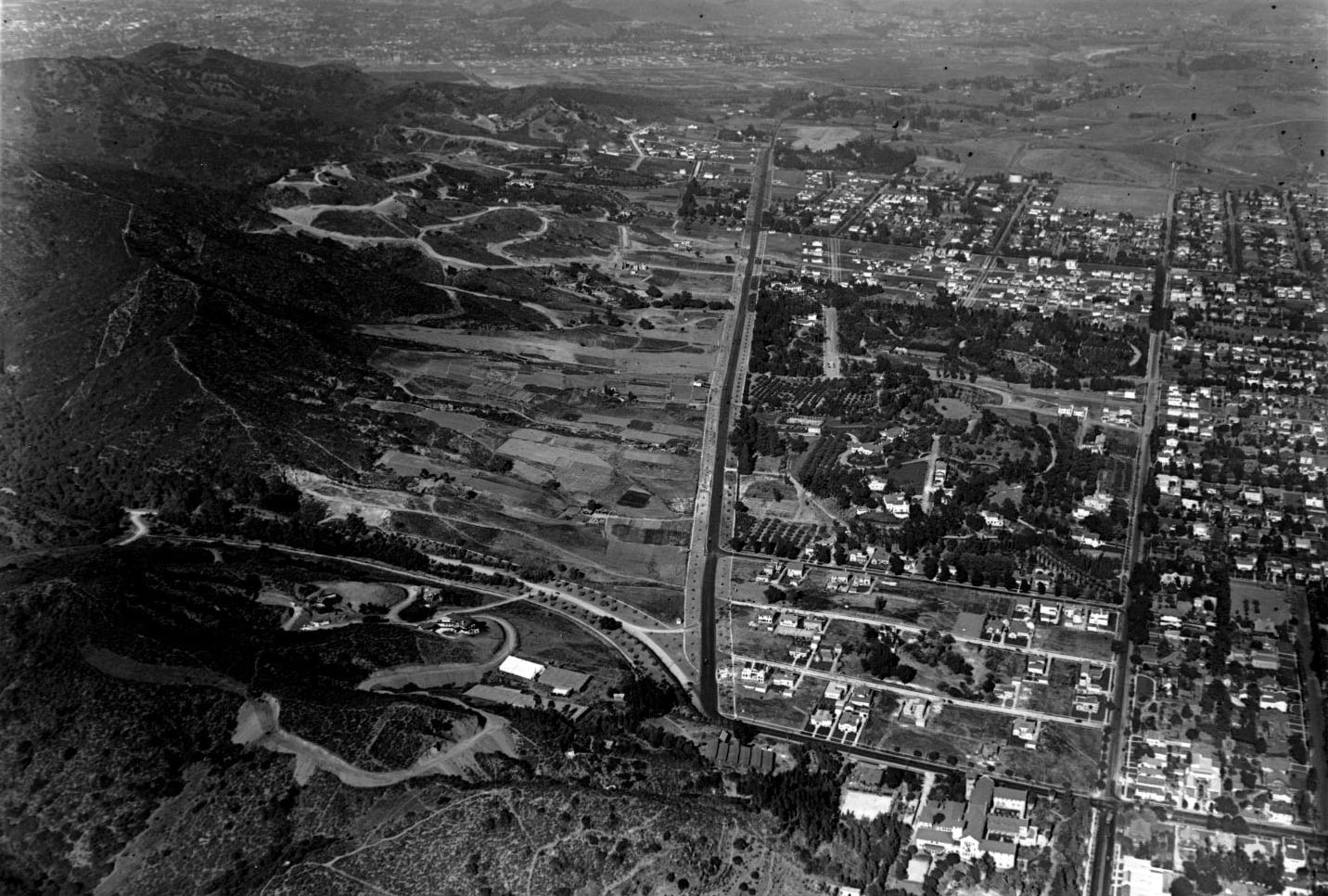 |
|
| (1922)^^+ – Aerial view looking east on Los Feliz Boulevard from above where Western Avenue makes a sharp turn into Los Feliz. Franklin Avenue runs away from the camera on the right. |
Historical Notes The west-east thoroughfare runs through Los Angeles and Glendale. It starts off at its east most point at Glendale Avenue as Los Feliz Road. After passing the railroad tracks in Glendale west most section, it enters Los Angeles and changes to Los Feliz Boulevard. Los Feliz passes through Atwater Village and Griffith Park. After Griffith Park, it swerves to a north-south street and ends. It then merges and becomes Western Avenue which in turns runs all the way down to the San Pedro area. Los Feliz Boulevard was named for Rancho Los Feliz, one of the first land grants made in California. Corporal Feliz, a veteran of the Anza Expedition of 1776, was a guard at the Pueblo of Los Angeles. In 1787 Governor Fages appointed Feliz as Comisionado of the Los Angeles Pueblo, giving him the powers of Mayor and Judge. For his service, Feliz was granted Rancho Los Feliz.*^ |
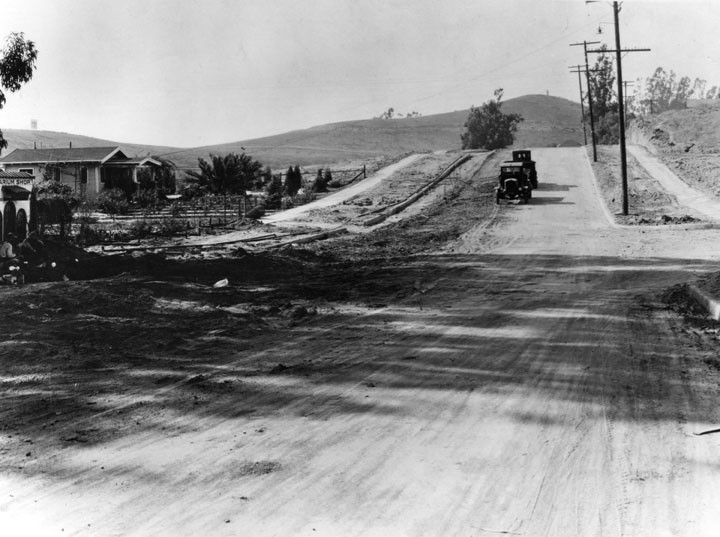 |
|
| (1920)^ – View showing two houses in a new tract south of Los Feliz Boulevard and east of Vermont Avenue which sold out in one day in 1920. It took two months to put in the streets. |
Historical Notes The Los Feliz neighborhood has been home to movie stars, musicians, and the Hollywood elite. It boasts some of the best-known residential architecture in the city, including two homes designed by Frank Lloyd Wright—the Ennis House and the Hollyhock House—and Richard Neutra's Lovell House. Mickey Mouse was "born" in Los Feliz: Walt Disney drew his first image of the now-legendary character in the garage of his uncle's house, on Kingswell Avenue between Vermont Avenue and Rodney Drive. Disney's first animation studio was also on Kingswell Avenue, just down the street from his uncle's house and east of Vermont Avenue. Disney's second, larger studio (now a Gelson's supermarket) was at the corner of Griffith Park Boulevard and Hyperion Avenue, on the Silver Lake side of the Los Feliz – Silver Lake boundary.*^ |
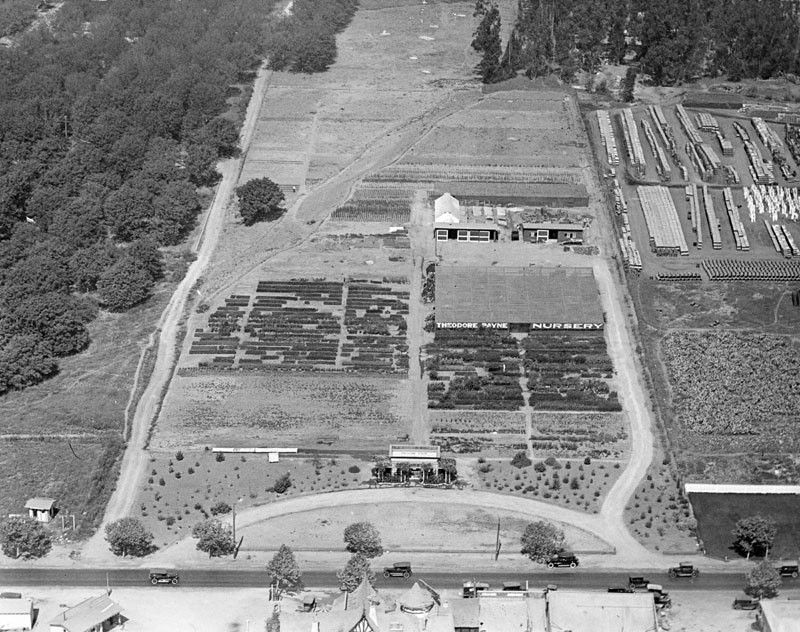 |
|
| (ca. 1924)^ – Aerial view looking northwest from above Los Feliz Boulevard in Atwater Village. The Theodore Payne Nursery is seen, as well as part of Tam O'Shanter Restaurant (lower middle). Franciscan Pottery Manufacturing is at upper-right. |
Historical Notes Theodore Payne was an English horticulturist, gardener, landscape designer, and botanist. He is known for urging the use of California native plants and lecturing across the state on preserving the wild flowers and landscapes native to California. The 10-acre Payne Nursery opened in 1922 and was located at 1969-99 Los Feliz Boulevard in Atwater Village, across the street from the Tam O’Shanter Restaurant and adjacent to property owned by Gladding McBean, manufacturers of Franciscan Pottery. Payne obtained an architectural rendering from Myron Hunt for the nursery building and developed a full-service horticultural operation. He propagated and sold plants in the nursery, and had enough acreage to grow row crops of wild flower and collection of seed that he would then sell to the public.*^ |
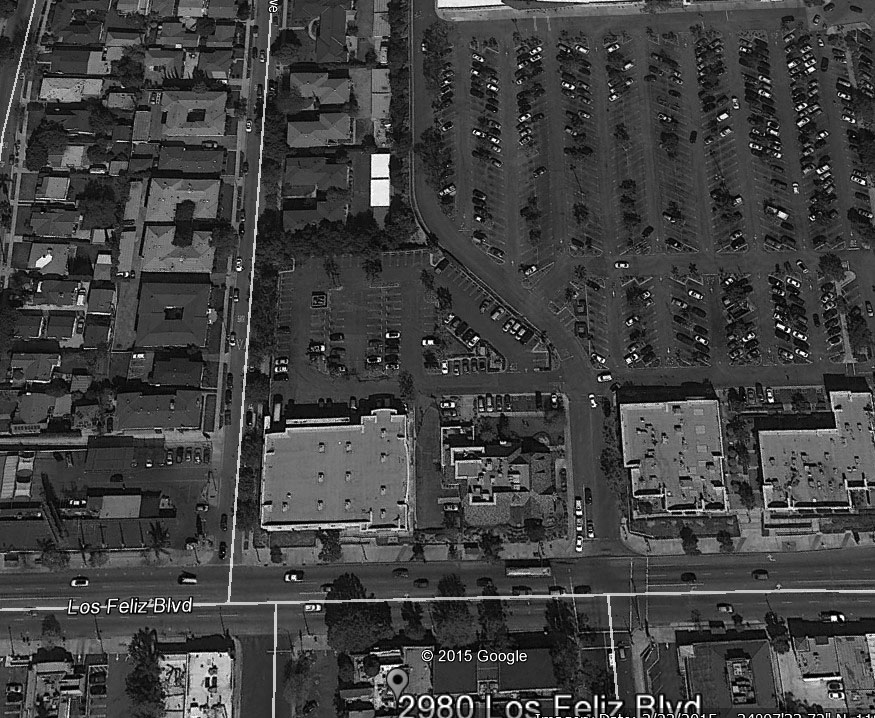 |
|
| (2015)##^* – Google Earth view looking northwest from above the Tam O'Shanter Restaurant . The Franciscan Metro Shopping Center is now where the old Theodore Payne Nursery and Franciscan Tile Company used to be. |
Early Gas Stations
 |
|
| (ca. 1920s)* - Service station on north Vermont Avenue shows three automobiles parked next to the gas pumps as two attendants fill them up with "filtered gasoline". Other services such as polishing and simonizing are offered at this station, possibly named "Ventura Gasoline". |
 |
|
| (ca. 1925)^^ - Exterior view of a Richfield Service Station. Four gasoline pumps stand below a large covering which reads "Richfield Service Station, Richfield Oil Company". Between the gasoline pumps a man in a lightly-colored uniform can be seen in the doorway of the shop which stands behind the station with the label "Open day and night". A second man in an identical uniform tends to an automobile on the right. |
Click HERE to see more Early Views of LA Gas Stations |
 |
|
| (1925)^^ - View showing a Yellow Cab with taxi driver inside, in front of a building at 427 South Normandie. |
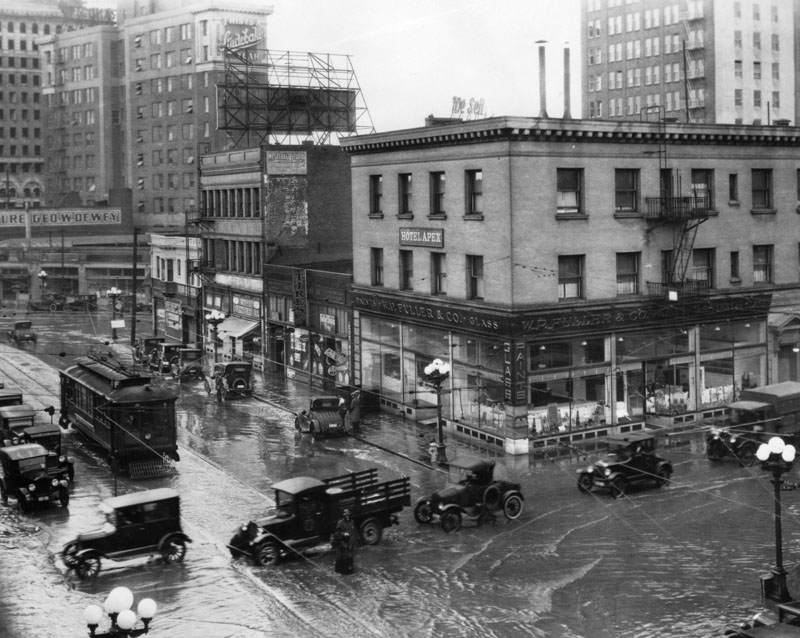 |
|
| (1925)^ - A wet policeman directs traffic in a flooded intersection at Main and 10th Streets in 1925. He is dressed in rain gear. The Hotel Apex is on the corner, as well as W. P. Fuller & Co., paints and glass. |
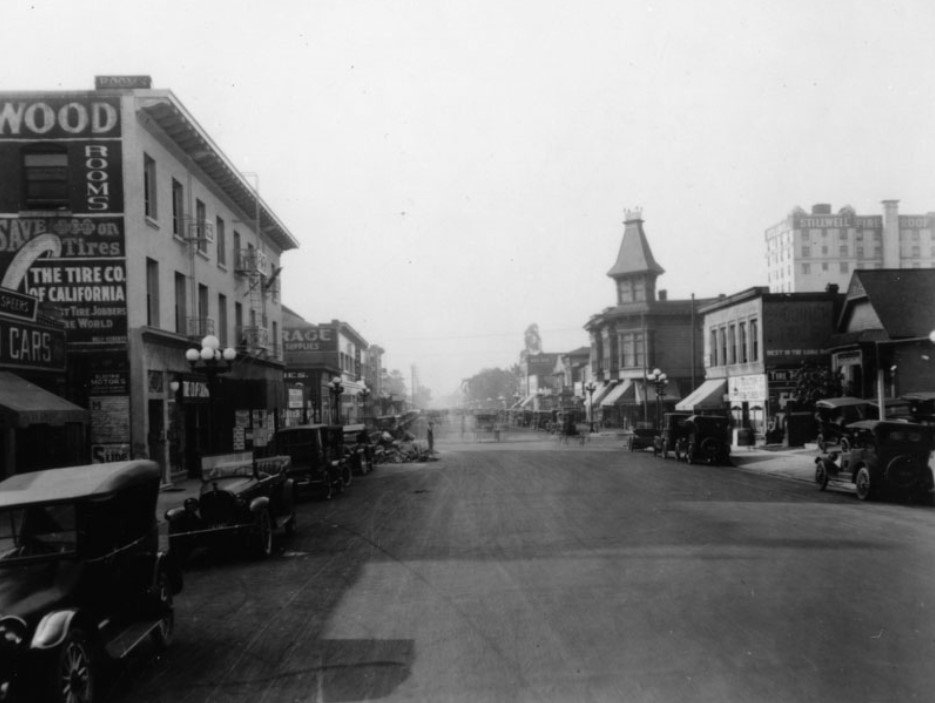 |
|
| (ca. 1925)^ – View looking south on Olive Street between 7th and 8th streets. The rear of the Stillwell Hotel shows at right, located at 838 So. Grand Ave. Another hotel is at left, and various small businesses and cars line the street. A pile of debris is in the street at left, and men are working. Note the ornate tower/steeple of the building on the southwest corner of Olive and 8th streets. |
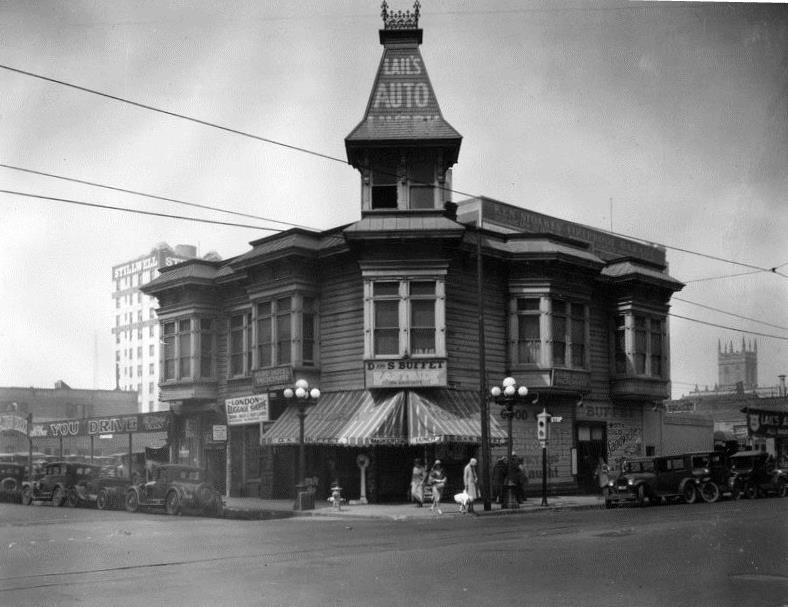 |
|
| (1927)^ - View showing the southwest corner of 8th and Olive streets. The building shown has several signs advertising: "Lail's Auto Livery" on the steeple as well as on either ends of the building; "Ward Hotel rooms" below two windows, also on both sides of the building; "London Luggage Shoppe" with an entrance on the left side; and "D and S Buffet Eastside" prominently in the middle, offering hot and cold sandwiches. The Stillwell Hotel as well as a church tower can be seen in the background |
 |
|
| (1927)^– View looking at the northeast corner of Grand Avenue and 9th Street, where one end of the Stillwell Hotel can be seen on the left. "FIREPROOF HOTEL" is painted high on the wall, in large capital letters. Mid-photo in the background, a cupola peeks from behind another building, the sign on it reads: "Hill Street Theatre". This refers to the RKO Hill Street Theater, which occupied the northwest corner of 8th and Hill Street. On the corner stands Red Crown Gasoline station, offering Zerolene and Mobiloil. It’s owned and operated by Ed. Willumsen, a "correct lubrication specialist"; he possibly also owns Ed's Auto Livery, which is adjacent to the gasoline station. Several cars can be seen waiting for the light to change along 9th Street. |
Historical Notes The 250-room Stillwell Hotel was built in 1906 and is located at 838 S. Grand, between 8th and 9th. The RKO Hill Street Theater, occupied the northwest corner of 8th and Hill Street. It had a seating capacity of 2,219 and ran for 46 years, from 1922 to 1968, when it was demolished.* |
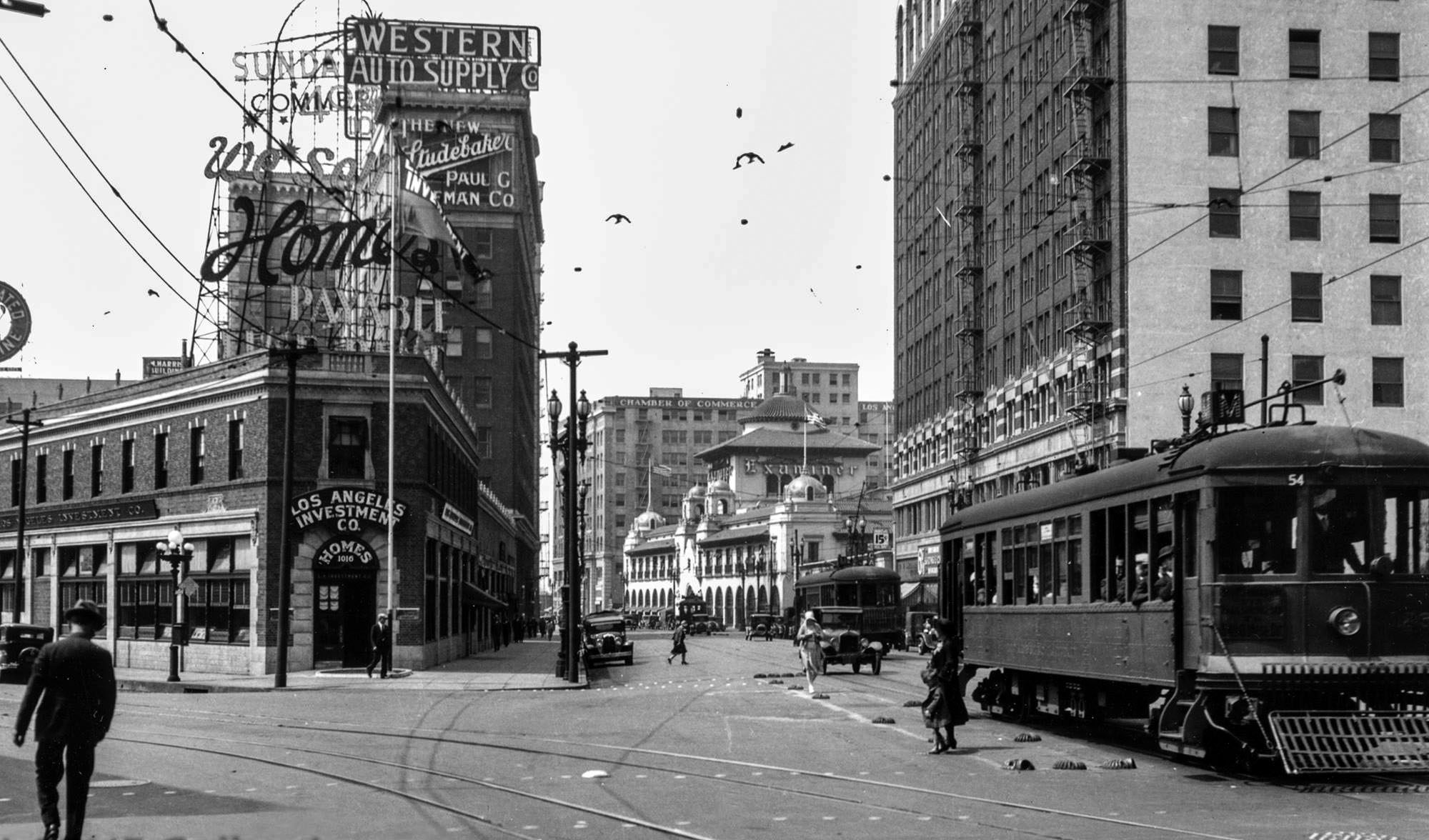 |
|
| (1920s)++++ - View looking south on Broadway from 10th Street (later Olympic) showing two streetcars of the LA Railway's "M Line" with the Examiner Building in the background on the S/W corner of Broadway and 11th Street. The Los Angeles Investment Co. and Western Auto Supply are at left, followed by the Paul G Hoffman Studebaker sales office. |
Historical Notes 10th Street was renamed Olympic Boulevard for the 1932 Summer Olympics, as that was the occasion of the tenth modern event. *^ |
* * * * * |
Eagle Rock
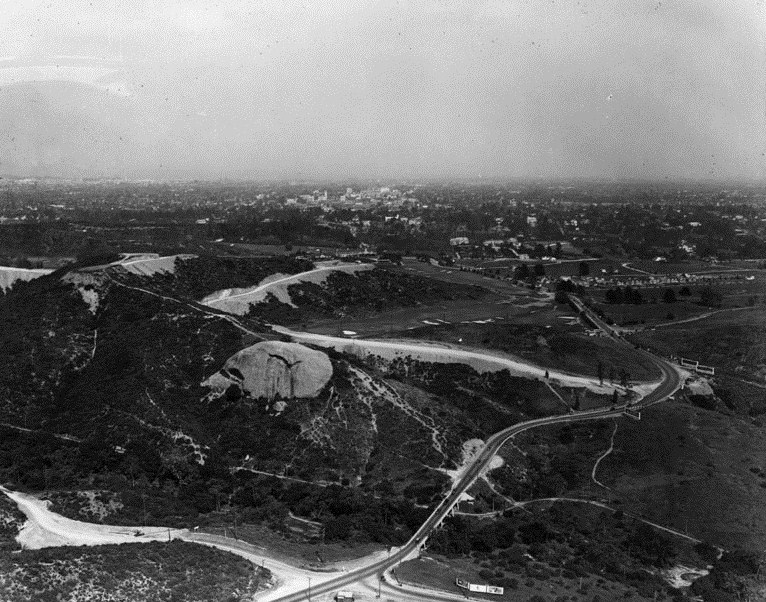 |
|
| (1925)^ - Eagle Rock is a neighborhood in northeastern Los Angeles that derives its name from a massive boulder (seen here) at the district's northern edge. In this photo looking east toward Pasadena, the outline of a flying eagle is clearly shown on the face of a massive boulder that locals call "The Rock". Created from local hot springs millions of years ago, this impressive rock looms above the valley below, creating an eagle-shaped shadow every day around noon. |
Historical Notes In the mid to late 1770s, Native Americans inhabited the caves at the base of The Rock, formerly known as La Piedra Gorda (which translates to "Fat Rock"). 100 years later, in 1874, desperadoes used these same caves, including the infamous bandit Tiburcio Vasquez, who was said to have used The Rock as a hideout and to store his loot. In 1906 Eagle Rock Valley, as it was known then, became an independent city and was incorporated in 1911 with a population of approximately 600; in 1914 it also became home to Occidental College, designed by famed architect Myron Hunt. In 1962 this Eagle Rock landmark was appraised at $250,000 and on November 16th of that same year, The Rock was declared Los Angeles Historic Cultural Monument #10 (Click HERE to see the LA Historic-Cultural Monuments List), but it did not actually belong to the community until 1995 when the city of Los Angeles officially purchased it for close to $700,000.^ |
 |
|
| (1920s)^ - Panoramic view looking northeast along Colorado Boulevard, which is a major east-west thoroughfare that runs through Eagle Rock; commercial buildings and residential homes are on either side. |
Historical Notes In 1921 a circular pavilion nicknamed "The Merry-Go-Round" was built in the center of the city at the intersection of Colorado and Eagle Rock Blvd (seen toward the right, where the street bends). This structure was to shelter and protect streetcar travelers; it was razed in the 1930s as automobile traffic became heavier.^ |
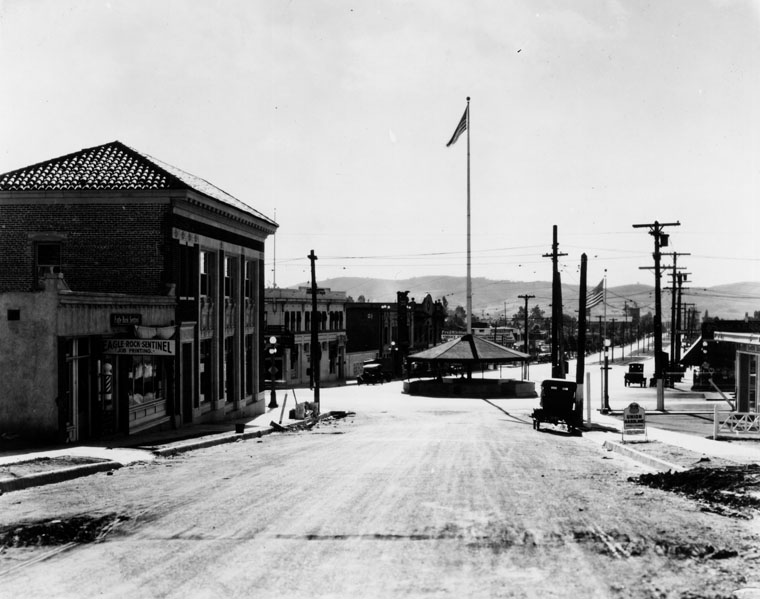 |
|
| (1920s)^ - View of the "Merry-Go-Round" Pavilion at the intersection of Colorado and Eagle Rock boulevards. |
* * * * * |
Legion Ascot Speedway
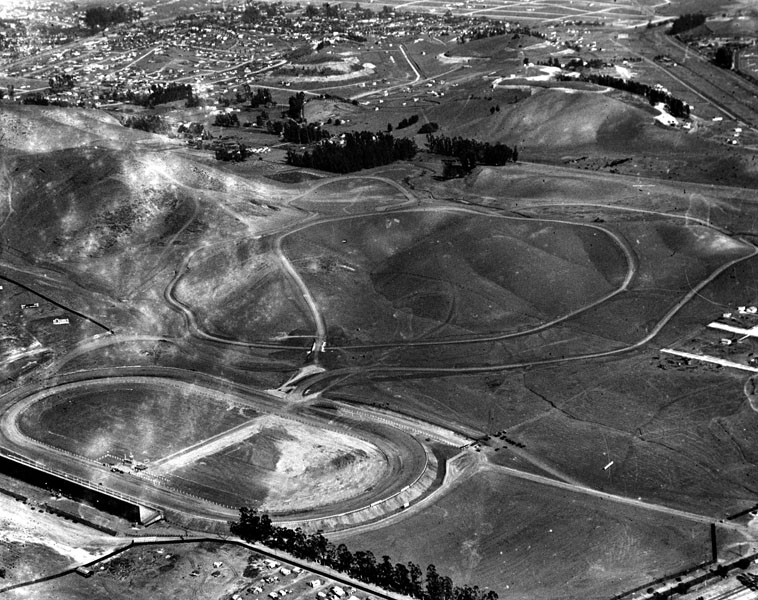 |
|
| (1925)^ - Aerial view of the Legion Ascot Speedway located along Soto Street from Valley Blvd. to Multnomah St. The speedway operated between 1924 and 1936 in the Lincoln Heights area. |
Historical Notes The five-eighths mile Ascot Speedway began life as the New Ascot Speedway on January 20, 1924. The banked oval that was originally dirt but constant applications of road oil soon produced a surface that was similar to pavement. The cars that raced at Ascot throughout the years were the ancestors of what we today call "sprint cars". The hill in the center of photo, with the dirt loop going around it, would become the future site El Sereno's Wilson High School. This same hill was the location for the never completed El Sereno Country Club, which began construction in 1926. Legendary golfer Harry Cooper was the clubs lead golfer and even opened a golf store near the premise. However, by 1928 the Country Club was mired in lawsuits as business partners sued each other for various differences. To this day many former residents remember the catacombs, swimming pool, and foundation of the El Sereno Country Club. *^# |
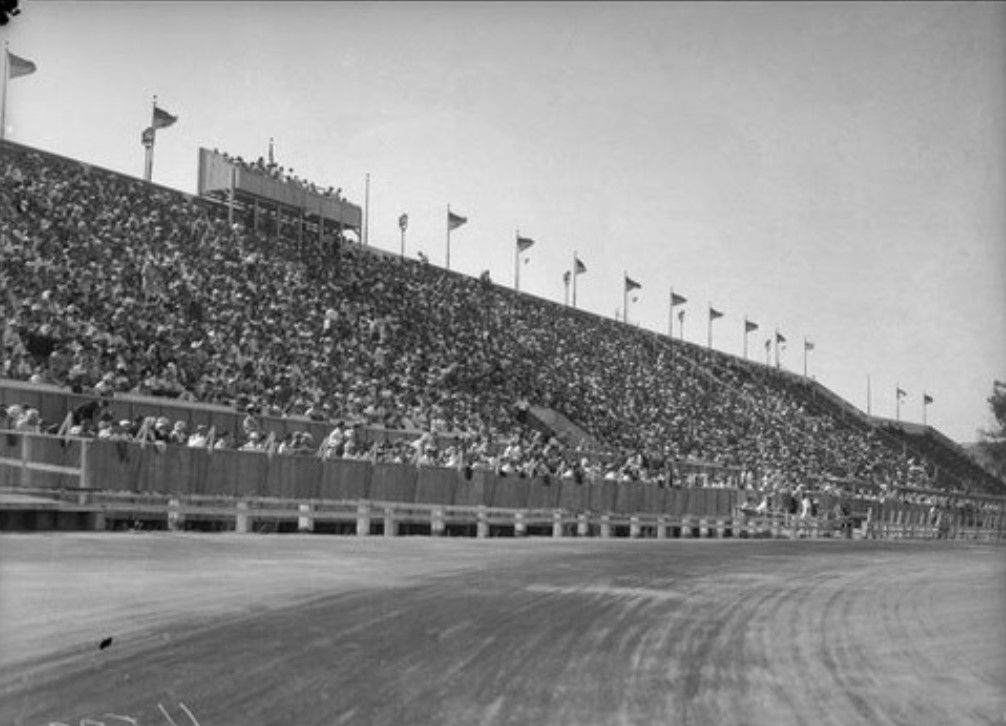 |
|
| (1935)^x^ - Crowd watching at the Legion Ascot Speedway as Bob Swanson and Rex Mays race. |
Historical Notes From 1924 there had been several people running the race track, but in 1928 the Glendale American Legion Post started promoting and bringing in cars and drivers from the American Automobile Association (AAA). In those days the AAA controlled all the major speedways including Indianapolis Speedway. A major speedway was born and it was called Legion Ascot Speedway. Under the promotion of the Legionnaires the crowds soon grew to over 10,000 making large purses and hot competition. Races were held on Sundays and Wednesday nights under the lights. Auto racing (also motorcycle racing) was increasingly popular in the 1920s and 30s. Two speedways would also be built on the West Side of Los Angeles: Beverly Hills Speedway and Culver City Speedway. |
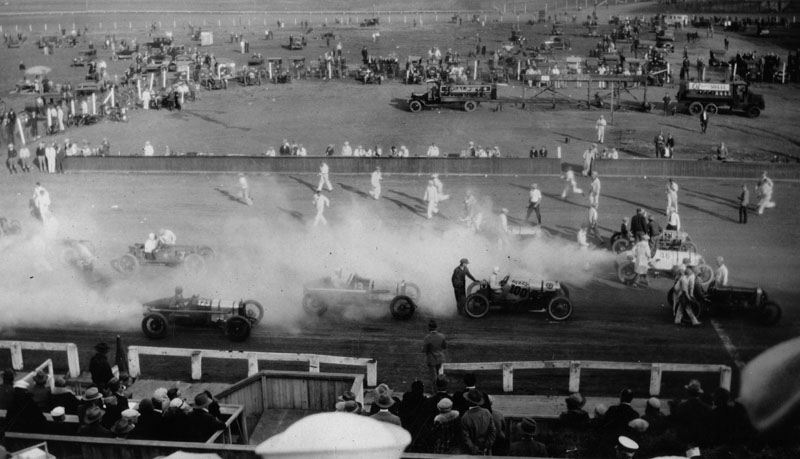 |
|
| (1927)^- Crowds look on as drivers prepare to begin the 100 mile race at the Legion Ascot Speedway, located on Soto Street in Los Angeles. |
Historical Notes IIn 1928 the Glendale American Legion Post took over the promotion and brought in the cars and drivers of the American Automobile Association (AAA). The AAA was the leading racing organization in the country and controlled all the major speedways including Indianapolis.*^# |
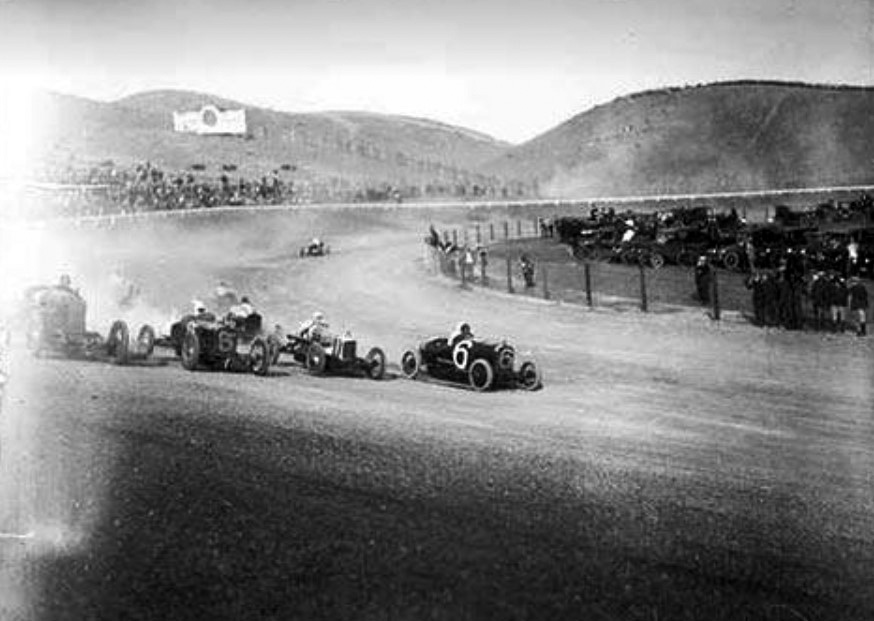 |
|
| (n.d.)^x^ - Cars make the last turn before heading into the final stretch at Legion Ascot Speedway. |
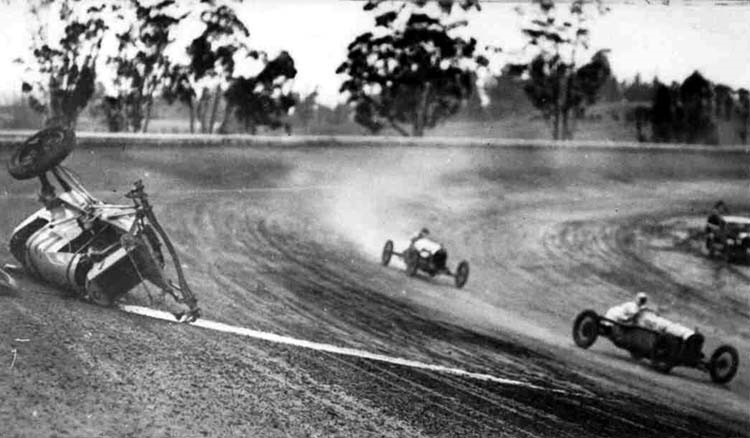 |
|
| (n.d.)^x^ - Race car crashes after losing control on one of the turns at Legion Ascot Speedway. |
Historical Notes From 1924 to 1936, a multitude of crashes resulted in loss of life. Some two dozen drivers lost their lives at Ascot.*^# |
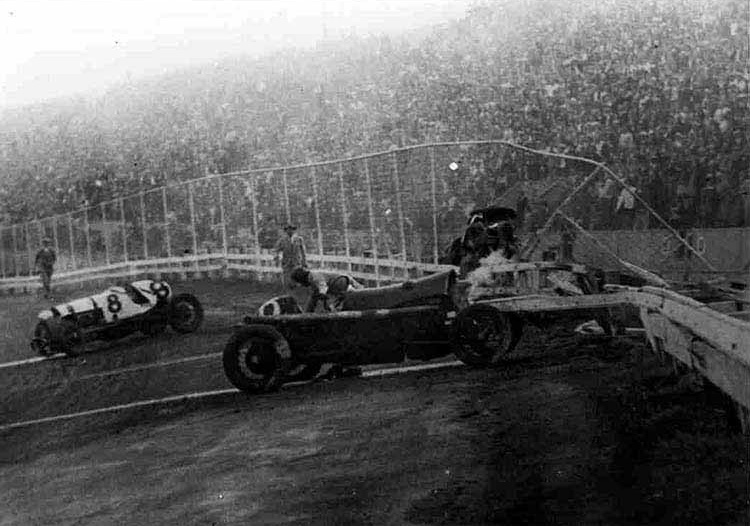 |
|
| (ca. 1930s)^x^ - More than 20 people died on what became known as the “Killer Track.” |
Historical Notes The death toll was one reason the Glendale American Legion bowed out of race promotion in early 1935---the other reason was the diminishment of crowds due to the emergence of midget auto racing at the time. Eleven years after it opened, the Ascot Legion Racetrack was shut down. Eight months later the grandstands of the abandoned speedway burned to the ground. The land was soon subdivided and sold off. Today, Multnomah Elementary School and a housing tract sit on the old Ascot Speedway site.*^# |
* * * * * |
Ince Triangle Studios/Goldwyn Studios (later Metro-Goldwyn-Mayer)
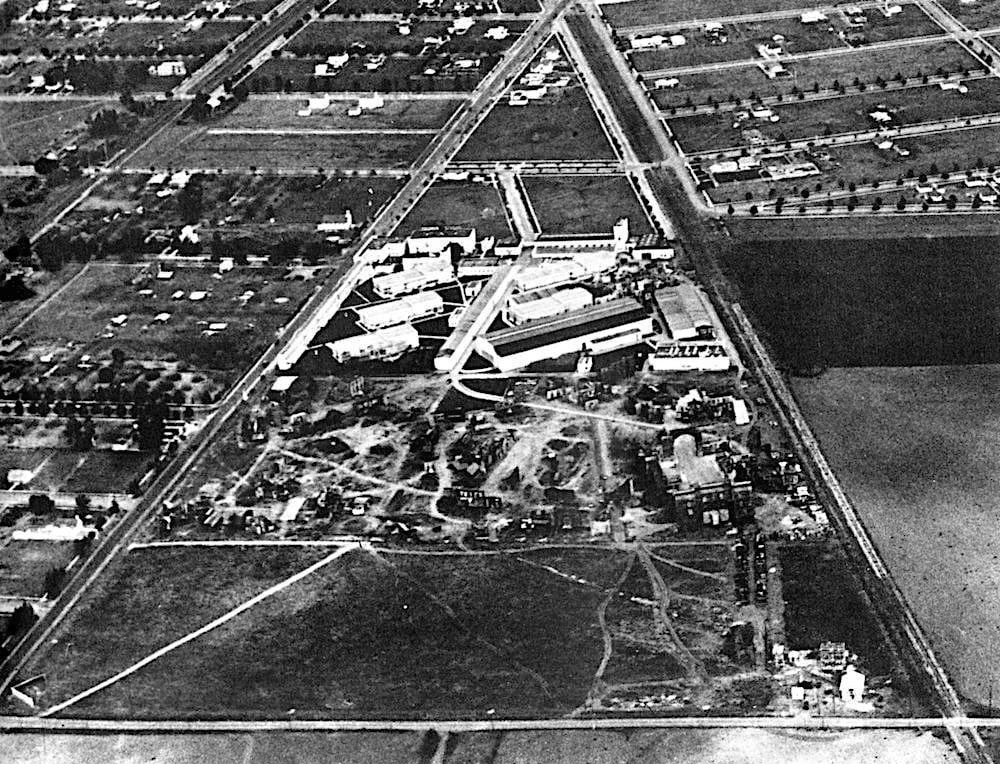 |
|
| (1920s)* – Aerial view the Triangle Motion Picture Company lot. It’s not hard to see where they got the name: the triangular shape of their studio lot bordered by Washington Blvd on the left (north), Culver Blvd on the right (south), and Overland Ave along the bottom (west). |
Historical Notes It got its start in 1915 when Harry Culver gave land to Thomas Ince to build this studio-the first in Culver City, Ince Triangle. Ince persuaded D.W. Griffith and Mack Sennett, two other luminaries of the era (and hence the "Triangle" part of the moniker), to partner with him. Ince and Sennett actually were employees of New York Motion Picture Company (also known as Kessel and Bauman (KayBee for short) and the early studio sign reflected this association. |
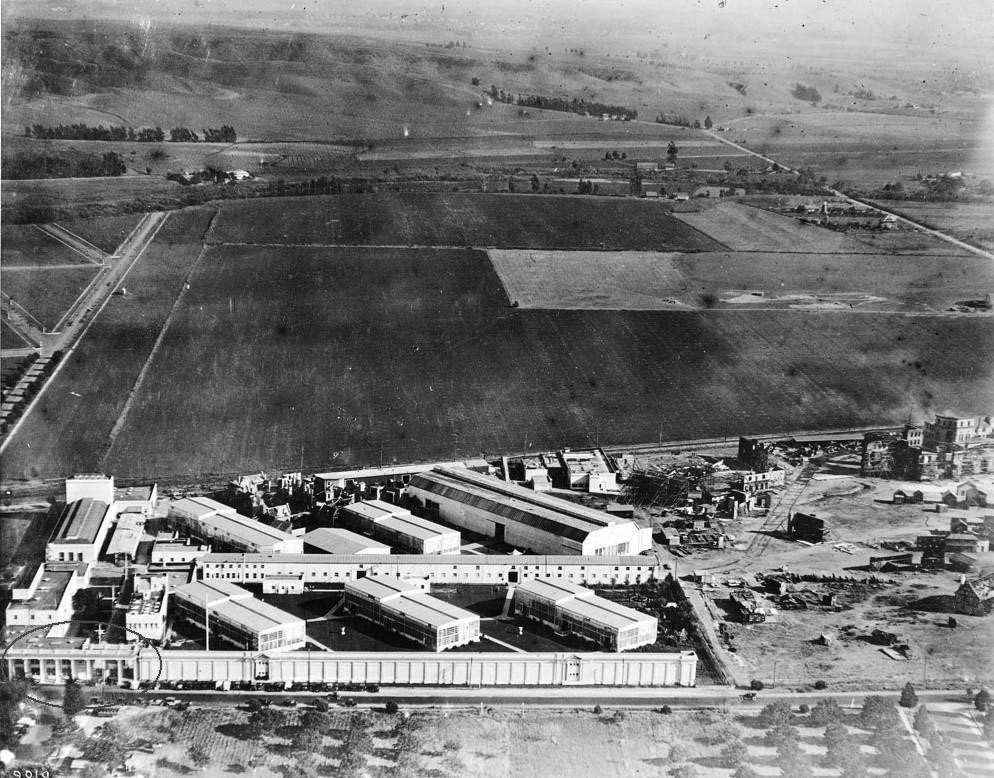 |
|
| (ca. 1920)^^ - Aerial view of the Goldwyn Studios in Culver City looking south. At the bottom of the photo is the front entrance of the studio known as the Colonnade Building. The Colonnade runs parallel to Washington Boulevard. To the right of the studio buildings is what was known as Lot #2 where sets were constructed for the many films produced at Goldwyn Studios. The Main Gate (circled) and part of the Colonnade still stand today, most everything else has been replaced. |
Historical Notes In 1919 the studio was bought by Sam Goldwyn became Goldwyn Studios, who expanded the footprint into a larger studio. In 1924 mergers and buyouts turned it into Metro-Goldwyn-Mayer, the venerable M-G-M studios. Goldwyn had been bought out, though the studio name reflected his former association. Under the guidance of Louis B. Mayer the studio was greatly expanded and eventually grew to encompass 6 lots around Culver City.* Behind the studios are empty fields which became home the the Culver City Speedway in 1924. |
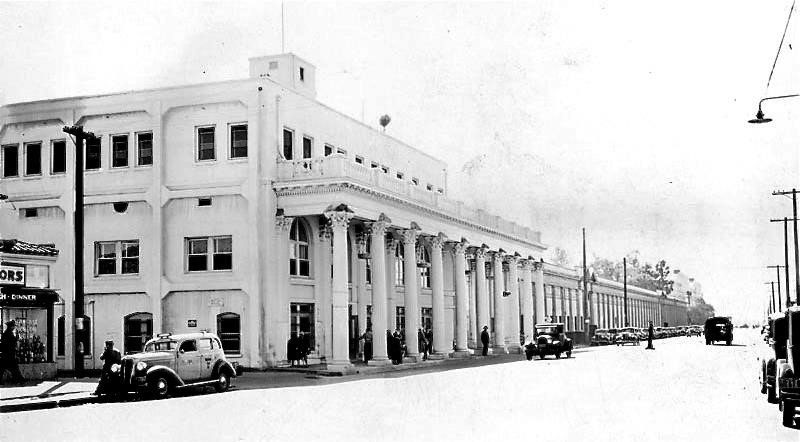 |
|
| (1938)+^^ - Metro-Goldwyn Mayer Studios main gate entrance viewed from the left side of the colonnade. |
Historical Notes The studio fell on hard times in the 1970s, and 5 of its lots were sold, along with its costume and prop departments. The lot became MGM/UA after a merger with United Artists, then was sold to Lorimar Telepictures, and in 1990 to Sony Corp,, becoming Columbia Pictures Studios (Sony having purchased Columbia and the smaller Tri Star Pictuers). After extensive renovations the studio was rechristened Sony Entertainment Studios, the name it has today.^ |
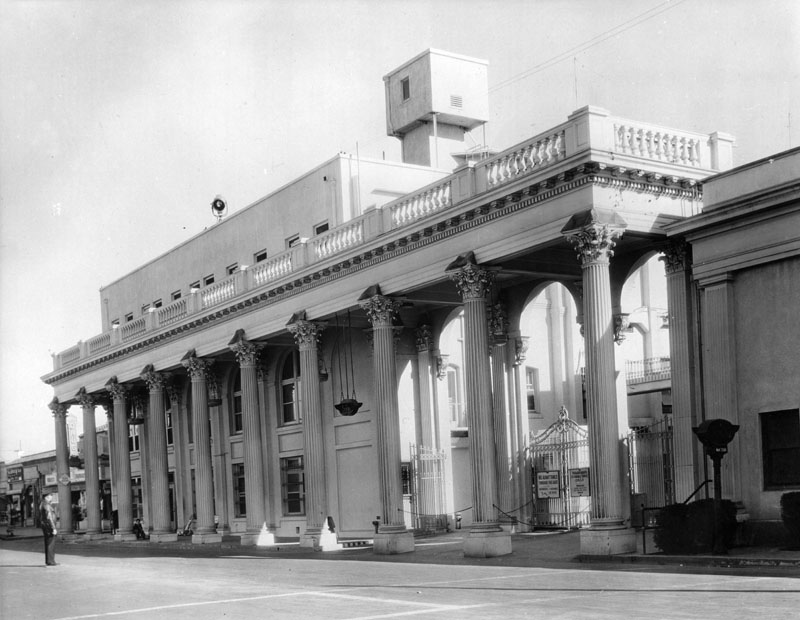 |
|
| (ca. 1920)^ - Close-up view of the Metro-Goldwyn-Mayer front entrance and main gate. |
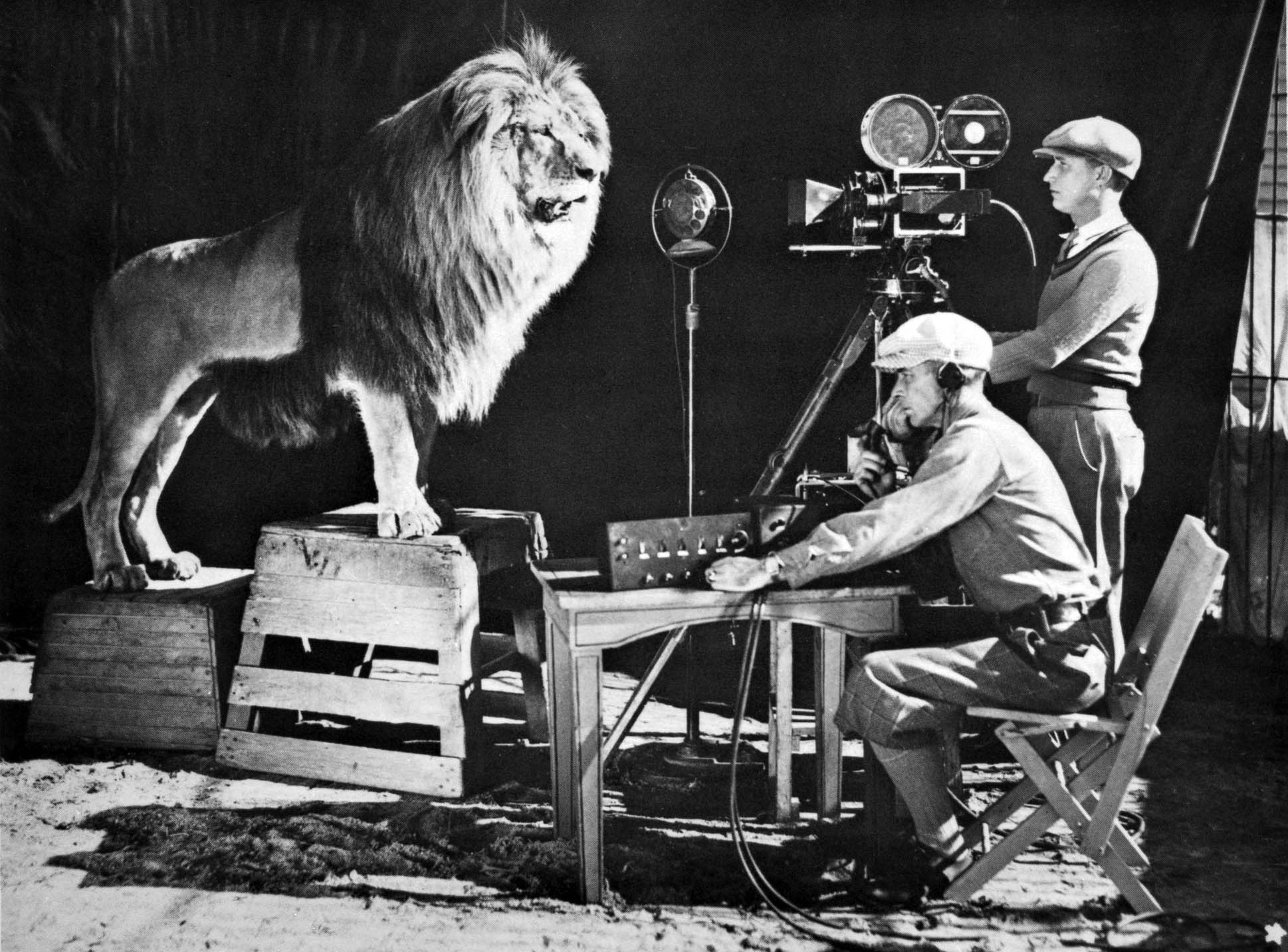 |
|
| (1928)* - MGM opening credits in the making. Yes, that's how they did it! |
Historical Notes With visionary Louis B. Mayer and production genius Irving Thalberg at the helm, MGM, with its legendary roaring lion logo, was a powerhouse of prolific artistry and filmmaking expertise. During a golden three decades from 1924 to 1954, the Culver City-based studio dominated the movie business, famously attracting "more stars than are in the heavens" and creating a Best Picture nominee at the Academy Awards every year for two straight decades. Historically, in 1939 two of MGM's most iconic films, Gone With the Wind and The Wizard of Oz, were both nominated for Best Picture. Gone With the Wind ultimately took home the Best Picture prize that year along with eight other Oscars, including one for Hattie McDaniel who won for Best Actress in a Supporting Role and became the first African American to be nominated for and win an Oscar. The Wizard of Oz would go on to secure two Oscars of its own.* |
Before and After
 |
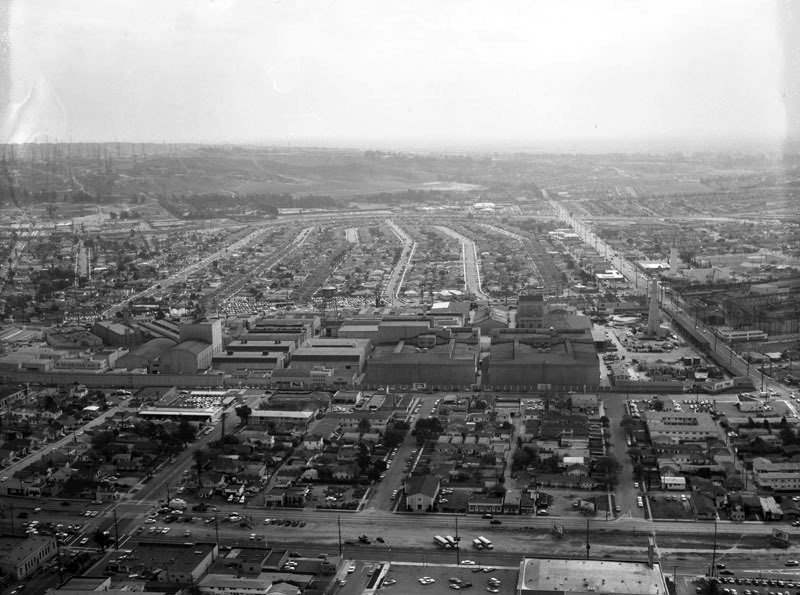 |
|
| (1918)^^ - Aerial view of the Goldwyn Studios in Culver City looking south. At the bottom of the photo is the front entrance of the studio known as the Colonnade Building. The Colonnade runs parallel to Washington Boulevard. To the right of the studio buildings is what was known as Lot #2 where sets were constructed for the many films produced at Goldwyn Studios. The Main Gate (circled) and part of the Colonnade still stand today, most everything else has been replaced. | (1960)* - Aerial view of the Metro Goldwyn Mayer Studio lot, located at 10202 Washington Boulevard in Culver City; view is looking southeast. Venice Boulevard is horizontally at foreground; Washington Boulevard is horizontally at center; Culver Boulevard is horizontally behind the studios; Overland Avenue is vertically along the right, followed by (r to l): Keystone Avenue, Mentone Avenue, Le Bourget Avenue, Motor Avenue, Vinton Avenue and Jasmine Avenue; Ballona Creek flows horizontally in the distance. |
Historical Notes The top two photos show how the Culver City landscape was transformed over the years. However, there was one intermediary development that occurred between the time that these to images were taken. It was called the Culver City Speedway. |
Ince Studios or the Pathe Exchange Studios (aka Culver Studios)
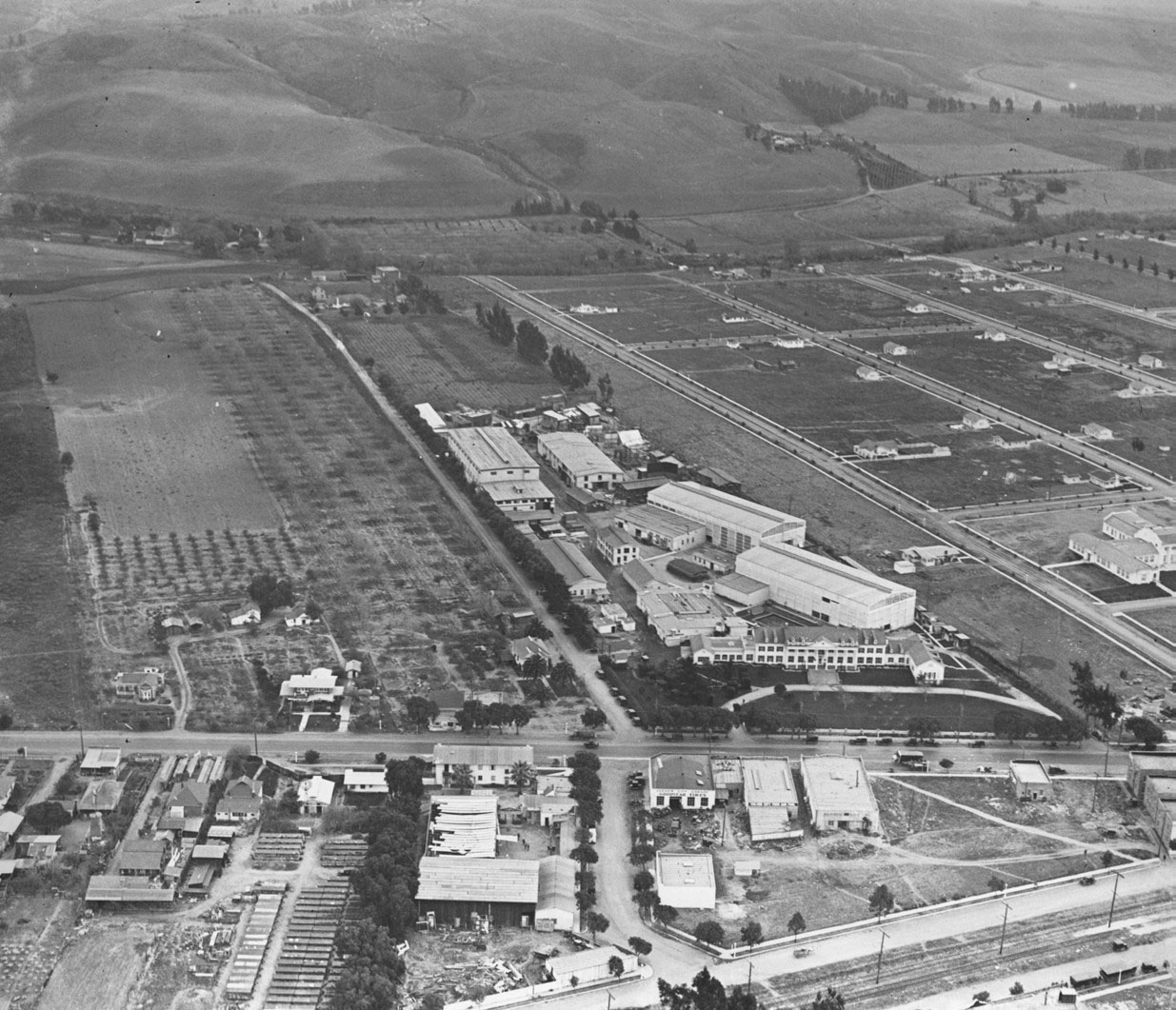 |
|
| (1920s)^ - Aerial view of Ince Studios or the Pathe Exchange Studios (also known as Culver Studios) located on 9336 Washington Blvd. in Culver City which is still rural at this time. |
Historical Notes The Culver Studios was built by Thomas H. Ince in 1918 after he acquired it from landowner Harry Culver. Meyer & Holler were the architects and construction company. The silent movie actor, director and producer had grand ambitions to create his own studio unique from all the others. * |
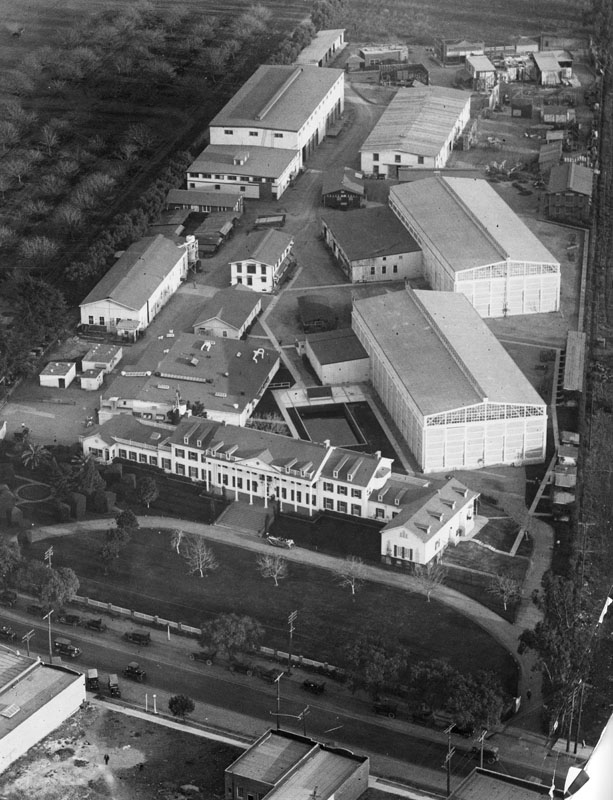 |
|
| (1920s)^ - Closer view of Ince Studios or the Pathe Exchange Studios (also known as Culver Studios) in Culver City. An elegant convertible is parked in front of the Colonial style building. Less elegant cars are in the street. Formal gardens front the Colonial Revival building that houses the offices, behind which are the actual studios. |
Historical Notes The original studio was named the Thomas H. Ince studios and became the second major motion picture concern in Culver City that is now acquired by Amazon Studios.* |
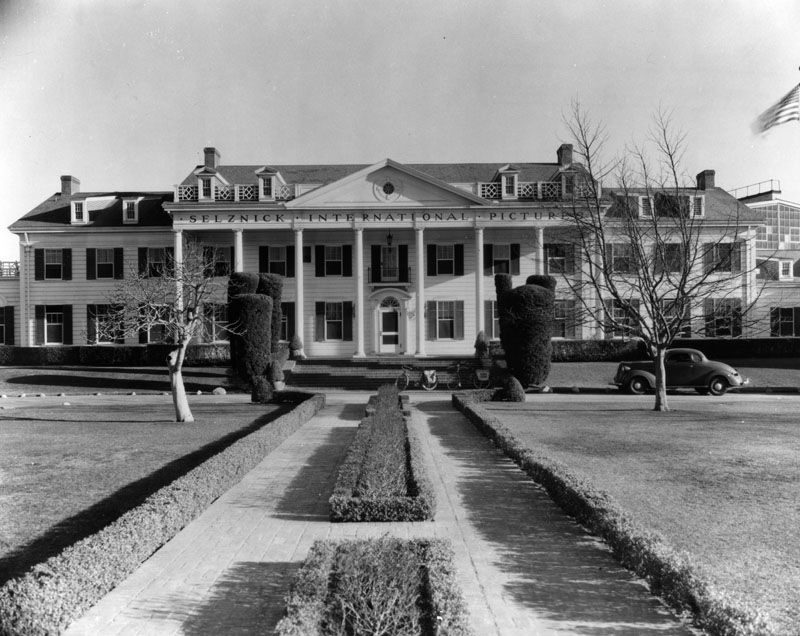 |
|
| (1935)^ - Exterior view of Selznick International Pictures offices, located on Washington Boulevard in Culver City. |
Historical Notes The picturesque mansion house is the centerpiece of Culver Studios lot and has landmark status. It is a classic example of 1920s Colonial Revival architecture and was the first building to go up on the site shortly after Thomas H. Ince's acquisition of the land in 1918. Modeled after George Washington's home at Mount Vernon, it currently serves as the main administrative building on the lot. Famous producers including Ince, Cecil B. DeMille and David O. Selznick once had offices there. One long corridor runs the length of the 15,000 square foot structure which has eight two-story high grand white columns. The facade looks out onto a manicured lawn,* |
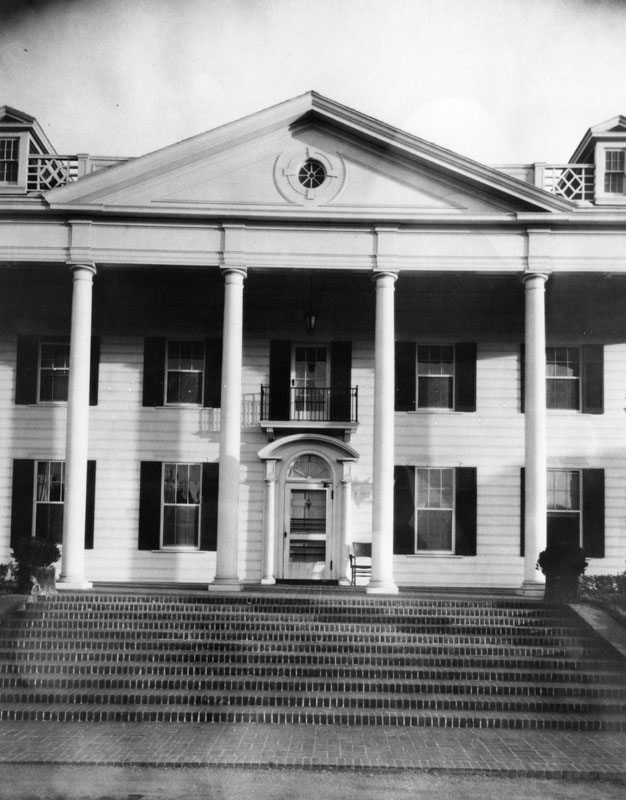 |
|
| (ca. 1930s)^#^ - Close-up view of the Colonial style Ince Studio (later Selznick International Studios) offices. |
Historical Notes There is a common misconception that the mansion house was Tara in Gone With the Wind. The building was used in the credits but Tara was a separate building constructed on the Forty Acres backlot by art director Lyle Wheeler, where the scene depicting the burning of Atlanta was filmed.* |
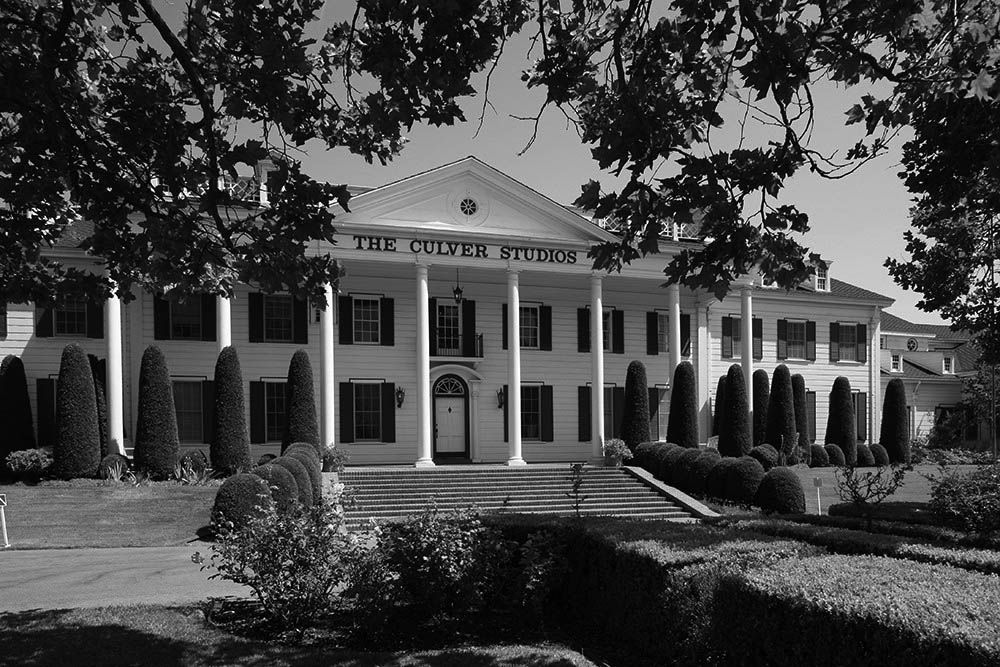 |
|
| (2013)^ – Front view of The Culver Studios. |
Historical Notes Name changes: 1919-1924, The Ince Studios; 1925-1928, Pathé Exchange Studios; 1928-1935, RKO Studios; 1935-1948, Selznick International Pictures; 1948-1955, Howard Hughes Studio; 1955-1957, General Tire and Rubber Company; 1957-1968, Desilu Studios; 1968-1969, Perfect Film and Chemical; 1969-1977, Culver City Studios; 1977-1986, Laird International Studios; 1986-1991, The Culver Studios; 1986-, Sony Corporation; As of 2019, the studio is under redevelopment, with much of the redeveloped studio to be leased by Amazon Studios. |
Culver City Speedway (1924 - 1927; aka Los Angeles Speedway)
 |
|
| (1924)^ - Aerial view of the Culver City Speedway (aka Los Angeles Speedway) looking southeast. The racetrack was located at the intersection of Culver Blvd and Overland Blvd, right across the street from MGM Studios. It operated from 1924 to 1927. |
Historical Notes Jack Prince and Art Pillsbury original built the Beverly Hills Speedway near the intersection of Wilshire and Santa Monica boulevards. It was funded by a group of actors and others in the industry known as the Beverly Hills Speedway Association. The track was inaugurated on February 28, 1920, but after only four years the 70,000-seat stadium was disassembled to make room for other improvements in the newly incorporated city of Beverly Hills.The same developers moved the racetrack to Culver City, and it was located at the intersection of Culver Blvd and Overland Blvd, right across the street from MGM Studios. It was at this "new" location and "new" track where Red Cariens was involved in a fatal crash on November 29, 1925. It was also at this location where Mickey Rooney's classic racing movie "The Big Wheel" (1949) was shot.^ |
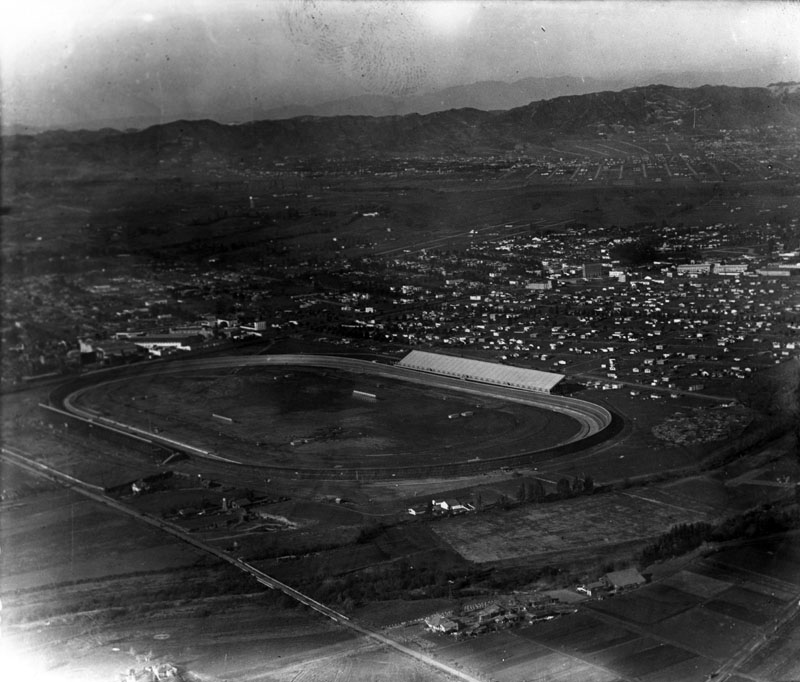 |
|
| (1924)^ - Aerial view of the Culver City Speedway looking north toward Beverly HIlls. The large, gray, slanted structure on the right of the racetrack is the grandstand, and another one appears to be directly across on the other side. Hundreds of homes are visible past the racetrack, scattered throughout the city. |
Historical Notes The site of the Culver City Speedway initially had a horse racing track in 1923, but that only lasted about a year. On December 14, 1924, it re-opened as a board racing track called the "Speedway." It was very well known, but much of the written information on it refers to it as the Los Angeles Speedway.*^ |
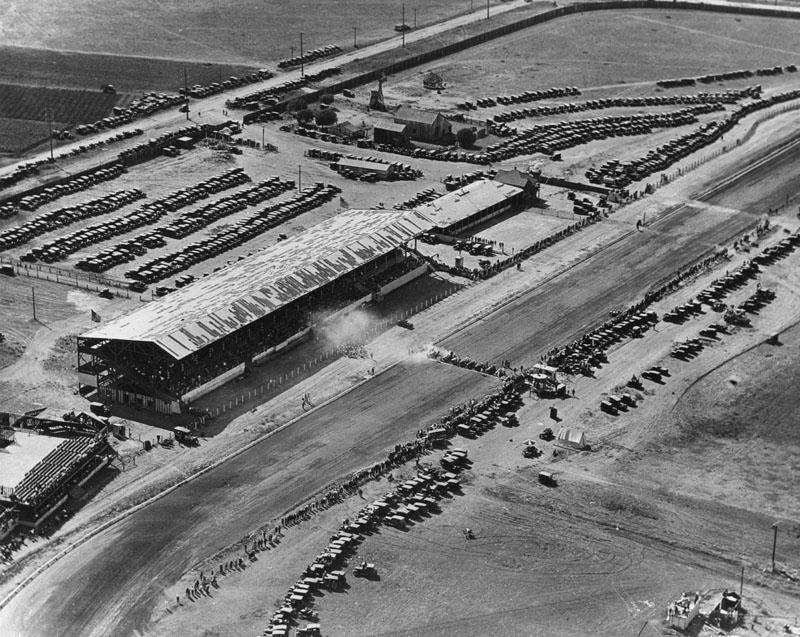 |
|
| (1924)^ - Aerial view of the Culver City Speedway showing a cluster of cars neatly aligned behind a white "hash mark" that is most likely the finish line. The large structure with multi-color tile is the grand stand and the smaller building to the right of it might be a clubhouse or restaurant under construction. |
Historical Notes The Culver City Speedway was built at a time when car races were popular, so popular in fact, that there were radio broadcasts from the speedways. California had approximately six wooden track speedways, also known as "toothpick track" speedways. Culver City Speedway operated from December 14, 1924 to March 6, 1927.^ |
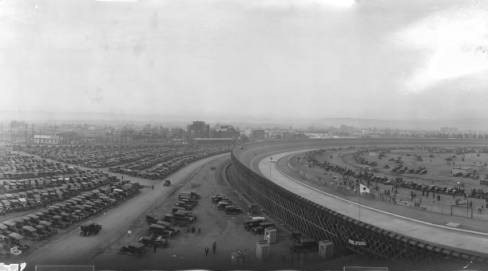 |
|
| (1924)*^#^ - View of the short-lived Culver City Speedway showing the banked board track near the corner of what are now Culver Boulevard and Overland Avenue. The adjacent parking lot is full of cars. |
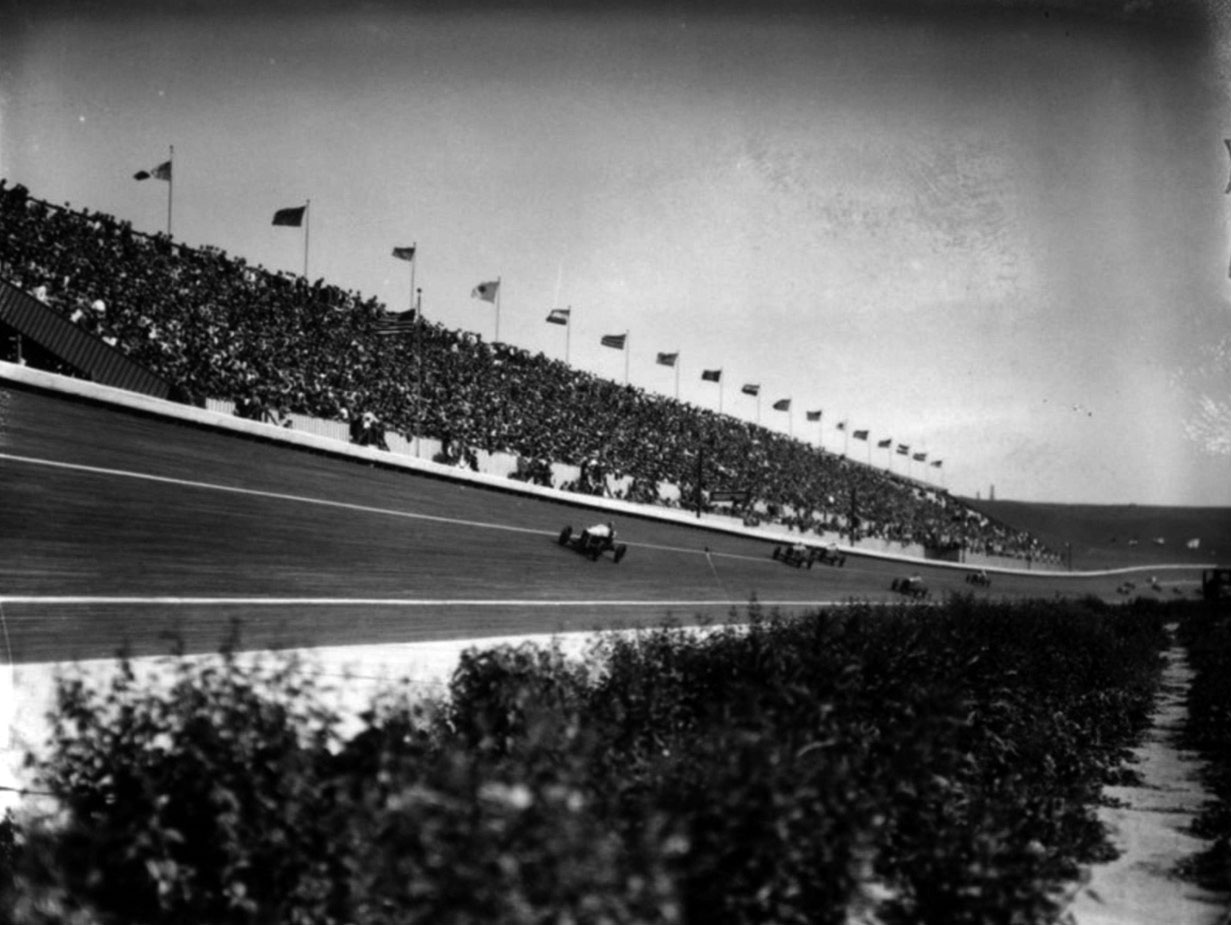 |
|
| (ca. 1927)* - Grandstand completely packed with spectators, as flags from different countries wave above at the Culver City Speedway (aka Los Angeles Speedway). |
Historical Notes This speedway was built at a time when car races were popular, so popular in fact, that there were radio broadcasts from the speedways. California had approximately six wooden track speedways, also known as "toothpick track" speedways. Culver City Speedway operated from December 14, 1924 to March 6, 1927; it was eventually removed to make way for movie studios and housing development. |
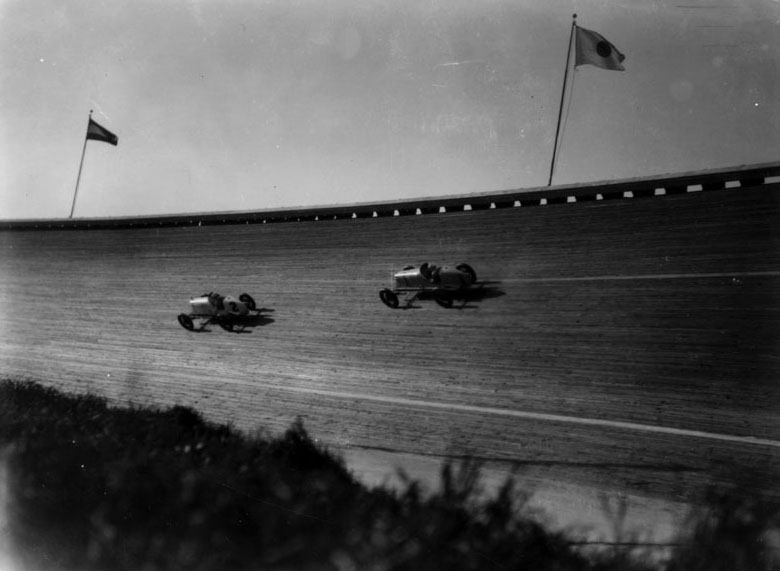 |
|
| (1927)^ - Partial view of the Culver City Speedway (also called Los Angeles Speedway), which was in existence as an auto racing venue from December 14, 1924, until March 6, 1927. This photograph shows car number 1 pursuing car number 2 on a steep bank of the track. |
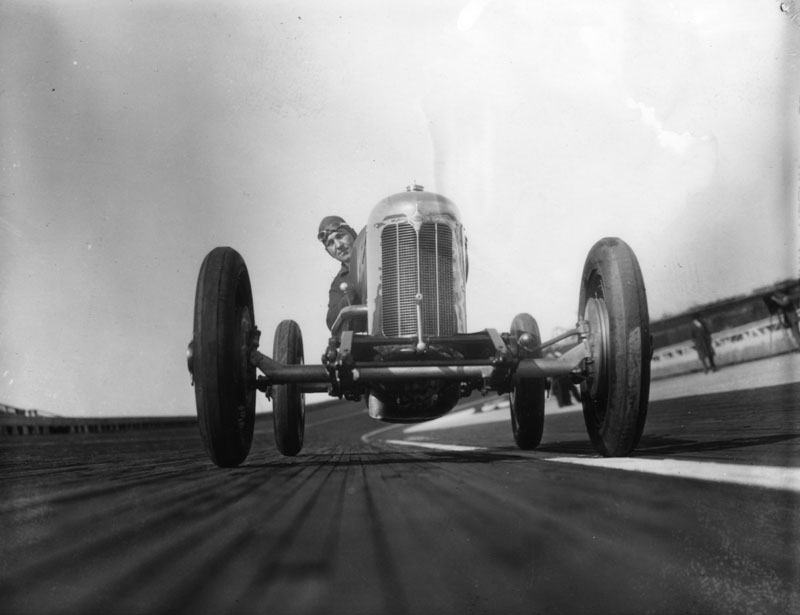 |
|
| (1927)^ - Photo taken of a driver sitting in his race car, on the Los Angeles Speedway in Culver City. |
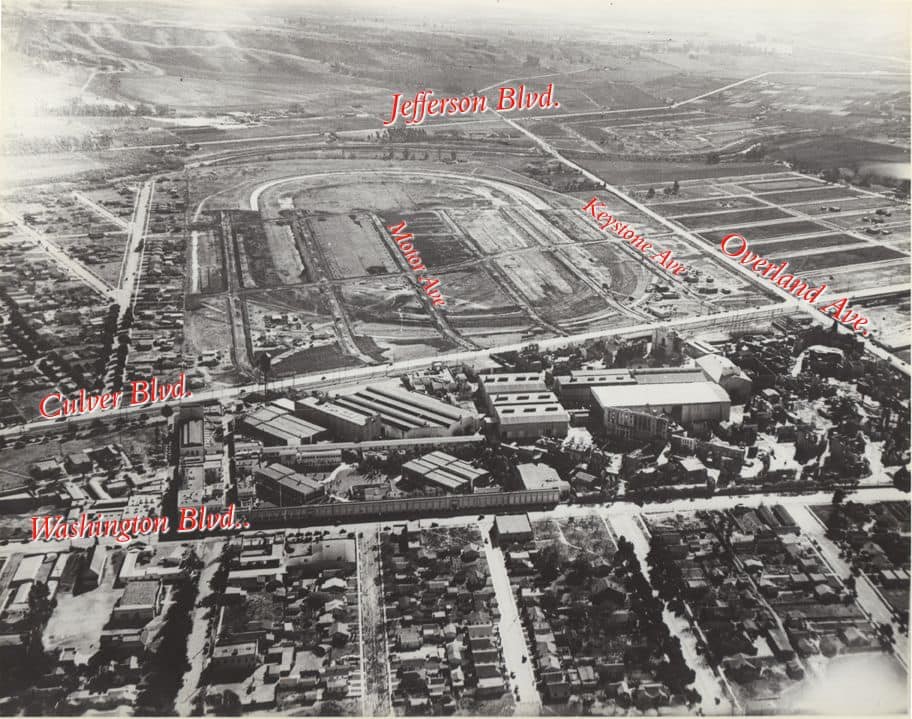 |
|
| (ca. 1927)* - Aerial view showing new development at site of the Culver City Speedway, annotated with street names. |
Historical Notes After its closing in 1927, the Culver City Speedway was eventually removed to make way for movie studios, housing and a public park.The city council approved the founding of the first park in Culver City on this land. The park was originally named Victory Park by the mayor's wife because "it was a victory to get a park", but later renamed Carlson Park. Dr. Paul Carlson, a Culver City native, was a medical missionary martyred in the former Belgian Congo.*^ |
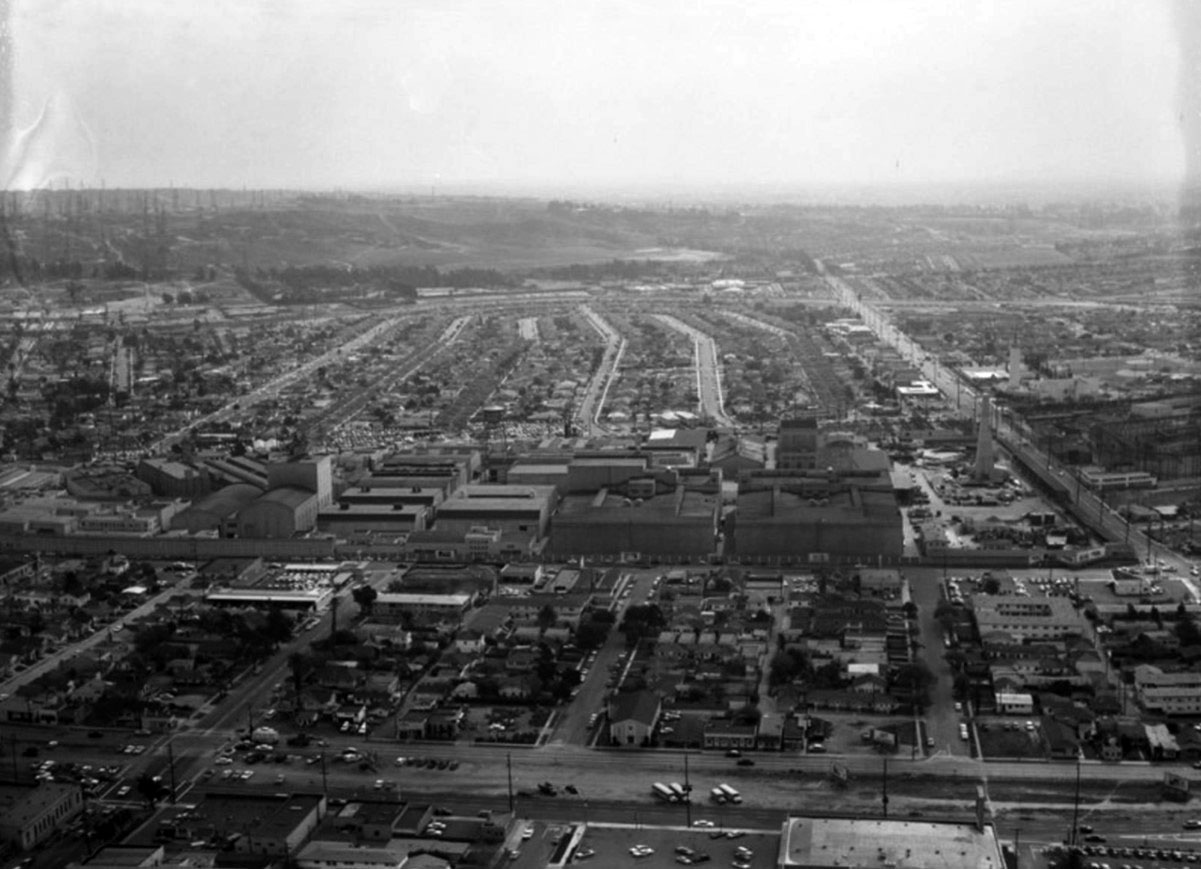 |
|
| (1960)* - Aerial view showing the old Culver City Speedway site after new housing development and expansion of the Metro Goldwyn Mayer Studio lot. |
* * * * * |
Please Support Our CauseWater and Power Associates, Inc. is a non-profit, public service organization dedicated to preserving historical records and photos. Your generosity allows us to continue to disseminate knowledge of the rich and diverse multicultural history of the greater Los Angeles area; to serve as a resource of historical information; and to assist in the preservation of the city's historic records.
|
For more Historical Los Angeles Views click one of the following:
For Other Historical Views click one of the following:
See Our Newest Sections:
To see how Water and Electricity shaped the history of Los Angeles click one of the following:
Water:
Power:
* * * * * |
References and Credits
* DWP - LA Public Library Image Archive
^ LA Public Library Image Archive
^*The Valley Observed: Street Name Origins; Timeline of Valley History
*# blogdowntown: Third Street Tunnel
+#Fairfax High School Home Page
#* About.Com: History of Electric Vehicles
#**U.S. Geological Survey Photographic Library
*##LA Times: Dig Into History You'll Find Snake Oil..Victor Girard Kleinberger
^##Metropolitan Transportation Library and Archive
*#*Historical Los Angeles Theatres: The Philharmonic Auditorium; Downtown Theatres
^#^Noirish Los Angeles - forum.skyscraperpage.com; Ince Studios; Aerial of Burbank and Hollywoodland Sign
*^#LincolnHeightsLA.com: Legion Ascot Speedway
**#KCET - Lost Tunnels of Downtown LA; Urban Surgery: Wilshire Extension; When L.A. Was a Horse-Powered Town
*#^Maureen Megowan: History of Hermosa Beach; Secrets about the Palos Verdes Peninsula
^#*City of Redondo Beach HIstory
^^*Early Downtown Los Angeles - Cory Stargel, Sarah Stargel
^^+Silverlake.org: Historic Photos
++*Los Angeles Parks: laparks.corg
*+*Los Angeles Magazine: Early Traffic Signals in Los Angeles
++^LA County Public Library: East Los Angeles
+^+LASeoulguy.com: Mulholland Drive
***Los Angeles Historic - Cultural Monuments Listing
**^Historicechopark.org: Echo Park Lake
*^*California Historical Landmarks Listing (Los Angeles)
*^^Nuestra Señora la Reina de los Ángeles: losangelespast.com
+^^Facebook: Garden of Allah Novels
^*#California State Library Image Archive
^^^Aerofiles - US Aviation Firsts
*#*#Abandoned & Little-Known Airfields – Paul Freeman
*##*Chatsworth Historical Society
**^#Historical LA Theatres: Loew's State Theatre
*^#^Huntington Digital Library Archive
##**Canyon News: Mulholland HIghway
##*#LAist.com: Why Vine Becomes Rossmore
++++Facebook.com – Los Angeles Heritage Railroad Museum
^**#Jewish Museum of the American West: Herman Silver
^*#*Before USC
^*#^Studiotour.com: William Fox Studio
^*##Calisphere: University of California Image Archive
^^##SanPedro.com: Fishing Industry
^^^#Los Angeles Fire Department Historical Archive
^^#^Facebook.com - Great Photos from Los Angeles' Past: Western Ave; Rogers Airfield
^#*^Facebook.com - Bizarre Los Angeles
^##*Pinterest: Bygone Los Angeles
***^Oviatt Library Digital Archives
**^**Retronaut - Hollywoodland Sign
*^ Wikipedia: H.J. Whitley; Occidental College; Beverly Hills; Beverly Hills Hotel; Los Angeles Railway; Pershing Square; Broadway Tunnel: Isaac Van Nuys; Sawtelle; Port of Los Angeles; Tournament of Roses Parade; Angels Flight; Occidental College; Mt. Washington, LA; Broadway, LA; Hancock Park; La Brea Tar Pits; Los Angeles City Oil Field; Deadman's Island (San Pedro); Moses Sherman; Rose Bowl Game; Hollywood Hotel; Hollywood HIgh School; California Club; San Pedro; Salt Lake Oil Field - Gilmore Oil Field; Westwood; 2nd Street Tunnel; Hermosa Beach; Los Angeles Memorial Coliseum; Redondo Beach Pier; Redondo Beach; West Hollywood; Pacific Palisades; 1910 L.A. International Air Meet at Dominguez Hills; Hancock Park; Marlborough School; Subway Terminal Building; Hollywood Bowl; Carthay Circle; Sunset Boulevard; Farmers and Merchants Bank of Los Angeles; History of Los Angeles Population Growth; Palos Verdes Estates; Palisades del Rey; Carlson Park, Culver City; St. Vincent Church; San Vicente Boulevard; Salt Lake Oil Field; Mulholland Drive/Highway
< Back
Menu
- Home
- Mission
- Museum
- Major Efforts
- Recent Newsletters
- Historical Op Ed Pieces
- Board Officers and Directors
- Mulholland/McCarthy Service Awards
- Positions on Owens Valley and the City of Los Angeles Issues
- Legislative Positions on
Water Issues
- Legislative Positions on
Energy Issues
- Membership
- Contact Us
- Search Index